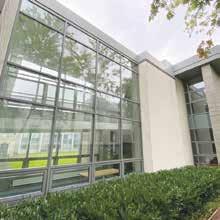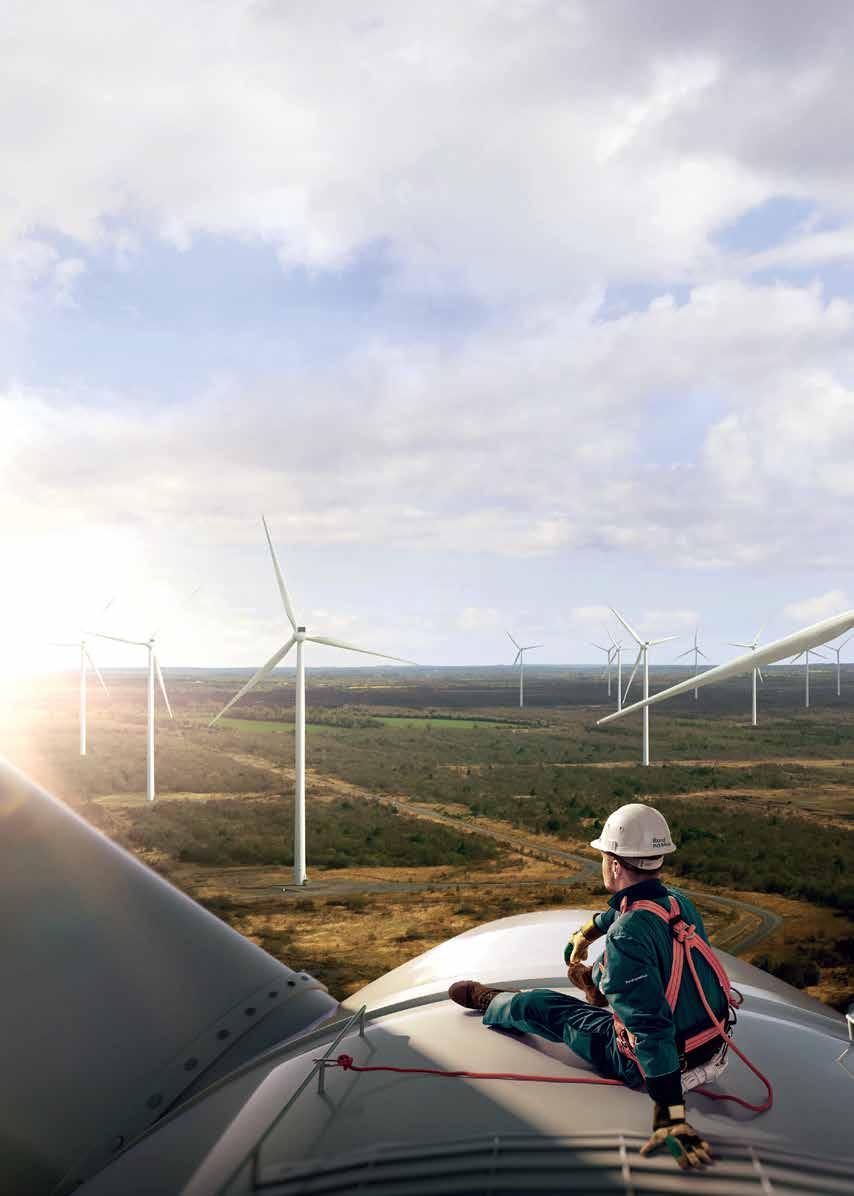Guiding the Public Sector’s Green Transition

































































































A consistent solution that always allows you to make safe, encrypted calls on a secure and reliable network.
FEATURES:
• Scalable up to 150 channels/ simultaneous calls.
• Call plan packages available.
• 24/7 Internet Connectivity and Fraud Monitoring as standard.
• Compatible with any SIP/IP PBX.
BENEFITS:
• Ensures a secure, encrypted environment for voice conversations, safeguarding sensitive information.
• Facilitates voice communication through Microsoft Teams, enhancing productivity and collaboration.
• IPSec protects the con dentiality of the data exchanged during a SIP session. This is done through encryption, authentication, and the use of secure tunnels.
Get in touch: enterprisesales@virginmedia.ie




76
Matheson
JFW
77
79
81
Ecoplex
83 EnergieXPro Set for growth in 2024
Big expansion plans in Dublin and the Far East
84 Supplying Sustainable Energy Solutions In Ireland Rexel Energy Solutions - leader in electrifying solutions
87 A Driving Force Behind Clean Energy
A smooth transition to solar
88 Ireland’s Energy Security
New strategy for Ireland’s energy security
91 Upgrading historical Buildings Guidance
New energy efficiency guidance
93 Passionate Team Award-Winning Software
Next-Gen Power offers comprehensive energy solutions
95 Insulating Ireland
Pro Spray Foam Insulations - high standards and cost-effective service
96 Hard Target
Is 2030 target beyond reach?
100 Solar Power Rises
1GW of solar capacity now connected to grid. Solar Solutions
103 with SolarSol
Solar energy solutions across Ireland
105 Solar Specialists
Helping you go green
107 Solar Revolution
Western Solar a prominent player in the solar industry.
108 Revolutionising Public Data
UrbanTide leading a transformative movement in open data
113 Expanding Housing Delivery
Diversifying and Expanding Housing Delivery
114 EML Construction
Building strong relationships and delivering excellence
116 Clúid Delivering Sustainable Social Housing Delivering social sector homes for more than 30 years.
121 The Future Is Modular
Modern Methods of Construction Report
123 A Legacy of Innovation Calnan Group: 50 Years of Innovation, Excellence, and Sustainable Growth
125 Munster Joinery
Celebrating 50 years in business
127 Senator Windows retrofitting windows and doors
129 Furniture with passion
Combining tradition, quality and innovation
130 RNLI 200th anniversary
The Royal National Lifeboat Institution turns 200
132 Dublin port
Newly redeveloped RoRo freight terminal in Dublin Port
134 Dún Laoghaire Harbour
New Harbour master plan & National Watersports Campus
137 Plain Sailing
Record-breaking cargo for Port of Waterford
139 Irish Rail
On Track Towards a Sustainable Future
142 Egis making a national impact
Delivering innovative, effective and long-lasting rail solutions
144 Cutting Edge Coatings Solutions
BDM Coatings - Transforming Industries

Marking International Women’s Day 2024 in the Custom House, Mr Kieran O’Donnell, Minister of State for Local Government and Planning, unveiled a new work by artist and former Leitrim County Councillor, Sinéad Guckian, as part of the Department of Housing, Local Government and Heritage’s International Women’s Day celebrations.
The painting was commissioned by the Department-supported WoMeN’s Regional Caucus, a group of 13 constituent member local authorities where there are insufficient numbers of women councillors to form a meaningful caucus at the county level.
The work was commissioned in response to the Caucus’ International Women’s Day events last year which saw the member councils host events to reverse the gender of their chambers, to visually highlight the enduring inequalities in local politics. Ms. Guckian’s work intends to both capture the enthusiasm and accomplishments of the 2023 events, as well as to stand in lasting recognition of the work of both the Caucus and the Department in furthering the cause of women in local government.
The artist was selected by the caucus as a former Councillor of Leitrim County Council, with personal insight into the experience of women in Irish local government. Sinéad Guckian is also no stranger to displaying her work in prestigious public spaces - a portrait by the artist of Elizabeth O’Farrell during
the 1916 surrender hangs in the Seanad chamber.
Speaking at the event, the Minister O’Donnell said: “This piece of art embodies the idea of ‘Inspire Inclusion’, the theme of International Women’s Day 2024 and indeed the work my Department and I have undertaken in recent years to encourage greater inclusion of women in local government.
“There is still an underrepresentation of women and people of diversity in council chambers across the country, which does not reflect the rich makeup of our modern country. However, we have worked hard in recent years to encourage greater participation of women and those from diverse backgrounds in local politics.
“We want to make the role of councillor more accessible for all, and to reduce the barriers to participation in local government through initiatives funded by my Department and new measures such as the introduction of maternity leave for councillors in 2022 and additional administrative maternity supports provided last year”.
“I hope that, through our collective efforts, we can all “Inspire Inclusion”, and hopefully see more women on the ballot paper this coming June and many more women taking their rightful places in our council chambers.”
The public will be able to view the painting in the Custom House Visitor Centre in the coming months.
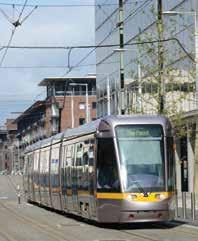
SIPTU has launched the ‘Respect Transport Workers’ campaign to demand greater safeguards for staff on bus, rail and Luas networks following a survey by the Union that revealed more than 80% suffered regular incidents of abuse.
Launching the campaign in Liberty Hall in Dublin, SIPTU TEAC Division Organiser, Adrian Kane, said: “SIPTU members employed within public transport provide a vital service to our communities. They should never be the subject of abuse during the course of their work.
“Unfortunately, a survey conducted by our Union of members employed in the Transport Sector has revealed the grim reality that a large number, in excess of 83%, felt that abuse and anti-social behaviour was an issue for them at work.”
He added: “One in five of the survey respondents said they experienced these issues on a daily basis with a further third saying that incidents occurred at least once every working week. The majority of those who have endured abuse at their job believe the problem has got worse in the last 12 months.”
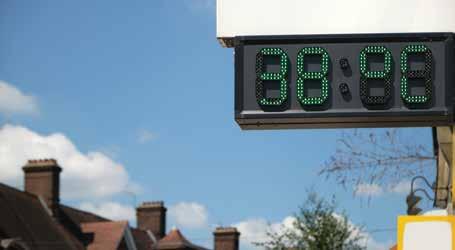
A new European Union study has warned that Europe could suffer “catastrophic” consequences from climate change if it fails to take urgent and decisive action to adapt to risks.
Areas in southern Europe are most at risk, the European Environment Agency (EEA) said in its first report on the climate risks the continent faces. The dangers include fires, water shortages and their effects on agricultural production, while low-lying coastal regions face threats of flooding, erosion and saltwater intrusion.
“Many of these risks have already reached critical levels and could become catastrophic without urgent and decisive
action,” the agency said.
That does not mean northern Europe is spared the negative impact, as floods in Germany and forest fires in Sweden have demonstrated in recent years.
“Extreme heat, drought, wildfires, and flooding, as experienced in recent years, will worsen in Europe even under optimistic global warming scenarios and affect living conditions throughout the continent,” the EEA warned.
The report lists 36 risks related to climate in Europe, 21 of which demand more immediate action and eight were “particularly urgent”. At the top of the list were risks to ecosystems, mainly relating to coastal and marine ones.
Figures from the Central Statistics Office show that the rate of household saving fell slightly in the last three months of 2023 and in the year as a whole as inflation continued to drive consumption during the year.
The figures show that the Household Saving Rate eased to 10.19% in the fourth quarter of 2023, down a little from 10.47% the previous quarter and the third successive quarter in which the rate has declined.
The CSO said that as spending accelerated faster than incomes, the
saving rate fell from 12% in 2022 to 11% in 2023.
Households saved a total of €207m in the last three months of the year and the CSO noted that before adjusting for seasonality or inflation, the last quarter of the year usually sees saving at its lowest level as people’s spending generally increases for the Christmas season.

The CSO figures also show that households added €16.8 billion in saving to their wealth in 2023, compared to €17.6 billion in 2022.

Local Authority Waters Programme (LAWPRO) has launched a nationwide photo competition: “My Favourite Waterbody”. LAWPRO is a national shared service working on behalf of the 31 local authorities in Ireland coordinating efforts to achieve good water quality across the country.
Speaking at the competition launch, Anthony Coleman, Director of Services at LAWPRO said: “I am delighted to launch this nationwide competition to find out people’s favourite waterbodies.
Ireland is bountiful with iconic waterways and scenic landscapes, and we know how important these waters and wetlands are to people. We want you to take part by submitting a photo of your favourite waterbody to be in with a chance of winning a prize”.
The competition is open to anyone across Ireland, entrants under 18 years of age must be submitted by a parent/ guardian. If your photo includes anyone aged under 16 years of age, only a parent/guardian may submit the content. The overall winner will receive a €500 voucher for Powerscourt Hotel Resort and Spa in Co Wicklow along with an A3 framed print of your winning photo and there will also be regional prizes of framed prints.
The top photos will be featured in LAWPRO’s 2025 calendar and winners will receive a calendar along with their prize.
Fingal County Council has announced that almost 500 Affordable Homes will be made available for purchase across the county in the coming months.
The Council has already provided 104 affordable homes in Lusk, Rush and Balbriggan which are either sold or at the sale agreed stage and will bring a further 492 homes in Mulhuddart, Donabate, Hollystown, Rush, Balgriffin, Lusk and Swords to market over the next eight weeks.
Minister for Housing, Local Government and Heritage, Darragh O’Brien, who recently joined the Mayor of Fingal and Taoiseach Leo Varadkar to turn the first sod on the development at Church Fields in Mulhuddart, also welcomed the increase in the availability of affordable housing in Fingal.
“I am delighted to see Fingal County Council delivering more and more affordable housing to market over the coming months. These developments, spread all across North County Dublin, will ensure affordable options are available to people so that they can put down their roots and own their forever home. I would encourage anybody interested in the affordable housing option – a house of your own at a discounted rate for those who qualify - to engage with the Council.
“This strong local pipeline of affordable housing is a great example of how our plan, Housing for All, is working at local level throughout our communities and is delivering a strong pipeline of housing of all types to the market over the coming months.


“We will only deal with the challenges we face in housing by increasing supply and growing our pipeline of future housing. Last year, the overall number of new homes delivered nationally was the highest in fifteen years, with almost 32,700 new homes completed. The current pipeline is also strong with 32,800 new homes commencing construction in 2023. This is good news for Ireland and for Fingal and I am determined to increase the momentum we have now created.”
The Affordable Housing Scheme gives people an opportunity to buy a house at a reduced price if they are unable to bridge the gap between their mortgage and deposit and the full price of the home. The Council
The Office of Public Works has announced the reopening of heritage sites across Ireland from 16 March 2024. The new season offers a great opportunity for visitors to rediscover the rich and diverse cultural heritage of their local areas.
Heritage sites are an important part of our national identity and our shared history, and they offer a unique insight into the lives and stories of our ancestors. Whether you are interested in ancient monuments, historic houses, gardens, or museums, there is something for
everyone to explore and appreciate.
In its “Jewels of History” campaign, the Office of Public Works seeks to highlight jewels across the country and lesser-known locations such as Parkes Castle Co Leitrim and Doneraile Co Cork.
The campaign also seeks to highlight the “Free Wednesday” initiative- on the first Wednesday of each month many OPW Heritage Sites offer free admission to individual visitors and families. Tickets will be allocated on a first come, first served basis and online booking
makes up the difference by taking an equity share in the home which can be bought out by the purchaser at a time of their choosing.
If the purchaser chooses not to redeem the equity share while living in the home, the Council can do so when the property is sold, transferred, or after the death of the owner.
Further details, including information on eligibility and documentation required, are available at www.fingal.ie/affordablehomes.

will not be available. Normal conditions of admission apply. Participating sites include Rathfarnham Castle, Trim Castle, Glendalough and many others and a full list is available at https://heritageireland. ie/visit/free-wednesday/
Setanta Vehicle Sales’ Award-Winning Journey with Renault Trucks’ Electric E-Tech Range of Vehicles and the Versatile Renault Master Tipper
In a world where sustainability is becoming increasingly important, Setanta Trucks is leading the way in Ireland, focusing on innovation and safety standards. They were honored with the 2024 Excellence in Business Awards for their work in Fleet Solutions, Sustainability, Reliability, & Innovation. This recognition highlights their dedication to surpassing the evolving needs of transportation. Their remarkable products, including the groundbreaking E-Tech range and the adaptable Renault Master Tipper, are particularly noteworthy.
The E-Tech range from Renault Trucks, showcasing the Master and Trafic Electric models, represents Setanta Trucks’ commitment to an environmentally conscious future. Boasting a 200 km driving range and quick charging capabilities, the E-Tech Master and Trafic prioritize efficiency and ecofriendliness. Both the E-Tech LCV Range and its companions signify the transition towards zero carbon emissions. Their cutting-edge electric power systems not only provide an option but also excel in performance, dependability, and cost efficiency, making them an attractive choice for businesses seeking to reduce their environmental impact without sacrificing quality.
The 2024 Renault Master Tipper is an example of design crafted to meet the diverse needs of businesses. With its built-in tipping body, dual rear-wheel drive, and a range of driver assistance features like air conditioning, cruise control, and a reverse camera, it shows a dedication to both performance and safety. Equipped with a tow bar and backed by a 3-year or 160,000 km warranty, the Renault Master Tipper proves itself as a workhorse that’s prepared to handle the challenges of industries with exceptional efficiency.
The 2024 Business Excellence Award holds significance for Setanta Trucks, other than being a trophy on display. It symbolizes the company’s dedication to achieving excellence.



The acknowledgment from The Public Sector Magazine highlights Setanta Trucks’ success in providing cutting-edge, eco-friendly fleet services. The award, depicted in pictures, stands as a representation of Setanta Trucks’ top-tier practices, their emphasis on quality, and their efforts towards promoting environmentally friendly transportation options.
Setanta Trucks is not just following the changes, in the industry; they are actively influencing its future. With a focus on sustainability, innovation and excellence Setanta Trucks welcomes you to be part of their journey, towards an eco-friendly and efficient future. Explore the E- Tech range and experience the versatile Renault Master Tipper. Stop by Setanta Trucks today book a demonstration or get in touch to discover how we can customize our fleet solutions to suit your requirements propelling your business towards an friendly tomorrow.
Three quarters of Irish consumers feel they are doing as much as they can, within their means, to be sustainable, a new survey from EY has found.
The research also discovered that more than half of Irish households think energy providers and Government should take the leading role in the shift to cleaner energy and just over one in five believe individual consumers should be leading.
While in a sign of the pressure that people are under from the higher cost of living, 69% of Irish respondents said they can’t absorb a bill increase of 10%.
“After a number of years of spiking energy prices due to the conflict in Ukraine, combined with cost-of-living challenges facing many, it’s not surprising that Irish households feel that they are not in a position to do more on energy sustainability,” said Sean Casey, Energy & Infrastructure Consulting Leader at EY, which conducted the study among 1,042 respondents in Ireland.
“Our research finds that the majority of Irish consumers say that they’ve already done everything they can, with only three in ten feeling they can do more to be more sustainable.”
Mr Casey added that the situation poses a significant challenge as we move towards the next critical phase of meeting climate change commitments.


Minister for Public Expenditure, NPD Delivery and Reform, Paschal Donohoe has provided his support for retirement age increase measures, which will assist in recruiting and retaining valuable expertise in the uniformed services.
Proposed increases to the mandatory retirement ages of uniformed public servants will be facilitated under the Department’s fast accrual pension policy, which will provide the option to members to remain in service if they choose to do so.
Under the changes being made to the fast accrual policy framework, fast accruals will be facilitated until age 60; if an individual remains in employment beyond age 60, their pension accrual reverts from a fast accrual to a standard accrual basis. The policy will allow for increased mandatory retirement ages to be adopted in the uniformed services and aims to address operational need in an equitable and sustainable manner.
Minister Donohoe said: “In recent years, there have been a number of requests to increase mandatory retirement ages for uniformed public servants. Changes in retirement ages
The research also found a generation gap when it comes to the Irish consumers’ willingness to pay more for more sustainable energy. A third of Gen Z respondents said they were willing to pay a premium, significantly ahead of the 20% of Millenials, the 14% of Gen X and 15% of Boomers.
More than seven in ten Irish consumers also reported that they offset their positive energy actions with negative actions and behaviours, like replacing an appliance/device with a new one and continuing to also use the old one.
“This challenge is compounded by the fact that the consumption of a good or service often increases as prices fall –meaning that the rapid gains in terms of sustainable energy entering the grid in the past decade will be outweighed by increased energy demand overall,” said Mr Casey.
“It’s imperative therefore that we redouble efforts to educate and support households to reduce energy use where possible.”
EY said there is now a significant opportunity for energy companies to close the gap between consumer interest and action on sustainability.
are a matter for the line Minister. In the context of increases to mandatory retirement ages, it is my role as Minister for Public Expenditure, NPD Delivery and Reform to sanction the impact to pay and pensions.
“I fully support increases to the retirement ages in the uniformed services. The changes proposed by the respective Ministers, facilitated by my department will enhance the options available to members of the uniformed services, and allow them to remain in service for longer if they choose to do so.
“People are living longer, healthier lives and providing additional certainty in terms of retirement ages in the uniformed services is timely and appropriate. I fully support increases to the retirement ages in the uniformed services and the Department’s fast accrual policy will enable this.”
Protecting Corncrakes on the Aran Islands, Sand Martins in the Midlands and a 11acre island Nature Reserve on the River Nore are among 78 new community plans being supported through a partnership between philanthropy and Government.
Each local project will be receiving access to experts to either develop a new Community Biodiversity Action Plan (CBAP) or support to implement measures from an existing plan.
The grants are the latest in a joint Biodiversity Fund, an initiative of the Community Foundation Ireland and the National Parks and Wildlife Service which has seen 213 such action plans developed across the country through a joint investment of €1.76 Million since 2019. Completed CBAPs can be viewed at www. actionforbiodiversity.ie.
Announcing the grants, Minister of State for Nature, Heritage and Electoral

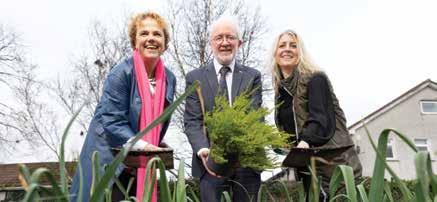
Reform, Malcolm Noonan said these grants are uniquely impactful because they connect community groups with scientific expertise, helping them to better understand their local biodiversity.
“Successful grantees work with ecologists to create a Community Biodiversity Action Plan and can then seek funding to implement it. All of the data they collect is shared with the National Biodiversity Data Centre, making a
valuable contribution to citizen science in Ireland,” he said.
“This partnership between the National Parks and Wildlife Service and Community Foundation Ireland began as a ‘Seed for Nature’ at the 2019 National Biodiversity Conference, so it’s particularly special to see it flourish and deliver so much impact all across the country, with 213 CBAPs in place and more to come.”

One of the Great Lighthouses of Ireland Standing between idyllic Lough Swilly and Mulroy Bay overlooking the rugged Wild Atlantic in Donegal, Fanad Lighthouse has been voted one of the most beautiful lighthouses in the world.
• Enjoy a tour, step back in time, hear stories about light-keepers in days gone by and climb to the top of the tower for spectacular 360 views of North Donegal, the Wild Atlantic Ocean and Lough Swilly
• For an Exhilarating Adventure, try our new Virtual Reality Experience ‘The Storm, The Sea, The Saldanha’
• Éist Audio Experience at Fanad Lighthouse: Take time to appreciate the coastal spectacle that unfolds in this space while you absorb the stories and sounds of generations of life in a Gaeltacht lighthouse in a unique location.
CONTACT US
• Amharc Marine Watch Station – our newest addition to the Lighthouse Experience. Come in, relax and watch out for Marine Wildlife through the large open watch room right on the edge of the stunning cliffs. A great space to learn all about what marine and wild life can be found on our coastline along with an interactive informaton screen.
• Mobile Audio Guides also available in several languages.
• Stay in one of our beautifully restored lighthouse keepers’ cottages
Teach Solais Fhánada, Cionn Fhánada, Co.Dhún na nGall, Éire. F92VC2N
Bookings at: www.fanadlighthouse.com
Telephone: +353 74 9116020
Guided Tour: 1hour
Suggested Visit Time: 1.5hrs – 2hours
Guided tours available in Irish.











At Certa, we are working to help our customers transition to a cleaner, low-carbon future.
With this in mind, we are introducing Certa HVO, Ireland’s newest sustainable alternative fuel. HVO delivers an instant reduction of CO 2 emissions without changes to engine infrastructure or machinery. It is a 100% drop-in replacement for diesel.
To find out more contact our HVO specialist Laura at: laura.byrne@certaireland.ie




Ireland’s hair restoration sector continues to boom with advanced techniques

Hair restoration continues to be an increasingly sought-after solution for individuals experiencing hair loss or thinning. The quest for a full head of hair has led to the development of various hair restoration techniques, from surgical procedures to non-invasive treatments.
One of the most well-known and effective methods of hair restoration is hair transplantation. In Ireland, specialised clinics and surgeons are offering advanced techniques such as Follicular Unit Transplantation (FUT). This procedure involves the extraction of hair follicles from a donor area (usually the back of the head) and their transplantation into the areas where hair loss has occurred. The precision involved in this type of surgery has significantly improved over the years, providing natural-looking results.
For those who prefer non-invasive alternatives, there are several non-surgical options available in Ireland. Platelet-rich plasma (PRP) therapy is gaining popularity, involving the injection of a patient’s own plasma into the scalp to stimulate hair follicles and promote hair growth. Laser Hair Growth Regeneration Therapy (LHGR) is another non-surgical option, utilizing lasers or light-emitting diodes to stimulate hair follicles and improve blood circulation in the scalp.
Scalp Micropigmentation is another treatment option for men and women suffering from hair loss. This treatment involves the deposit of ink pigments on the scalp to create the illusion of hair follicles and can be used to create a buzz-cut look, create density, and also camouflage scars. This treatment does not involve replacing or transplanting hair but instead, the dots of layered pigments create the illusion of natural hair follicles.
Before embarking on any hair restoration journey, individuals should consider various factors. Factors such as the extent of hair loss, overall health, budget, and personal preferences play a role in determining the most suitable
“The boom in demand for hair transplants in Ireland shows men are becoming more comfortable with self-care.”
approach. Many reputable clinics in Ireland offer initial consultations where experienced professionals assess the individual’s condition and provide tailored recommendations.
Hair loss can have a profound impact on an individual’s self-esteem and mental well-being. Recognizing the psychological aspect of hair restoration, many clinics in Ireland prioritize holistic approaches to address not only the physical aspects of hair loss but also the emotional impact. Supportive and empathetic staff contribute to creating a positive and encouraging environment for individuals seeking hair restoration services.
Former Miss Ireland, Pamela Uba made the headlines in 2023 when she opened up about her long emotional struggle with alopecia and her decision to undergo hair restoration treatment.
Presenter and influencer James Kavanagh also spoke openly about his experience with a hair restoration procedure saying: “The boom in demand for hair transplants in Ireland shows men are becoming more comfortable with self-care.”
TV star Daithí O’Se is another strong advocate of the procedure and expressed his delight with his new head of hair after undergoing treatment in 2022.
Advancements in technology continue to influence the field of hair restoration. Robotics and artificial intelligence have been integrated into some surgical procedures, enhancing precision and minimizing scarring. These technological innovations contribute to more efficient and effective hair restoration processes.
As awareness grows and technology advances, the hair restoration sector in Ireland looks to have a promising future. Ongoing research into new techniques, treatments, and pharmaceutical interventions provides hope for further breakthroughs in the field. The emphasis on personalized, patientcentric approaches ensures that individuals seeking hair restoration in Ireland have a range of options tailored to their unique needs.

MHR Clinic Ireland is an award-winning clinic based in the heart of Dublin. It is a world leader in hair transplantation offering non-invasive procedures, supplementary therapies and medical treatments to achieve natural-looking results for both men and women experiencing hair loss.
At the esteemed MHR Clinic, the mission revolves around instilling confidence through groundbreaking hair restoration solutions. MHR Clinic’s commitment to comprehensive hair rejuvenation encompasses a range of cutting-edge services tailored to address diverse needs.
MHR Clinic takes pride in introducing the revolutionary Sapphire FUE (Follicular Unit Extraction) technique. This innovative approach utilises sapphire blades, ensuring unparalleled precision in the extraction process. The result is not only faster healing and reduced scarring but also a discreet and comfortable recovery for individuals seeking transformative experiences.
Embracing the forefront of medical advancements, MHR Clinic offers PRP Therapy for hair loss. This procedure involves utilising the patient’s platelets to stimulate hair follicle growth, providing a natural and effective solution to combat hair loss.
Understanding the impact of hair loss on one’s confidence, MHR Clinic offers Scalp Micropigmentation—a cosmetic procedure often referred to as a hair tattoo. This technique creates an illusion of fuller hair, contributing to enhanced aesthetic appeal and boosting self-esteem.
MHR Clinic recognises the significance of laser technology in promoting hair growth. The clinic’s Laser Hair Growth



MHR Clinic’s recent expansion to a larger facility on Dawson Street reflects the increasing demand for its services. This growth milestone includes the addition of two expansive treatment rooms and a dedicated team of sales personnel and technicians to accommodate the clinic’s growing clientele.
In navigating challenges with resilience, MHR Clinic


has maintained competitive prices, ensuring accessibility to its diverse range of solutions. Exceptional aftercare and the introduction of alternative therapies showcasing the clinic’s commitment to comprehensive and personalised care for clients experiencing hair loss.
The cornerstone of MHR Clinic’s philosophy lies in personalised care. The clinic team invests time to understand its clients, explain procedures in simple terms, and offer unwavering support without pressure.
MHR Clinic’s invitation for consultations allows them to tailor treatment packages to unique needs, with follow-up evaluations ensuring continued support and progress checks.
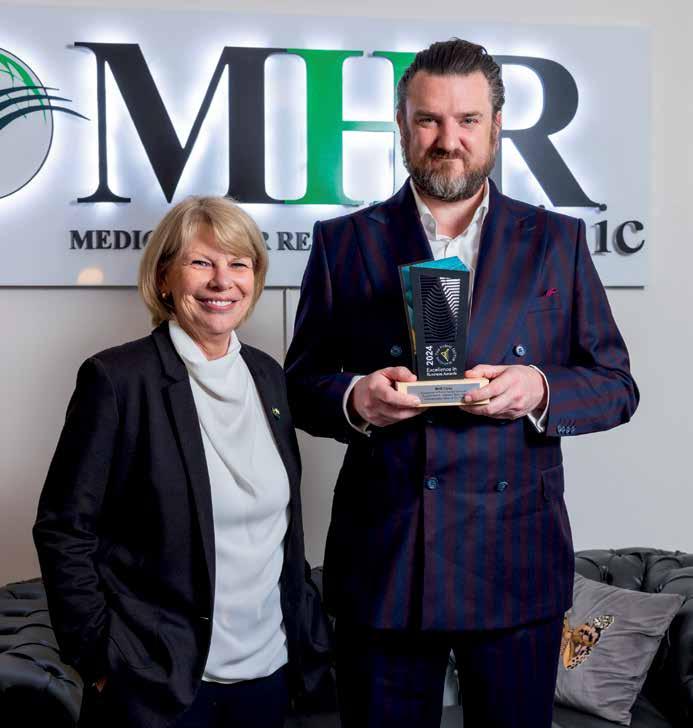
The backbone of MHR Clinic is its dedicated team, working harmoniously to ensure exceptional results and a positive client experience. Their expertise is the driving force behind the clinic’s significant achievements and the trust placed in them by the growing clientele.
In conclusion, MHR Clinic goes beyond merely restoring hair; its commitment extends to positively transforming lives through excellence, affordability, and accessibility. MHR Clinic believes
The
of MHR Clinic’s philosophy lies in personalised care.
in the power of innovation not only to restore hair but also to restore confidence—making MHR Clinic a beacon of hope for those on the journey to reclaiming their self-assurance.
Begin your hair restoration journey with a no-obligation, free consultation at MHR Clinic where the cause and extent of your hair loss will be assessed and a bespoke hair loss treatment package created.












Doone O’Doherty, People Leader and Workforce Partner, PwC Ireland, discusses the topic of gender equality in the workplace and examines the progress achieved and the benefits of committed gender policies.

“Then there is the study by the Journal of Organisational Behavior which reported that gender-diverse teams have been shown to outperform non-diverse teams by 14%.”
The growing significance of diversity and inclusion in workplaces is helping to drive a positive transformation in the nature and profile of workforces globally. Companies seeking a competitive edge increasingly recognise the positive impacts that stem from embracing diversity, including an enhanced company culture, greater innovation and ultimately increased profitability.
However, while there has been progress in relation to promoting gender equality, women continue to face underrepresentation in top corporate roles. According to the EU Commission, around 30% of board members of the EU’s largest publicly listed companies are women while fewer than 1 in 10 boardroom chair and chief executive officer positions are occupied by women (respectively 8.5% and 7.8% in October 2021).
This persistent disparity has given rise to initiatives such as the 30% Club, a global campaign taking action to increase gender diversity at board and senior management
levels to BEYOND 30% - the point at which minority voices achieve critical mass. The campaign continues to expand its international footprint and the ultimate aim is parity.
At PwC we are committed to creating an inclusive workplace culture where everyone feels like they belong. Supporting balanced gender representation and equality has long been a focus for us and we were the first professional services firm to voluntarily publish its gender pay gap in 2019 (ahead of any legislative requirement to do so). Our efforts to drive gender equality reach beyond PwC and we actively engage with organisations such as the 30% Club and likeminded organisations to further promote inclusion and diversity.
According to Doone O’Doherty, People Leader at PwC
Ireland and Partner in the firm’s Workforce practice, efforts to amplify gender equality and broader inclusion ambitions require persistent effort in order to ensure progress is maintained. Initiatives such as the 30% Club help to support this by ensuring the spotlight remains focused on the issues that need to be addressed.
“Being part of the 30% Club allows us to share initiatives and progress and contribute to the collective effort to drive change. It also allows us to support others on the journey, but equally to take on board their learnings and their experience because this is never something that is ‘won and done’,” O’Doherty observes.
“This applies particularly to the gender pay gap because you have to report every year and we want to show continual progress.”
PwC’s most recent Gender Pay Gap Report, published in December 2023 shows that women make up at least half of its population across all levels within the firm. PwC’s mean gender pay gap is also low at 1.6%. O’Doherty also notes that the firm’s gender bonus pay gap has greatly improved from 12.9% to 6.4% within a one-year period - with an equal proportion of men and women in receipt of bonuses.
The report reinforces PwC’s commitment to fostering a culture of belonging and equity.Its latest report also outlines the steps the firm will take in 2024 and beyond to ensure continued progress on its gender equality and broader inclusion ambitions.

Our Inclusion
First strategy looks to ensure that inclusion is inbuilt into every aspect of our DNA as an organisation, and it puts leadership, accountability and transparency at the heart of everything we do.
On a broader national level, an analysis by PwC Ireland of the gender pay gap reports published by up to 500 Irish companies in December 2022 with more than 250 employees revealed an average national mean gender pay gap of 12.6%. The extent of the pay disparity varied across industries with finance, banking, insurance, legal and construction sectors typically exhibiting wider gaps.
“The dynamics vary from industry to industry and from sector to sector, but the relatively high number of males who are in more senior, higher paying jobs probably goes to the heart of what is driving the pay gap numbers,” O’Doherty says.
“One of my areas of work is supporting clients with their own gender pay gap reporting. I am very close to the UK team where they have had gender pay gap reporting in place for
the last number of years. However, the UK numbers are not showing a massive improvement year-on-year, which is interesting and it’s because things like this take a lot of time to turn the dial.”
Progress in Ireland broadly mirrors trends in the UK, where companies are grappling with the challenge of building a robust succession pipeline which will elevate more females to senior positions. Meanwhile, the more onerous ESG (Environmental, Social, and Governance) responsibilities being placed on companies further adds to the pressure to implement more far-reaching diversity and inclusion measures.
“The UK reports show that the range of disclosures that companies are publishing are becoming more enhanced and they’re becoming broader. The variety of ways in which they support gender equality is also becoming much more comprehensive. But there is still an amount of work to do to build that succession pipeline where you start to see females hitting those more senior, higher paid roles. One aspect that is really lighting a fire under employers is that employees are demanding that companies have much more diversity, not just gender diversity, but much more diversity generally, and they want companies to be able to articulate their purpose and their social value,” says O’Doherty.
ESG credentials and reputational risks
“Equally, investors and stakeholders are increasingly focusing on the ESG credentials of a company which means that organisations have to articulate their role in society and the way that they are being fair to their employees, which also includes gender balance. So, I think, companies are grappling with the challenge of not only shifting the dial on the numbers that they report, but also in terms of participating in that wider conversation around their contribution to society and their contribution to diversity and gender balance.
“However, I do think there is a much greater appreciation at the corporate level that gender balance across an organisation leads to much better outcomes. It increases your talent pool, it gives you different perspectives around the table, and it’s a much better reflection of your customers, which can only enhance business. So, while I don’t see a massive swing in the numbers, I think there is a much greater appreciation in business of the need to turn the dial on this.”
Perhaps one of the more surprising benefits of gender diversity is the positive impact on environmental efforts. A study from

the European Central Bank in February 2022 indicates that women in leadership contribute to lower CO2 emissions and a 1% increase in the percentage of female managers within a firm leads to a 0.5% decrease in CO2 emissions.
“Women in leadership are a positive enabler of net-zero efforts and women-led firms make more efforts to curb emissions and have better results for ESG. Then there is the study by the Journal of Organisational Behavior which reported that genderdiverse teams have been shown to outperform non-diverse teams by 14%.
Moreover, PwC’s 2023 Women in Work analysis finds that increasing women’s employment in Ireland could boost Irish GDP by US$50 billion per annum or 9%. At the same time, closing the gender pay gap could boost women’s earnings in Ireland by US$4.32 billion per annum or 8%.”
“So, if there wasn’t a societal imperative for companies, there’s also a financial imperative as well as a very strong ESG imperative,” says O’Doherty.
While there are no financial penalties within the current gender pay gap legislation for failure to report, O’Doherty highlights the significant reputational risks that can accrue for firms who renege on their responsibilities. Adverse publicity for
“Equally, investors and stakeholders are increasingly focusing on the ESG credentials of a company which means that organisations have to articulate their role in society and the way that they are being fair to their employees, which also includes gender balance.
a significant, unexplained gender pay gap can harm a company’s image and result in significant workforce dissatisfaction.
“The penalties are reputational. The last thing you want is to be on the front page of a national newspaper for a large unaccountable gender pay gap. That’s the first thing. The second thing is around your employee sentiment and every year PwC carries out “a Hopes and Fears’ survey which shows consistently that employees globally want to work for an organisation that is diverse and that contributes to social purpose.
“So, actually, I think reputationally or from a workforce or recruitment perspective, those implications might actually be more drastic than a financial penalty imposed by a regulator.”
PwC has made significant progress on its inclusion journey in recent years and is committed to continuing to take action and drive progress. Inclusion First is the name of our central I&D strategy and is centered on ensuring that the things we all do on a daily basis, including the way we think and behave, support a culture of belonging. In 2024, the firm remains focused on further embedding belonging throughout the wider firm and
supporting employees across the moments that matter to them.
O’Doherty notes “Our Inclusion First strategy looks to ensure that inclusion is inbuilt into every aspect of our DNA as an organisation, and it puts leadership, accountability and transparency at the heart of everything we do. 50% of our new leadership team appointed last July is female and, overall, we have about 50% of women employed at each level in the firm.”
“We apply a data lens throughout the entire employee life cycle - using data to provide insight and support decision making. This applies to how we attract individuals, how we select talent, how we develop them and how we ensure career progression. We support both genders, and indeed all of our people, equally through all those milestones and we have a very strong Employee Value Proposition, (or PVP), which focuses on how we can personalise everyone’s journey and how we can make sure that the moments that matter to them in each stage of their life and their career really reflect our inclusive culture and our approach.
Supporting our data-driven approach, last year PwC also introduced a number of Inclusion Targets to work towards by 2026 and 2030. These focus on advancing gender equity, supporting firmwide self-identification and improving our Inclusion and belonging scores within our annual People Survey to drive change and transparency.
This approach extends to the suite of inclusive policies in place in PwC which support our people and families at all stages, including around fertility, pregnancy loss, gender identity and expression, domestic abuse and menopause. The advancement of these policies and initiatives, including our flexible working approach, parental leave and an emphasis on wellbeing, makes the firm an attractive choice for all. It reflects PwC’s commitment to a fair and equitable workplace recognising the complexities and challenges often faced by women, and indeed all employees and taking positive measures to support our people through all life stages.
“We’re finding that both males and females are very much attracted to our flexible working policies. Specifically, in terms of families, we obviously have paternity and maternity leave, and last year, we set up a ‘Parents and Carers Community’ which is part of our Inclusion First Strategy which aims to support those with parental and caring responsibilities in the firm. It’s an incredibly active employee led group who support each other. We also ran a session recently with a sleep expert for children, which is always very welcome and a fantastic initiative for anyone with kids!”
PwC also assists clients to embed inclusion and diversity in their organisations and foster a genuine sense of belonging. The firm collaborates with clients by measuring industry benchmarks and assessing the maturity of inclusion and diversity as well as leveraging technology for unbiased data collection to set a baseline for diversity dimensions. An in-depth examination of the entire employee lifecycle is also carried out.
By advising clients to invest in their culture, enhance policies (especially around flexible working and support for parents), and provide tools for employee feedback, PwC helps to create lasting change. In order to transform the culture of an
organisation, O’Doherty says it is critically important for the company leadership to take ownership of the inclusion agenda.
“We examine and discuss with the clients the disconnect between what leadership might say and what leadership might action. Then critically, we look at their data, their HR information systems and what data they can actually extract. In terms of the actions that we can work on with our clients, the first one is to invest in their culture. So, DE&I initiatives are really based on culture and based on the tone from the top and it’s vital that leadership is brought in and that they are transparent and accountable.”
“The second thing is to enhance their policies, particularly around flexible working. One example being around their support for parents, at every stage of the parental journey. The third thing is to provide employees with the tools to offer feedback in relation to what is working and what is not working, and to drive change from within their own employee circles. Employee involvement really drives leadership to become aware, stay aware and make changes in response.”
O’Doherty continues: “We base our advice very much on what we have done and continue to do as an organisation. So, we look at it across the entirety of the employee lifecycle. We want to know if there is anything there that may be encouraging one group, be that a gender or an ethnicity, more than another to either apply or to stay or to progress and be promoted. We ensure that job specs or advertisements are written in a way that is not more appealing to one group than another.”
The ultimate goal is to ensure the employee population mirrors the diversity of and is representative of society.
O’Doherty concludes: “One of the core behaviours that we want to be known for at PwC is belonging. We want our people to feel that they can bring their whole self to work every day and that they belong. Creating that culture is really important. So that’s the advice that we provide our clients. Look at it over the employee lifecycle, gather the data, use whatever technology supports are available to you, but embed it in your culture, with leadership ownership and support.”
PwC’s 2023 Women in Work analysis finds that increasing women’s employment in Ireland could boost Irish GDP by US$50 billion per annum or 9%. At the same time, closing the gender pay gap could boost women’s earnings in Ireland by US$4.32 billion per annum or 8%.”
Virgin Media stands as the premier provider of integrated entertainment, cable, and broadcasting services in Ireland. The Virgin Media Business division leads the charge in delivering lightning-fast broadband speeds and cutting-edge connectivity solutions, catering to entrepreneurs, businesses, and the public sector alike.
Renowned for its unwavering commitment to delivering the quickest and most dependable connections, state-of-the-art technologies, and top-tier customer service, Virgin Media Business remains synonymous with enhancing the connectivity experience for Irish communities and businesses.
In 2022 the Central Statistics Office (CSO) reported that 97% of all businesses in Ireland use broadband and 44% of Irish businesses sell their products or services online. Internet connectivity is no longer a luxury purchase, it is as essential a utility as water and power. Without it, business simply cannot function.
One of the greatest challenges in the digital revolution
has been overcoming the issue of getting the fast, reliable connections businesses need in rural areas. Traditionally, urban areas enjoyed the fastest connectivity and the widest choice of services and service providers whilst rural areas often suffered from poor, or even no, access to the online world. As a result, most business was to be found in larger towns and cities.
Possibly the greatest catalyst for change in connectivity has been COVID, which forced businesses to rethink how they operated and how to enable employees to work from home. The pandemic also resulted in employees re-evaluating their lives, placing more of a priority on a healthy home-work balance and increasingly deciding to create businesses for themselves. The credit risk analyst CRIFVision-net, reported that the number of new business start-ups in Ireland reached the highest number
on record in 2021 as the country was slowly pulling out of pandemic lockdown.
One of the outcomes of this societal shift to working from home or working for oneself was that people no longer needed to live in large urban conurbations to run a business or to access their employment; they could enjoy more affordable housing and a better quality of life moving to rural areas however, such a transition requires fast and reliable connectivity to be successful.
In her 17 years at Virgin Media, Dagmara has worked in a number of technical roles, starting in Network Operations and moving into design and engineering roles in the B2B area that became Virgin Media Business. She reflects on how accessible good connectivity has become for businesses of all sizes. “It’s very accessible these days. It used to be a luxury, especially in rural areas. In the last five years in particular, the market has changed and a lot of investment has gone into growing the network and I think COVID has a lot to do with that. That extra speed and accessibility was needed to cater to the demand to accommodate working from home and educational needs during lockdowns.”

second) as standard with a 2Gb option coming later in the year on a new XGSPON fibre network. Whilst medium to large businesses can benefit from 10Mbps to 10Gbps on Virgin’s separate dedicated fibre network, a speed around ten times faster than previously available.
Reliability of service is critical to business continuity as Dagmara explains, “Many companies rely on us for their day-to-day business, and even short outages can cause quite significant financial losses for them. So solid, stable connectivity is a must-have. Just like your power supplier or gas supplier, we also have to be constantly on hand.”
In late 2022 Virgin Media Business announced that it was planning to invest €200 million in upgrading the network to full fibre over three years and expanding it to penetrate 70% of premises in Ireland. Fibre is, as Dagmara says, the enabler for business and she remarks, “With that technology in place we will achieve even more in terms of speed, performance and quality.”
As businesses across Ireland join the digital revolution and get connected, the demands on a service provider like Virgin Media Business grow as those enterprises explore the world of possibilities open to them in the digital space.
One of the greatest customer demands is increased bandwidth. In the not-too-distant past businesses carried out their operations via numerous software applications that were locally installed on office computers. This operating framework was expensive and inefficient; requiring powerful office desktop computers, numerous software licenses and large IT departments to manage the continuous process of installing and updating operating systems and applications. Increasingly, businesses are moving to Platform as a Service (PaaS) or Software as a Service (SaaS) and taking everything off-premises and into the cloud. An enterprise that is conducting all its business online requires a lot of bandwidth and this has been demonstrated in the 20% increase in demand that Virgin Media Business saw in 2023 from the previous year, an increase that is expected to continue year-on-year.
The current upgrading of the network to full fibre will meet this increase in bandwidth demand from businesses at far greater speeds. Virgin Media Business now offers small businesses a service from 500Mb to 1Gbps (Gigabytes per
With that reliability in mind, Virgin Media Business’ service resilience starts right at the core network where recent upgrades have ensured full geo-redundancy. This reliability at the core is particularly critical for businesses in the financial sector who are now adopting the Digital Operational Resilience Act (DORA) which requires financial companies to follow rules for the protection, detection, containment, recovery and repair capabilities against Information, Communication and Technology (ICT) related incidents.
In addition to resilience at the core network level, Virgin Media Business offers its customers a suite of options to ensure resilience at the end-user level. Larger businesses can opt to take up Virgin Licensed Microwave (VLM) for Business to provide a secondary feed for full network redundancy if, for any reason, the fibre connection experiences an outage. There is also the option for DIA with automated failover (HSRP) with two redundant CPEs, with either two diverse connections from Virgin Media Business, or Licensed Microwave using another provider’s connection, as well as protection against Distributed Denial of Service attacks via the Virgin DDoS Mitigation Service option. Such protection allows online businesses to continue without being strangled by the deluge of malicious traffic.
One of the many benefits of fibre is that it is incredibly tough and resistant to weather, and whilst it is capable of being physically damaged if machinery cuts through it, that is an occurrence which is incredibly rare now that construction crews have access to detailed plans of where fibre cables are laid on any site or road. Fibre is also not at the mercy of power outages as much as other forms of connection, having passive nodes enables it to go further without reliance on a power supply so an outage doesn’t have to result in fibre being unavailable across a whole area.
Dagmara expands on the company’s unrivalled reputation for reliability, “The impressive SLAs we provide, together with the fact that our crews are internal and the contractors we use work closely with us and are directly connected to Virgin Media systems, ensures that we provide a solid network with an unparalleled level of resilience.”
She goes on to say, “We have great support teams that

make sure that whenever there is an issue, relevant engineering departments are informed to react and act ASAP. That swift response is something that’s part of our core strategy, and we always try to ensure the customers stay connected and have the best experience possible. Virgin Media Business SoHo customers benefit from a next working day fix time whilst MLE customers are covered by 24/7 support. Virgin Media Business offers its customers a dedicated Business Support Team based in Ireland, taking care of the network and allowing customers to concentrate on what matters most - their business.
This commitment to exceptional customer care and an excellent customer experience is demonstrated in the Commission For Communications Regulation (ComReg) Consumer Care Statistics Report which shows that Virgin Media Business held the lowest average complaint rate per 100,000 broadband lines out of any service provider for every quarter of 2023.
One of the roles that Dagmara’s team undertakes is the design of the customer’s service solution to fit business needs, and that is a process that begins with a conversation to fully understand what those needs and requirements are. As Dagmara explains, customers often think in terms of broadband as internet access alone, but there are many flavours of broadband products and optional services to cater for businesses, large and small, so a full understanding of their requirements from the outset results in a service tailored for their specific needs.
For businesses with 20 or more employees, a Dedicated Internet Access (DIA) service affords customers 10Mbps to
10Gbps speeds with no sharing of bandwidth and synchronous upload and download that’s perfect for data traffic heavy services such as VoIP and cloud applications. Adding SIP Trunking allows companies to dispense with ageing telephone equipment under different agreements, unifying everything under a single supplier whilst enjoying advanced call-handling features such as DDI (Direct Dialling Inwards), CLI (Call Line Identity), CLIP (Caller Line Identity Presentation), CLIR (Caller Line Identity Restriction) and Presentation Numbers.
This commitment to a tailored service that meets customer needs extends to the SoHo customer where, Dagmara says, her team “Go over and beyond to find the most cost-effective solutions.” Those solutions can include, in addition to essential broadband, services such as business mobile, TV packages, WiFi and voice services.
For customers of all sizes, timelines for delivery of their perfect solution are a high-priority concern and this is another area where Virgin Media Business excels thanks, in part, to internal engineering crews who have worked for the business a long time, know the network inside out and are therefore able to leverage their great expertise to deliver solutions in a marketing-leading five working day timeline.
The digital revolution is resulting in technology that’s advancing exponentially and requires service providers to continually invest to serve changing business needs. Alongside an ethos of enabling businesses to grow by delivering fast, reliable broadband the company has a culture of curiosity which drives them to seek out new technologies and invest heavily in research and development of their products. Virgin Media Business is committed to being the best-in-class for business connectivity and the trusted partner for enterprises in their digital transformation.





Businesses of all sizes, upgrade to our Dedicated Internet Access: reliable, equal speeds, robust backup, and top-tier Service Level Agreements. We've got it all covered.
FEATURES:
• Symmetrical service: Your upload and download speeds stay identicalessential for moving data and services like VoIP.
• Cost e ective:


Choose the plan that suits your business needs. Fixed monthly costs mean no nasty surprises on your bill.
• Best service agreements: In the unlikely event of an interruption we provide the best service agreements in Ireland.
BENEFITS:
• Relentlessly rapid:
From 10Mb to 10Gbps per second, a dedicated connection gives you the ability to work with higher capacities with identical upload and download speeds.
• Flexible bandwidth:
Easy to ex when demand changes and easy to budget with the knowledge of all the xed costs up front. You’ll only ever pay for the bandwidth you need.
Get in touch: enterprisesales@virginmedia.ie



Have you stuck with the same policy for too long? A simple review may save you money. Reviewing and switching cover can seem like work, so many people simply maintain the same mortgage protection and health insurance policies every year. However, that is rarely the best option!
Here we look at some of the key reasons why you should consider reviewing your cover this year, it’s hassle-free and could save you money in the long run!
Has your level of cover changed?
As you pay off your mortgage, the level of cover you need changes. Reviewing your mortgage protection will guarantee you’re covered for your current needs. You may even find you’re over or under-insured.
More than one mortgage?
If you have more than one mortgage, then you may also have more than one mortgage protection policy (one for each property). It’s important to check that your mortgage protection is appropriate for the value of each property and term of the mortgage. You also need to make sure that your mortgage protection covers both you and your partner. Remember, only your principal residence requires mortgage protection but to make sure you are protected in the event of death, you should cover all properties.
Not all policies are the same
Providers are always updating and improving their cover, and releasing new products. So it makes sense to review and shop around – there may be cost savings or better benefits with another policy.
Remember when re-mortgaging…
It’s vital to ensure your cover is right for your new mortgage and any life changes. Since you bought your first house, your protection needs may have changed. Children, financial status and lifestyle changes can all be factors. If you re-mortgage your house, make sure your mortgage protection value matches your new mortgage. Without a review of your mortgage protection, you could be left with a shortfall.
Get a head start on your health in 2024 by reviewing your Health Insurance with Cornmarket.
Did you know that over 1 million health insurance customers are due to be hit with significant price increases over the next 4 months? Many plans will experience double digit increases! Successive price increases applied by VHI, Laya, and Irish Life Health, mean this could add €600 to the cost of a Health Insurance plan for a family of 2 adults and 2 children.
It is estimated that 60% of Irish people with health insurance are potentially overpaying by 30% or more every year! Many customers are on the wrong plan for their needs too.
If you’ve been sitting on the same plan for 3 years or more, it’s likely you’re overpaying and need to urgently review your plan… That’s where we come in!
Switching to the right policy is easy with Cornmarket. We’re Ireland’s largest health insurance broker and we compare all 320 plans† on the market for you… so you know you’ll get what you need, at a price you can afford.





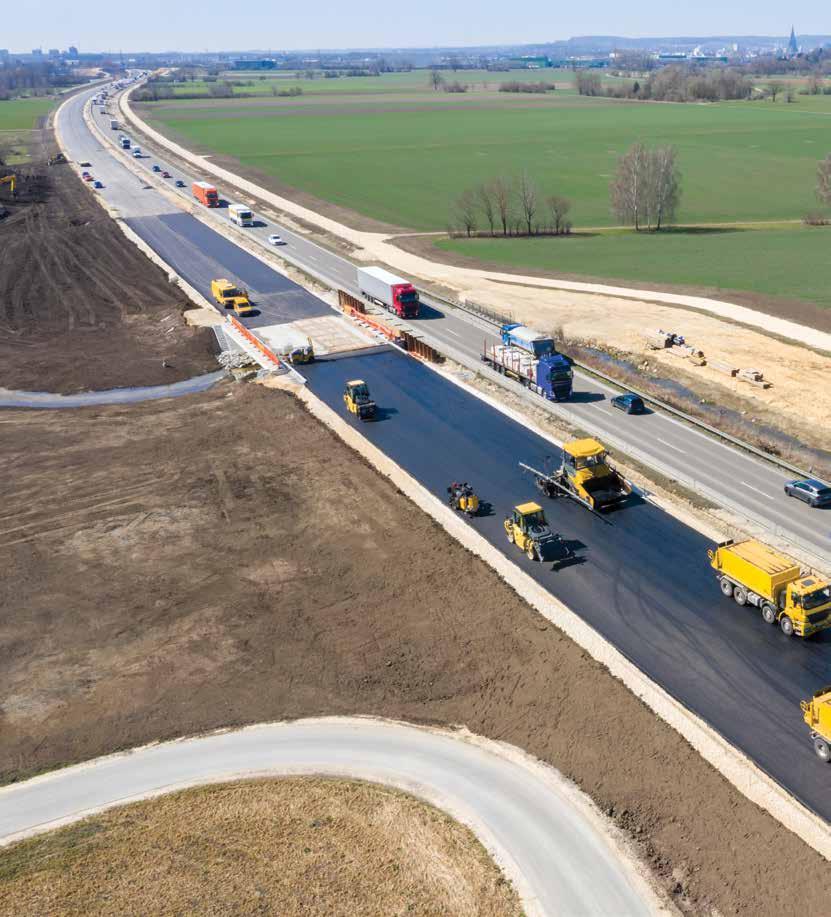
Current uncertainty across all markets has been created by a perfect storm of the war in Ukraine, the supply crunch lag of the after effects of the Covid pandemic and central banks around the world trying to get inflation under control. The Public Sector Magazine speaks to Colm McGrath, Managing Director of Surety Bonds on the effects of all these elements plus other issues which are increasing volatility all around the world.
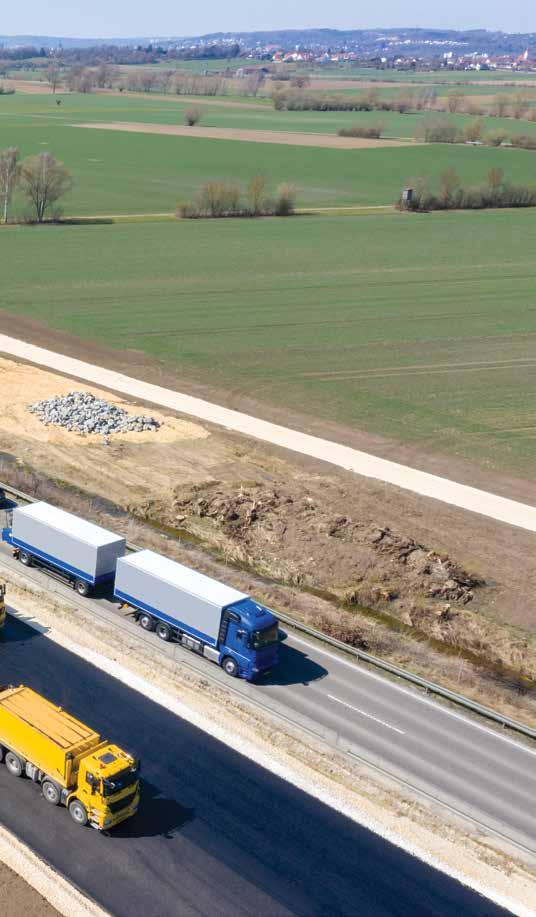
Recent history has shown that construction firms are not too big to fail even though they may have annual revenues ranging from millions, hundreds of millions to several billions of Euro. The industry has regularly witnessed smart leaders making what appear to be the same fatal mistakes others have made before them. “Frequently cited mistakes are; unrealistic growth, over expansion, unfamiliar new markets or entry into new types of construction, volume obsession and bad contracts or poor project selection”, McGrath explains.
Forewarned is forearmed as they say, so is knowing about

“The missing piece of the jigsaw is investment in infrastructure,” Colm explains.
“There is huge scope for civil engineering projects which is currently posting the weakest activity of all construction sectors.”
repeated errors enough? “While helpful, this list of mistakes provides insufficient clarity regarding the causal roots of failure, more often it is a combination of factors. The way work is procured is partly to blame, in large the construction industry is different from the way most businesses work. The developer/ employer wants a building and wants to know exactly how much it is going to cost before the project is built. Increasing complexity of projects, fluctuating materials costs and labour concerns all conspire to make this a dangerous get-work practice for contractors. While the predominance of this method

is changing with new delivery methods, it is easy to see how contractors still get into trouble”.
As the construction industry contends with subdued market conditions driven by all the issues mentioned above and after several years of cheap money and now soaring prices, there are growing signs of problems in the property markets. McGrath goes on to say he “welcomed the Minister for Public Expenditure, Paschal Donoghue’s comments on the 10th of March that he was going to “Sharpen the focus on NDP project delivery” as part of his departmental remit. There are so many projects out there, housing, schools, roads, water treatment plants, hospitals and environmental changes such as public transport that need to be either fast tracked or at the very least put into a fixed pipeline of delivery”.
While this is positive news, the required volume of 40,000 residential units per annum are far from being met with close to 29,000 units to be completed in 2023. The construction industry being led by the commercial sector is continuing to expand, albeit at a slower pace
To add to this positivity, the construction industry being led by the commercial sector is continuing to expand, albeit at a slower pace. The residential sector is catching up albeit well below the required volume of 40,000 units per annum are far from being met with close to 29,000 units to be completed in 2023, there is still massive scope for growth. “The benefit of increased levels of supply is the easing of house price inflation which is slowing to a more sustainable pace. The missing piece of the jigsaw is investment in infrastructure,” McGrath explains. “There is huge scope for civil engineering projects which is currently posting the weakest activity of all construction sectors. If a slowdown or even a recession, which looks very unlikely, were to occur than it is obvious that investment in infrastructure is required to support Ireland’s growth, and this lies firmly on the shoulders of the Government.”
“While employment levels within construction continue to rise the difficulty for the sector is attracting employees, this will lead to an inability to achieve housing ambitions. The minor decline in commercial activity and employees may just be a seasonal glitch. McGrath feels it is a bit more than that. “Before I get shot for talking the market down which I am not, I do believe there are signs of a slowdown and maybe even a pause in the supply of construction contracts while we wait and see what the outcome of the uncertain times, we live in will be. I would also consider after the flurry of commercial building we have had over the past three to four years that we are in a more mature part of the property cycle, well in the capital anyway, that investors are being more selective in their investments and they are focused on protecting any potential downside which further impacts on the pace of closing out a deal.”
The construction sector’s share of gross domestic product in Ireland in 2022 was 1.95%, the sector is key for employment and due to the fact Ireland cannot grow without the success of this industry by providing the office space we work in, the housing space we live in and the infrastructure we travel on. In these uncertain times the key point Colm makes is that “the Irish government needs to provide certainty for the construction sector, the government has not delivered although it has committed to a plan “Project Ireland 2040” which should provide comfort to the industry, but up until now the list of projects in the 2040 plan seemed to be more a wish list than a constructive coherent program of which many will not see the light of day. If there is a slowdown or pause than the government needs to be in a position to move a large number of these projects forward from wish list to reality in order to sustain current levels of construction and those employed in it”.
In regards to the future, McGrath summarises; “I look forward to seeing the Ministers plan for the NDP investment of €165bn and where and when it will delivering the vital infrastructure such as housing, schools, hospitals, roads and public transport. The plan should bring some certainty to an industry facing levels of uncertainty in current volatile times.”





The Public Sector Advisory (PSA) team at Evelyn Partners is unique in its makeup. The firm has gathered together a handpicked team from diverse backgrounds which includes the University Sector, the wider Public Sector, Government Funders and Professional Practice all with shared experiences in the management and administration of national and European grant programmes across a large number of grant funding schemes.
The skills mix within the PSA team is such that the firm brings huge amounts of experience to bear on what is sometimes seen by clients as complex challenges. The team turns those challenges into managed solutions which drill down into the component parts of each particular challenge to get to the core of the matter and build the solution outwards from there.
This skills mix is needed, as the grants landscape in Ireland has changed significantly in the last 15-20 years, with a significant increase in the number of schemes being developed and funded from National/Government sources. All have increasingly complex rules and eligibility criteria together with an even greater emphasis on compliance and governance around the management of such schemes.
Historically the European Commission was seen as the main source of grant funding for the vast majority of schemes, with Ireland securing €1.2 billion in funding through Horizon 2020 across the life of that programme from its launch in 2014. Whilst the Commission continues to be a significant source of grant funding going forward through its current Horizon Europe programme for example, there are a growing number of other grant funding opportunities being generated from national
funding sources.
This growth in the number and complexity of these schemes brings with it many challenges which public sector funding bodies and beneficiaries alike can find difficult to navigate.
Couple this with a silver tsunami of corporate knowledge retiring from a number of the public sector bodies who historically would have managed and administered such schemes, it means that in many cases public sector funders have had to look to outsource important aspects of the management of these schemes.
At Evelyn Partners the PSA team has worked with many national funders and funding beneficiaries, using their collective technical knowledge and expertise of such schemes together with an advanced in-house technology stack to deliver a seamless outsourcing solution offering a leading-class experience for funders and beneficiaries alike.
The dedicated team has over 50 years of experience across the full spectrum of grant programmes from European, Framework Programme 5(FP5) right through to Horizon Europe, Marie Curie, Erasmus +, ESF, and Interreg together with national funding programmes delivered by bodies such as Enterprise Ireland, Science Foundation Ireland, and the Environmental Protection Agency. The team’s diverse background means that it has experience from the perspective of the funder the beneficiary and the regulator to bring to bear for the benefit of all clients.
Evelyn Partners’ outsourced solutions bring significant benefits which mitigate many of the challenges that traditional
in-house grant delivery models can experience:
Speed to Market – In some instances, grant providers are tasked with administering emergency grant schemes which, by their very nature, need to be deployed at speed. The firm’s experience and in house technology stack means it can quickly deploy solutions of scale right out- of-the-box.
Ability to Scale – With offices in over 16 locations and a common resource and technology platform across all offices, Evelyn Partners has the capacity and flexibility to scale its outsource teams, up or down, to suit fluctuating volumes or peak demand periods.
Advanced Technology StackA dedicated in house Technology Transformation Team works collaboratively with the PSA Team to tailor and deliver tech-enabled solutions where required. This agile approach is used to effectively deploy solutions more efficiently and at a lower overall cost.

and delivered end to end in four months.
Evelyn Partners sees a growing need for funders to be able to deploy schemes in a similar manner, with government departments looking to ensure that grant funding is delivered quickly to more targeted and specific needs. This means that speed to deploy and ease of delivery, become critical factors in the success of these schemes.
This can be challenging for both government and funders alike, particularly where their in-house resources are already committed to an existing portfolio of schemes, and increasingly they are seeing the benefit of being able to deliver these additional schemes using an outsource model, while still maintaining the security and integrity of any underlying data, ensuring the governance of the scheme is not compromised and avoiding any impact on the applicant experience.
Year-Round Resourcing- A dedicated team is focused solely on public-sector clients and is not distracted by other competing demands such as tax filing deadlines or Companies Registration Office annual return dates. This means the Evelyn Partners team are available on a constant and consistent basis to deliver to Public Sector client timelines.
These benefits were utilised to good effect in a recent project undertaken on behalf of a large national funder tasked with delivering a grant subsidy to a cohort of businesses impacted by the recent energy crisis. The subsidy had to be delivered at speed utilising an online grant application model.
Evelyn Partners used its experienced team of grant management and support advisors, to deliver a solution built using its in-house technology stack. Utilising an agile development process, the firms’ Technology Transformation Team, delivered a robust scheme portal and user interface for online applications including a scheme web- based solution and application portal incorporating a document repository and also benefiting from advanced RPA (Robotic Process Automation).
This approach enabled the PSA Team to deliver and go-live with the application portal within four weeks of approval of the project scope. Working with the funding body, Evelyn Partners successfully delivered and administered a seamless application interface for eligible businesses to access the scheme. This included scheme design, back-end processing, verification checks, application assessment, and management of an appeals process, which culminated in approved applications recommended for funding. The entire scheme was deployed
Whilst the short to medium-term outlook for the grant funding sector suggests a continued period of challenge, in particular around resourcing and a loss of corporate knowledge, Evelyn Partners see further opportunities to continue to deliver innovative solutions to the sector.
At the heart of the Evelyn Partners business is the power of good advice and the team deploys that good advice and expertise using innovative delivery mechanisms which leverage the potential of our in-house technology stack.
Evelyn Partners will look to continue to convert each of those challenges into exciting solutions for funding bodies and deliver the agile solutions that stakeholders continue to look for, and in doing so, the Public Sector Advisory Team at Evelyn Partners will continue to do what they love doing.
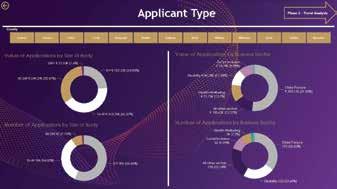
From government departments to state bodies, our experience of working with Ireland’s public sector spans decades.

Our collaborations include:
• Delivering tech-enabled outsourced grant management support and consulting
• Providing sector specialist internal audit services on an outsourced basis
• Providing outsourced financial, accounting and compliance resources
• Supporting public sector bodies with their ongoing accounting, governance, risk and internal control requirements


Technical expertise, an advanced technology stack and strong relationships underpin how we deliver these services and our specialist Public Sector Advisory team is dedicated to delivering practical innovative solutions, without compromising our partner-led approach

Ireland’s public debt figures were revealed by Minister for Finance Michael McGrath following the publication of his department’s seventh annual assessment of public indebtedness in Ireland. The Annual Report on Public Debt in Ireland 2023 is a forensic assessment of public debt dynamics and sheds light on key strengths and vulnerabilities in the public finances.
The key message from the report is that while the debt-income ratio continues to be on a downward trajectory, several known structural changes will pose significant challenges in the coming decades.
Minister for Finance Michael McGrath said that while the State’s debt of €223 billion gross was a “very significant debt for a small, open economy”, there are also many positive aspects to welcome in the Public Debt report,
“The purpose of the report here is to identify the strengths and weaknesses and also to help promote fiscal discipline. I think it is important to acknowledge progress, we are on reasonably solid ground,” he said.
“Gross public debt amounted to 76 per cent of modified Gross National Income (GNI) at the end of last year, at its peak, which was in 2012, it stood at 166 per cent.
“So, 166 per cent in 2012, 76 per cent at the end of last year, the gross debt has fallen from a peak of €236 billion at the end of 2021 to €223 billion at the end of last year. We are running a General Government Balance of close to 3% of national income, we have substantial cash reserves on hand and our credit rating has been steadily improving.
“This illustrates the importance of ongoing prudent management of the public finances,” he said.
However, while the State’s sovereign debt is in “a very manageable period” at the moment McGrath warned that the risks “can’t be ignored”.

Minister for Finance Michael McGrath: “While structural aspects of Ireland’s debt have, so far, insulated the public finances from the impact of higher interest rates, this will not last forever. Indeed, a significant portion of public debt will be exposed to higher interest rates in the coming years.”
“Gross public debt amounted to 76 per cent of modified Gross National Income at the end of last year, at its peak, which was in 2012, it stood at 166 per cent.”
“While structural aspects of Ireland’s debt have, so far, insulated the public finances from the impact of higher interest rates, this will not last forever. Indeed, a
significant portion of public debt will be exposed to higher interest rates in the coming years,” he said.
“In addition, the underlying fiscal position is less benign than the headline figures suggest. The tax base is relatively narrow, and the public finances remain exposed to a shock to corporation tax receipts; product- or sector-specific shocks could potentially affect income tax receipts also.”
The Minister also added that the two funds announced as part of Budget 2024, the Future Ireland Fund and the Infrastructure, Climate and Nature Fund, would be “key” to safeguarding against risks.
The Future Ireland Fund is designed to meet the costs of running the State in the future. A total of 0.8 per cent of GDP will be invested into the fund every year between 2024 and 2035, for an expected total of €100 billion.
A separate Infrastructure, Climate and Nature Fund is expected to grow by €2 billion for the next seven years.
Meanwhile, the Department of Finance’s chief economist John McCarthy said there are only a handful of countries in the world that have a higher level of per capita debt, including Japan, Belgium and Italy.
McCarthy said the risks facing the public finances include an overreliance on corporation tax, as around 60% of overall receipts come from 10 firms and half of last year’s €23.8bn in corporation tax revenue is windfall.
“One shock, if the excess corporate tax was to evaporate overnight… there will be a big hit on public debt: about 15 percentage points higher by 2035,” he said.
From about 2030/2035 onwards, there are “less benign type of scenarios” for public debt as “slow moving structural changes begin to really bite”.
Mr McCarthy added that if there are no policy changes made, the ratio of workers to retired people will shift from four workers for every retiree currently, to two people working for every retiree in 2050.



Cyber Ireland unveils ambitious roadmap to drive cyber security sector growth by 2030.
Cyber Ireland, the leading national cyber security cluster organisation, has launched a comprehensive strategy aimed at driving the growth of Ireland’s cyber security sector by 2030. Since its establishment in 2019, Cyber Ireland built an impressive track record and has evolved into a national representative body, uniting over 160 member organisations, including start-ups, SMEs, multinational corporations, and educational institutions.
Originally conceived to address cyber security skills shortage as an initiative at Munster Technological University, Cyber Ireland has grown into a recognised industry force, hosting activities across four strategic workstreams and also responsible for organising the annual Cyber Ireland National Conference (CINC), the premier cyber security conference which attracts leading cyber security experts from across Ireland and the globe.
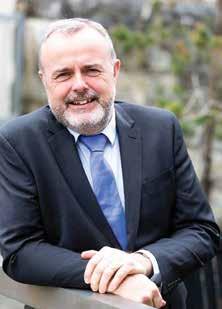
Cyber Security market opportunity in or around $200-$250bn with a 15% growth rate.
“There is an incredible opportunity in front of us. A recent consultancy report estimates that the current vended market spend may be 10 times under penetrated and thus the addressable market may be between $1.5 and $2 trillion,” he said.
“No matter how you look at it, we cannot capture or service even a small percentage of that addressable market currently as individual entities. By working together as an industry sector, we have a massive opportunity to capture a greater share of this market from Ireland, through Cyber Ireland,” Larkin added.
According to the State of the Cyber Security Sector 2022 report the cyber security sector in Ireland employs over 7,300 professionals working across nearly 500 companies contributing €1.1 billion annually to the economy. Ireland requires a strong domestic cyber security sector with companies of scale that can deliver high value services to provide cyber resilience for the country and compete internationally. This can build on existing strengths as the island of Ireland grows into an international hub in Europe for cyber security multinational operations and further increase FDI in cybersecurity.
There has been strong demand for cyber security skills over the past four years with a trebling of job roles advertised between 2019 and 2022, from 2,000 jobs advertised to 6,700 open roles. On a growth trajectory of 10%, the sector anticipates the creation of 10,000 additional jobs by 2030, totalling 17,000 in the sector, contributing €2.5 billion per annum to the economy. How this demand is met given the existing skills shortages and skills gaps will be central in making Ireland a leader for cyber security talent globally.
According to Pat Larkin, Chairperson of Cyber Ireland and President, Ekco Security, analysts quantify the current
The opportunity now exists for Ireland to capitalise on its cyber security strengths and competitive advantages to develop a leading cyber security sector in Europe, and globally, providing resilience domestically and competing internationally. Cyber Ireland aims to be the driving force to deliver on Ireland’s cyber potential through the implementation of its new cluster strategy 2024 –2027. The new strategy has four Focus Areas across Building the Community, Driving Business Growth, Developing the Workforce, and Advocacy and Promotion.
The cluster has recently been accredited with the European Cluster Excellence Initiative (ECEI) Bronze Label for “Striving for Cluster Excellence” by improving its management capabilities and performance levels. Cyber Ireland joins over 1,000 cluster organisations from 45 countries that have been benchmarked and received the award. The recognition will create additional opportunities for the cluster to promote the sector and engage with European organisations and clusters, and secure European funding.

Kevin Buckley of Enterprise Ireland, said, “As a key supporter of Cyber Ireland, Enterprise Ireland is delighted to see the launch of this ambitious plan to grow employment and investment in this critical sector. Ireland is building a global reputation for innovation in cyber security and Enterprise Ireland is committed to assisting established companies and startups in this sector to realise their global ambitions.”
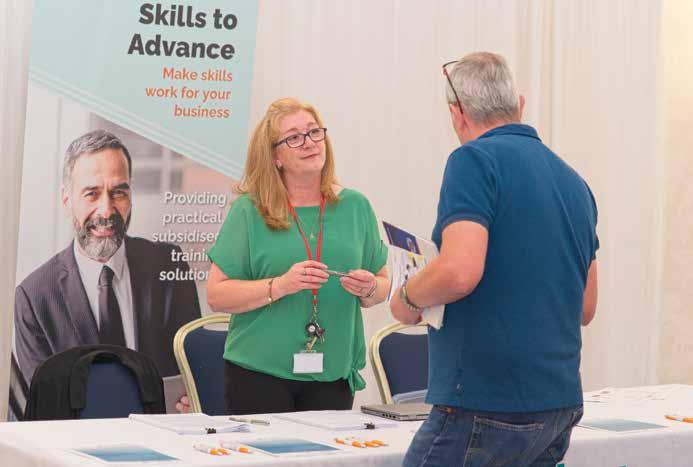
LMETB is ideally positioned, in a strategically important economic area, to be the education and training provider of choice both for employers seeking to upskill its employees, and for the Louth and Meath population in general to upskill, reskill and participate in lifelong learning.
The delivery of FET programmes to support the economy locally in Louth and Meath is supported through the national SOLAS- funded Skills to Advance Initiative. LMETB’s Employment Engagement Officers work with local industry to help identify training needs, and to then develop and deliver
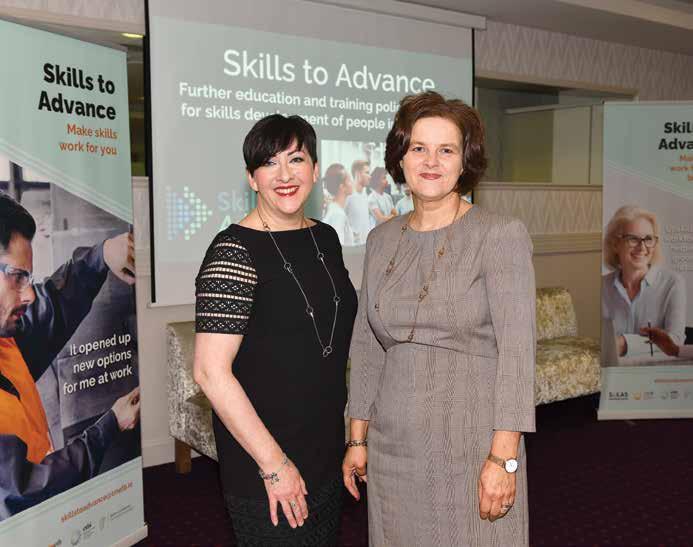
targeted interventions to upskill and reskill the workforce. LMETB works in partnership with a range of bodies including, Regional Skills Fora (Mid-East and North-East), Chambers of Commerce, Local Enterprise Offices and Local Authority Economic Development Units, as well as with key business networks in both counties, to custom build its training programmes.
LMETB’s Employer Engagement Officer notes how this collaborative approach is essential: “Working in partnership with the various networks and employers around the region enables us to develop training that allows enterprises to compete at a higher level because staff are operating with an enhanced skillset. It can also be a very cost-effective solution for many employers as this training is fully funded by the ETB or is provided at a highly subsidised rate, while employees can also apply directly for funding to upskill under our evening course provision.
Support under Skills to Advance initiative is available to sole traders, small and medium-sized enterprises (SMEs), or multinationals who need some assistance to invest in and develop their workforce. Certified training can be delivered directly to individual employees or bespoke training programmes can be provided to individual companies or groups of companies. Training can be provided in soft skills development such as customer service, as well as in technical, practical and ICT skills. Many courses are 100% or 70% funded and offered at flexible times and locations, whether that be in the workplace, online or in an LMETB FET Centre.
In 2022, Employer Engagement Services in LMETB supported almost 1213 employees in over 92 companies to avail of training courses. These employees came from a wide range of sectors including Agriculture, HealthCare and Childcare, Construction, Education, Leisure and Services, ICT and Telecoms, Manufacturing and Engineering.
An example of one local company which has benefitted from LMETB’s Skills to Advance provision is Kilsaran Concrete, whose staff participated in Managing People QQI Level 6 and Customer Service QQI Level 5 training programmes.
The company’s Head of Strategic HR praised the LMETB team in how “they went above and beyond by taking the time to meet with us on-site, on more than one occasion and, also offered the opportunity for work shadowing, which proved to be an invaluable experience. They took the time to understand our company’s challenges, industry dynamics, and culture. They carefully crafted the training modules to align with our requirements, ensuring that the knowledge and skills acquired were directly applicable to our daily operations.”
LMETB’s Skills to Advance Initiative is committed to offering training solutions to help build the talent pipeline in the region. If this is an area that we can assist your company with, contact LMETB on skillstoadvance@lmetb.ie or phone 086 067 9510. Information is also available on www.lmetb.ie/fet or on social media @lmetbfet.

The NIS2 Directive is an important legislative act by the European Union that aims to significantly raise cybersecurity standards across member states, ensuring that essential and important entities especially public bodies efficiently manage risks to their network and information systems. The directive underscores the urgency for robust cybersecurity measures. The deadline for compliance is October 2024.
Cyber Skills, a multi-university initiative, has listened to public bodies and understands the pressures you face in meeting the NIS2 Directive’s mandates. Cyber Skills has practical courses available that can help you with NIS2 compliance. These courses are designed to prepare participants for all eventualities, offering support for recovery planning through practical exercises and access to a wealth of resources. Cyber Skills is here to assist public bodies in strengthening their cyber resilience, supporting their efforts to comply with NIS2 Directive requirements.
Cyber Skills has aligned its courses to the NIST Cybersecurity Framework functions starting with providing a foundation in identify and protect, thus making detect, recover and respond easier to achieve providing skills to support a clear pathway to NIS2 compliance. This considered approach ensures that learners are not only prepared to meet current standards but are also equipped to anticipate and respond to future cybersecurity challenges.
Cyber Skills’ higher education programmes span a range of topics, addressing the needs of various roles within public bodies from management to technical IT and software personnel. Participants can choose from workrole specific progammes such as secure network operations or secure software development or pick and choose micro-credentials which are best suited to their work role.
All courses are structured around the NIST framework’s five pillars: Identify, Protect, Detect, Respond, and Recover. These courses are designed to cater to the varying needs and roles and responsibilities across different levels within public bodies.
■ Objective: Understand the structures, policies, and processes required to manage cybersecurity risk to systems, assets, data, and capabilities.
■ Courses Offered:
■ For Management and Senior Technical roles: Cybersecurity Risk Frameworks, Cybersecurity Law & Regulations.
■ For Junior/Middle Technical IT: Cybersecurity Standards & Risk.
■ Objective: Develop and implement appropriate and proportionate cybersecurity measures to deliver and protect the organisation’s essential services and systems.
■ Courses Offered:
■ For Management: Cyber Incident Response.
■ For Senior Technical: Information Security Architecture, Security Architecture.
■ For Junior/Middle Technical IT: Secure Network Services, Secure Network Systems, Log Files & Event Analysis.
■ For Junior/Middle Technical Software: Secure Software Development, Security Assurance, Practical Cryptography, Security Web Penetration Testing.
■ Objective: Develop and implement appropriate capabilities to identify, detect, and defend against a cybersecurity event that may affect essential services and systems.
■ Courses Offered:
■ Senior Technical roles focus on Vulnerability Analysis, Penetration Testing, Evasion and Defense Analysis.
■ Junior/Middle Technical IT roles cover Log Files & Event Analysis.
■ Objective: Develop and implement appropriate activities, prioritised through the organisation’s risk management process, to take action to contain and minimise impacts relating to a cybersecurity event.
■ Courses Offered:
■ For Management: Cyber Incident Response.
■ For Senior Technical: Evasion and Defence Analysis.
■ For Junior/Middle Technical IT: Log Files & Event Analysis.
■ Objective: Develop and implement appropriate capabilities, prioritised through the organisation’s risk management process, to restore essential services affected by a cybersecurity event.
■ Courses Offered:
■ For Management: Cyber Incident Response.
■ For Senior Technical Roles: Secure Systems Architecture
In collaboration with ENTIRE European Digital Innovation Hub Cyber Skills provides resources to prepare for recovery planning, support services, and facilitate tabletop exercises, ensuring that public bodies are well-equipped to respond to and recover from cybersecurity events.
Cyber Skills is at the forefront of cybersecurity education in Ireland. Experts from three of Ireland’s top universities: Munster Technological University (MTU), University of Limerick (UL), and Technological University Dublin (TU Dublin) are collaborating. Together, they offer unique pathways and micro-credentials for upskilling and enhancing careers in cybersecurity. The curriculum, created by a combination of academic and industry experts and in partnership with leading companies like Dell and Mastercard, is designed to meet the direct needs of the workplace, enhancing the skills of working professionals.
Contact Cyber Skills today by emailing info@cyberskills.ie to discuss how they can support your organisation’s path to NIS2 compliance.

William Tracey and Sons and Cronin Group providing logistics solutions to the public and private sectors.

The acquisition of William Tracey and Sons by the Cronin Group Limited in May 2022 resulted in a seamless integration for both companies and staff, offering an enhanced service to the firm’s clients in both the public and the private sectors.
This is particularly true in relation to public sector clients where William Tracey and Sons already enjoyed a well-earned reputation for reliability, service and delivery and where the economies of scale within the expanded group have enhanced this reputation.
In November 2023 William Tracey & Sons successfully tendered for The Department of Social Protection RFT “For the Provision of Transport, Delivery, Office Moving and Storage Services” and more recently in February 2024, William Tracey and Sons was the preferred bidder for the National Museum of Ireland RFT for “The Provision of Art Handling, Transport and Logistic Services”.
The firm’s trained art handlers who have the skills essential for the care of artworks, heritage objects, rare books and documents can now also offer a bespoke in-house crating service to complement their skills. The synergies between both companies in Specialist Logistics have enhanced the services William Tracey and Sons provide, particularly in the medical equipment and supplies sector, delivering medical equipment nationwide.
Working in unison, William Tracey & Sons and Cronin Group have together successfully delivered several large projects such as the relocation of staff into the new HSE
Primary Care Centre in Dunlaoghaire. As part of the firm’s new improved services, they offer a comprehensive storage solution to all customers, from pallet racking to storage containers and 40,000 square feet of Mezzanine floor offers flexibility for oversize items, or for customers who require a dedicated space for their goods. In broad terms the acquisition of William Tracey and Sons has broadened the experience, skill sets and services provided by both enterprises.


In the dynamic world of logistics and storage, selecting the right partner is crucial for the seamless and secure management of your goods. Cronin Group stands out as a premier choice, offering a range of unparalleled services designed to meet the unique needs of businesses. Here are compelling reasons why Cronin Group should be your preferred storage solution provider:
Our storage facilities are equipped with cutting-edge technology and infrastructure, ensuring the highest standards of safety and efficiency.
Modern warehouses with ample space and customisable storage options to accommodate diverse inventories.
Cronin Group prioritises the security of your goods with 24/7 surveillance, access control systems, and advanced monitoring to safeguard against unauthorized access or theft.
Compliant with industry security standards, providing clients with peace of mind regarding the protection of their valuable assets.
We understand that every business has unique storage requirements. Cronin Group offers personalised storage solutions, allowing you to optimize space and reduce costs.
Short-term or long-term storage options available, ensuring flexibility to adapt to your changing business needs.
5. Comprehensive Transportation Services:
Cronin Group offers end-to-end logistics solutions, seamlessly integrating storage with transportation services. Benefit from a streamlined process, reducing the complexities of managing multiple providers.
Our transportation services complement our storage solutions, providing a holistic approach to meet all your logistics needs.
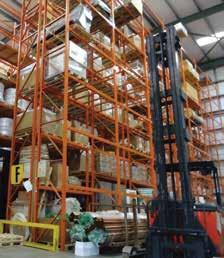
At Cronin Group we prioritise client satisfaction. Our dedicated team works closely with clients to understand their unique requirements and deliver tailored solutions. Transparent communication, regular updates, and a commitment to exceeding client expectations are at the core of our client-centric approach.

Cronin Group adheres to the highest industry standards and regulations. Our facilities are compliant with relevant storage and safety norms, ensuring that your goods are stored in a secure and legally compliant environment.
We understand the importance of cost-effectiveness in business operations. Cronin Group offers competitive pricing models, providing value for your investment in storage solutions. Clear and transparent billing, with no hidden fees, ensures that you can budget effectively and make informed decisions.
Cronin Group is committed to sustainable practices. Our storage facilities incorporate environmentally friendly initiatives, contributing to a greener and more responsible approach to logistics.
In conclusion, when it comes to storing your goods, Cronin Group combines cutting-edge facilities, security, personalised solutions, and a client-centric approach to deliver unmatched excellence. Choose Cronin Group for a storage partner that goes beyond the ordinary, ensuring the safety, efficiency, and success of your business logistics.
As the world becomes increasingly more data-driven, data protection laws continue to evolve. Individuals have the right to know where their personal information is shared and the onus is on businesses and organisations to ensure client data is protected.

All businesses and organisations must be GDPR (General Data Protection Regulation) compliant if they collect information about living people. This includes businesses that capture people’s data to send out newsletters or offers, websites where people submit their details to make a purchase, and organisations where people’s data is crucial to provide a service, including organisations such as the HSE, utilities providers and technology services.
Other entities which must also be compliant include social clubs, societies, unions, educational facilities and political parties. GDPR applies to businesses and organisations of all sizes including those which operate solely online.
The GDPR was adopted on 14 April 2016 and became enforceable throughout the EU beginning on 25 May 2018. As the GDPR is a regulation, not a directive it is directly binding and applicable, and provides flexibility for certain aspects of the regulation to be adjusted by individual member states.
The regulation also applies to organisations based outside the EU if they collect or process the personal data of individuals located inside the EU. The regulation does not apply to the processing of data by a person for a purely personal or household activity and thus with no connection to a professional or commercial activity.

Specific rules apply to the use of direct electronic marketing where an individual is targeted based on their data by a marketer to promote goods and services.
As a rule, direct marketing can only be used if a subject has opted in or given consent to receive marketing communications. At the point of submitting their data, the subject should be provided with a clearly marked opt-out tick box and any subsequent communications should be given an easy opportunity to opt out of future communications.
Marketers should also ensure that the goods or services they are promoting using direct marketing are their own and not those of a third party and that the product or service is similar to that which was sold to the customer at the time they provided their contact details
The Irish Data Protection Commission (IDPC) is the Irish independent authority responsible for upholding the fundamental right of individuals in the EU to have their personal data protected. The IDPC is the Irish supervisory authority for the General Data Protection Regulation (GDPR) and also has functions and powers related to other important regulatory frameworks including the Irish ePrivacy Regulations (2011) and the EU Directive known as the Law Enforcement Directive.
While many larger organisations will have the benefit of an in-house data controller, smaller businesses are increasingly outsourcing their GDPR compliance responsibilities to thirdparty providers.
Dataprotection.ie has published a comprehensive series of guidelines for organizations to understand their responsibilities. Information is clearly detailed relating to the rights of data subjects and includes:
Individuals have several specific rights under data protection law to keep them informed and in control of the processing of their personal data.
The data subject rights under the GDPR include the right to be informed if, how, and why a person’s data is being processed; the right to access and get a copy of their data; the right to have their data corrected or supplemented if it is inaccurate or
incomplete; the right to have their data deleted or erased; the right to limit or restrict how their data is used; the right to data portability; the right to object to the processing of their data; and the right not to be subject to automated decisions without human involvement, where it would significantly affect them.
Information provided to data subjects when these rights are exercised must be transparent, understandable and easily accessible, using clear and plain language. The information should be provided in writing, or by other means, including, where appropriate, electronically. When requested by the data subject, the information may be provided orally, provided that the identity of the data subject is clear or can be proven.
It is important to note that these rights are not absolute and are subject to several limitations and restrictions. Certain rights apply to all processing activities, such as the right to information or to access to personal data, whereas other rights only apply in certain circumstances, such as the rights to erasure, restriction, portability, and objection. Both the GDPR and the Data Protection Act 2018 set out limitations and restrictions on these rights.
Where personal data are processed for law enforcement purposes under the LED, data subjects have similar rights, found in Sections 89-95 of the Data Protection Act 2018, which are subject to a range of restrictions. These rights include the right to information, the right to access, and the right to rectification, erasure, and restriction.
To exercise any of these data protection rights, data subjects should first make a data subject request to the data controller. If the controller does not respond or does not allow a data subject to exercise their rights, data subjects may then wish to contact the DPC to make a complaint.
Organisations should be aware of the guidelines relating to GDPR data breach notifications. There are two types of data breach, accidental where data has inadvertently been used incorrectly, such as emailing the wrong person, or deliberate breaches, such as phishing attacks.
All data breaches should be reported to the DPC unless the organization considers the breach as unlikely to prevent any risk to the subject.
“Put simply, we take care of your compliance headaches, allowing you to concentrate on your core business goals,” says Stuart Anderson, Founder and CEO, XpertDPO.

“Hiring XpertDPO as their outsourced DPO can provide all of the expertise required at a fraction of the cost and associated resources of a whole-time employee.”
XpertDPO provides Information Security and Governance services to a diverse range of clients, including in the banking, MedTech and public sectors. Formed in 2018, XpertDPO has physical offices in Dublin, London and most recently Bahrain and in a short space of time the company has accumulated more than 300 clients across various sectors on all five continents.
Whilst the majority of XpertDPO clients are based in Ireland, Mainland Europe and the UK, XpertDPO has a rapidly
growing international footprint with clients in The United States, The Kingdom of Saudi Arabia, Turkey, The UAE, The Philippines, India and Australia.
According to XpertDPO’s Founder & CEO, Stuart Anderson, the company was established as a direct result of the implementation of the EU GDPR. “The primary aim was to build a business that provided expert consultancy organisations that exceeded the delivery and quality of the traditional ‘Big 4’
consultancy businesses,” he says.
“We recognised that there was a gap in the market for this level of service and we have built a multi-disciplinary team who are experts in their field and who command over 50 years’ worth of combined experience in dealing with clients that operate in highly complex industries.
“At XpertDPO, our approach is that the data security function must align with, and be driven by, your business objectives. This is at the core of our ethos. XpertDPO can help you to transform the regulatory constraints of the GDPR and other relevant regulations into opportunities, ensuring that your compliance journey has a positive impact on your existing economic and organisational models. Put simply, we take care of your compliance headaches, allowing you to concentrate on your core business goals.
The XpertDPO team comprises consultants ranging from data protection experts, consultants with expertise in technology law, consultants specialising in information security, penetration testing and vulnerability management and consultants who are experts in SOC2, ISO and PCI DSS certification and auditing.
“Our depth of experience provides an amount of value that other consultancy businesses cannot compete with,” Anderson says. “Our Ethos puts the client at the very centre and our multidisciplinary team are able to quickly understand the issues a client may be experiencing, whether that be a regulatory issue or a tech issue and are able to provide a solution for the issue extremely efficiently.
“Furthermore, XpertDPO understands that many organisations find compliance as a potential blocker. We assist organizations in implementing frameworks that allow and support the business in meeting its strategic goals whilst also remaining compliant, we therefore protect the value generated within and by the organization.”
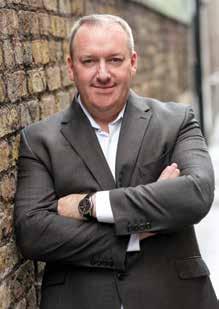
XpertDPO can help you to transform the regulatory constraints of the GDPR and other relevant regulations into opportunities, ensuring that your compliance journey has a positive impact on your existing economic and organisational models.
As of 2023, XpertDPO is the largest provider of outsourced DPO services to the Irish public sector outside of the ‘Big 4’. The company has also won the Public Sector ward for Data Protection Support for the last three years running as well as Best Information Governance Provider in the EU Business Awards and Best Information Governance Service Provider 2023 in the Global 100 Awards.
According to Anderson, the GDPR has brought into focus
the principles of purpose limitation and data minimisation. “In lay man’s terms, it means that in order to process data legally, any organisation must have a defined purpose for that processing and when that purpose has been fulfilled, the data must not be retained for any other purpose and therefore must be destroyed,” he says.
“In other areas, following the HSE Cyber-attack, organisations now have a heightened awareness of why it is important to secure data more diligently than in the past.
Under the GDPR, public sector organisations also have a legal obligation to appoint a Data Protection Officer and the XpertDPO chief points out that some public sector bodies may not have the required internal resources that meet all of the requirements in terms of knowledge and experience, that are required of a DPO under the GDPR.
“Therefore, hiring XpertDPO as their outsourced DPO can provide all of the expertise required at a fraction of the cost and associated resources of a whole-time employee,” he says.
“The Public Sector Cyber Security Baseline Standards that have been introduced in Ireland are the minimum step for all Public Sector bodies to ensure that the data they are processing remains secure. Our consultants have extensive knowledge of the NIST directive upon which the baseline standards are built and can assist all public sector organisations with meeting the baseline requirements.
XpertDPO also provide a unique service to clients in the AI space via the company’s AI Ethics board where it works with AI companies and investment firms to validate the AI offering and to guide and assist the organisation in meeting its ethical and regulatory obligations.
The company has completed a major piece of work for an Irish Regulatory Body around the use of Artificial Intelligence and has recently been engaged to work with the Council of Europe on a European wide project.
The performance of the company since its inception has been highly impressive and turnover and revenue has doubled each year since its formation. It is also fortunate to be among the few companies which were largely unaffected by the Covid-19 pandemic.
“COVID-19 had very little impact on the business. In fact, I would state that the effect was positive. Even though we had offices in Dublin and London at the time, as the world shifted
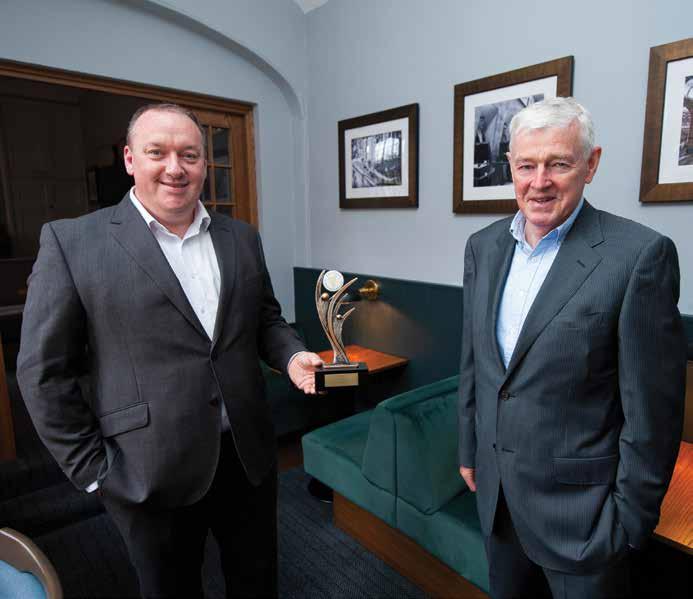
“We assist organizations in implementing frameworks that allow and support the business in meeting its strategic goals whilst also remaining compliant, we therefore protect the value generated within and by the organization.”
to a work from home model, XpertDPO embraced this and we have been lucky enough to hire exceptional talent across a number of geographical locations,” Anderson explains.
“As the lockdown measures have eased, we have retained the decentralised model and realise the importance of employees having a healthy work life balance. In addition, it has allowed me to begin travelling again between the Dublin and London offices, and more recently, opening the office in Bahrain to services our clients in the MENA region.”
“We aim to continue the growth of XpertDPO through the latter end of 2023 and into 2024 and 2025. We plan on hiring another five Data Protection Consultants and Information
Security experts in this time period along with expanding our AI Ethics board. We have partnered with a certification provider in the USA in order to provide consultancy services to the SOC and ISO clients and plan on opening an office in the USA mid2024.
“In addition, we are partnering with a university in the Middle East in order to provide internships to their graduates to bring them to Ireland so that they can gain relevant qualifications and certifications in data protection / cyber security and then return to the Middle East in XpertDPO offices there as the regulatory landscape in MENA aligns with Europe.”


•
•
•
• Advanced Manufacturing Training
•
• Return to Learning courses
•
•
•
•

The rapid proliferation of AI technologies presents both opportunities and challenges across the Public Sector. While AI undoubtedly provides new and unprecedented capabilities, its exponential growth also poses significant challenges, says Kate Colleary, founder and Director of Pembroke Privacy.








The use of AI technology is rapidly expanding across the globe. The Public Sector is at the forefront of this new technology with models being considered for use case scenarios such as health research, efficiencies in delivering public services, transport and population data analysis.
Clearly, there are both significant benefits and serious risks involved. AI can be used beneficially for cost-savings and efficiency. For example, the Organisation for Economic Cooperation and Development (the OECD) estimates that almost 33% of public servants’ time will be freed up as a result of the adoption of AI in the Public Sector
One of the most urgent requirements is preparing the Public Sector and the wider public for AI integration, according
to Kate Colleary, a qualified solicitor who led the data protection team in a global law firm for many years before establishing Pembroke Privacy, a team of highly experienced data protection consultants who have many years of experience in this specialised field.
This will require effective governance and strategic planning and in this regard Colleary offers some reassurance that the Irish government recognises the transformative potential of AI and is taking proactive measures to harness its benefits while also mitigating any potential risks. This has been demonstrated by the recent establishment of the AI Council and the launch of The National AI Strategy in 2021 which aims provide direction on harnessing AI as a positive force for transformation in Ireland.
“In fairness, I think the government is trying to get ahead of the curve with its AI strategy and it has taken a number of important measures, particularly in appointing the AI Council, which features a number of AI experts, including an AI governance expert, Emma Redmond, who is the DPO for ChatGPT and OpenAI,” Colleary says. “It’s a good idea to get some experts around a table who can advise the government on best practice and what we need to do in order to leverage the huge power of AI for the benefit of the Public Sector and wider society.
“The Council’s function is to advise the government on these issues, on how to use AI to help society but at the same time to balance the risk. That’s going to be really interesting to watch. They only just met for the first time in February, so it is still very nascent at this point. The composition is interesting, they have some legal experts, they have lots of academics but not so many people from private practice and I’m surprised that there aren’t more commercially focused people. It seems to be very much weighed in favor of academics.”

algorithms and will know what content we want to appear in our social media timelines, more than we know ourselves. That isn’t something that’s happening 10 or 15 years down the line, it’s happening now.”
The development of a National AI Strategy represents a pivotal step in Ireland’s preparedness for AI integration and by prioritizing governance, ethics, and societal impact, Colleary says that the National AI Strategy will help ensure responsible AI deployment across the Public Sector.
Chief among the challenges facing the Public Sector in relation to AI adoption, is the need to vet third-party suppliers, review tenders, and ensure transparency in AI procurement processes. Managing supplier relationships and addressing potential biases in AI systems is another key issue for Public Sector organizations. In addition, the rapid pace of technological change will require Public Sector professionals to remain vigilant and adaptable in the face of evolving AI risks and opportunities.
Organizations are increasingly incorporating AI tools and platforms into daily operations, a trend evident from ChatGPT’s large language model, which has seen widespread adoption in both Public and Private Sectors. Nonetheless, the full impact of AI is yet to be realised and concerns about its potential for job displacement and exacerbating social division will need to be countered by proactive governance and effective risk management strategies.
“I think it was November 2022 or maybe even later, when ChatGPT was first made available to the public, the public facing beta version of it,” Colleary recalls. “And because it is publicly available, businesses can then commercialise it to make it focus on a certain area. We now have legal services AI models, research AI in certain sectors and you can go online and use AI to plan out your perfect holiday.The use cases are growing daily and the use of AI is becoming ubiquitous.”
“At Pembroke Privacy, when considering AI, our focus is looking at governance frameworks and how to manage the risks that AI presents.
“One of my main concerns as we begin to see the use of AI or recommender systems in social media, is the potential for exponentially increasing polarisation in society. That is my big fear; that what we have seen in social media in terms of the impact it can have on elections and on society generally will escalate. We’re starting to see greater civil unrest worldwide and I’m not saying that’s caused by AI, but I think using AI recommender systems means that people will increasingly be in their own bubble, seeing content that the system believes they are interested in. So they may not see contrarian views. This worries me as people may become increasingly polarized in their beliefs”.
“If you take today’s recommender system model, and put it on steroids, that’s where we’ll be in a couple of years because the recommender systems are going to be based on AI
According to Colleary robust governance frameworks, including risk assessments and compliance mechanisms, will be essential for managing AI-related risks and ensuring accountability. Effective governance will also require a multifaceted approach encompassing a strong regulatory framework and a significant rollout of training and upskilling programs.
“The Public Sector is going to have to become familiar with undertaking these risk assessments, and it’s going to have to become familiar with assessing third party vendors, and not necessarily only those who are selling AI systems directly into the Public Sector, but existing suppliers to the Public Sector or new suppliers and tender processes which in turn use AI systems that could have impacts on the users and the work the Public Sector is undertaking.
“The Public Sector needs to be looking at tender teams, legal teams and risk compliance and a lot of this responsibility falls at the door of the Data Protection Officer (DPO), because they’re used to carrying out risk assessments in technological areas. Many of them are going to be tasked with undertaking risk assessments for AI systems, which aren’t just privacy or data protection focused, it’s wider than that.
“We have to become a bit more philosophical, and we have to look at societal risk. We have to look at much wider risks to the fundamental rights of individuals. And that’s the training that I think the Public Sector will have to undertake to enable them to carry out those risk assessments.”
As artificial intelligence (AI) continues to reshape industries and public services, the importance of comprehensive AI training for Public Sector professionals cannot be overstated. Training programs tailored to the specific needs of Public Sector professionals offer valuable insights into AI risk assessment, governance frameworks, and ethical considerations and ensure that the relevant personnel keep pace with emerging trends and best practices.
In the Public Sector, where the stakes are particularly high, Pembroke Privacy’s expertise in AI governance is invaluable. Public Sector organizations which are frequently underresourced and subject to strict budget constraints can avail of Pembroke Privacy’s training programs to empower their data protection officers (DPOs) and other stakeholders with the knowledge and skills needed to navigate AI-related challenges.
In collaboration with the International Association of Privacy Professionals (IAPP), Pembroke Privacy, offers comprehensive training and certification programs aimed at equipping professionals, particularly in the Public Sector, with the skills necessary skills to navigate the complex landscape of AI governance. By offering specialized training tailored to the unique needs of the Public Sector, Pembroke Privacy enables organizations to effectively manage AI risks and ensure compliance with regulatory requirements.
The firm’s training courses cover a wide range of topics essential for AI governance professionals. Participants learn about the fundamentals of AI, its development lifecycle, AI governance frameworks, risk assessment methodologies, and regulatory compliance. The courses also explore current and emerging laws and regulations governing AI deployment, providing participants with a comprehensive understanding of the regulatory landscape.
Pembroke Privacy’s partnership with the IAPP demonstrates its commitment to excellence in privacy and data protection. Through this partnership, Pembroke Privacy plays a pivotal role in advancing the profession and promoting best practice. By leveraging the IAPP’s internationally recognized certification programs, Pembroke Privacy ensures that participants receive comprehensive training aligned with global standards.
“In Pembroke Privacy, we partner with the IAPP, which is the International Association of Privacy Professionals, and I’m honored to represent the IAPP as its country leader here in Ireland.
“What IAPP has endeavored to do is to create an AI governance program to help DPOs and data protection professionals tasked with carrying out AI risk assessments. And they have launched a two-day training program that leads to a certification in AI governance. It’s not the techie coding stuff, rather it’s about how to create an AI governance program in our Public Sector, and how to undertake risk assessments. How do we properly understand the risk? What are the things we should be considering?
“It’s a training program to support Public Sector DPOs in AI governance, essentially. We look at how AI is developed, it’s life cycle,how to implement AI projects and systems and how to undertake a proper risk assessment. What should we be considering? What does an AI governance program look like? It also examines current laws and in Europe. We have the AI Act which has just been approved by the European Parliament. There’s also various presidential orders in the US coming out as well as further AI initiatives in the UK. So, we are seeing new laws emerging and then we also look at the future and what might be coming down the line.”
Central to Pembroke Privacy’s mission is the promotion of responsible AI deployment. One of the key challenges in AI governance is addressing the fear factor and mitigating biases inherent in AI systems. Pembroke Privacy’s training programs provide participants with practical strategies for identifying and mitigating biases in AI algorithms. By emphasizing
the importance of ethics, transparency, and accountability, Pembroke Privacy’s training programs empower organizations to develop AI systems that align with societal values and respect fundamental rights. Through robust governance mechanisms and rigorous risk assessment processes, organizations can mitigate biases, ensure fairness, and uphold the principles of responsible AI deployment.
“We have to put in guardrails, we have to put in controls,” Colleary stresses. “I think IT professionals will be familiar with this in terms of the controls that we would build into an AI system to manage those risks. When considering bias, we’ve heard the stories about recruitment bias where, for example, predominantly certain types of men ended up being interviewed for jobs because the AI had taken the information that’s available on the web and used it to determine what a top engineer looks like. We’re seeing bias across the net constantly and we have to be very careful, almost like parents, to guide the AI in this respect.
To support organizations in addressing AI-related risks, various frameworks have emerged to provide guidance and best practices. Notably, the National Institute of Standards and Technology (NIST) framework offers a comprehensive model for assessing and managing AI risks. By leveraging established frameworks, data protection professionals can enhance their preparedness and develop robust governance mechanisms aligned with industry standards.
In addition, the AI Act represents a significant milestone in shaping the future of AI governance. The AI Act provides a clear regulatory framework for organizations to adhere to and clarify their obligations and responsibilities in relation to AI usage. This legislative clarity is expected to galvanize action among boards, management committees, and regulatory bodies, spurring organizations to prioritise AI governance and risk management initiatives.
According to Colleary, the AI Act has far-reaching implications for organizations operating in the Public Sector. By establishing clear rules and requirements for AI usage, it will promote transparency, accountability, and ethical stewardship. Organisations will be required to conduct thorough risk assessments, implement robust governance mechanisms, and ensure compliance with regulatory obligations. Moreover, the Act promotes innovation by providing a supportive regulatory environment conducive to responsible AI deployment.
“We’re starting to see emerging frameworks that we can use. I would say to Public Sector DPOs and others tasked with this type of work: You’re not on your own, you don’t have to make this stuff up, there are resources available. There are frameworks already available that can help support DPOs and Privacy Pros in developing their current risk assessment process to include AI risk. There are various models available, various frameworks that you can use for support in looking at the governance frameworks currently in place in your organisation and then developing them out to include AI risk as well.
“The AI Act also galvanises action and given the eye watering level of fines for non-compliance, we are going to see board members , management committees in the Public Sector developing more comprehensive strategies in relation to AI management and oversight. I think the AI Act is the catalyst for a significant escalation in our strategies and planning in response to the opportunities and challenges presented by AI.
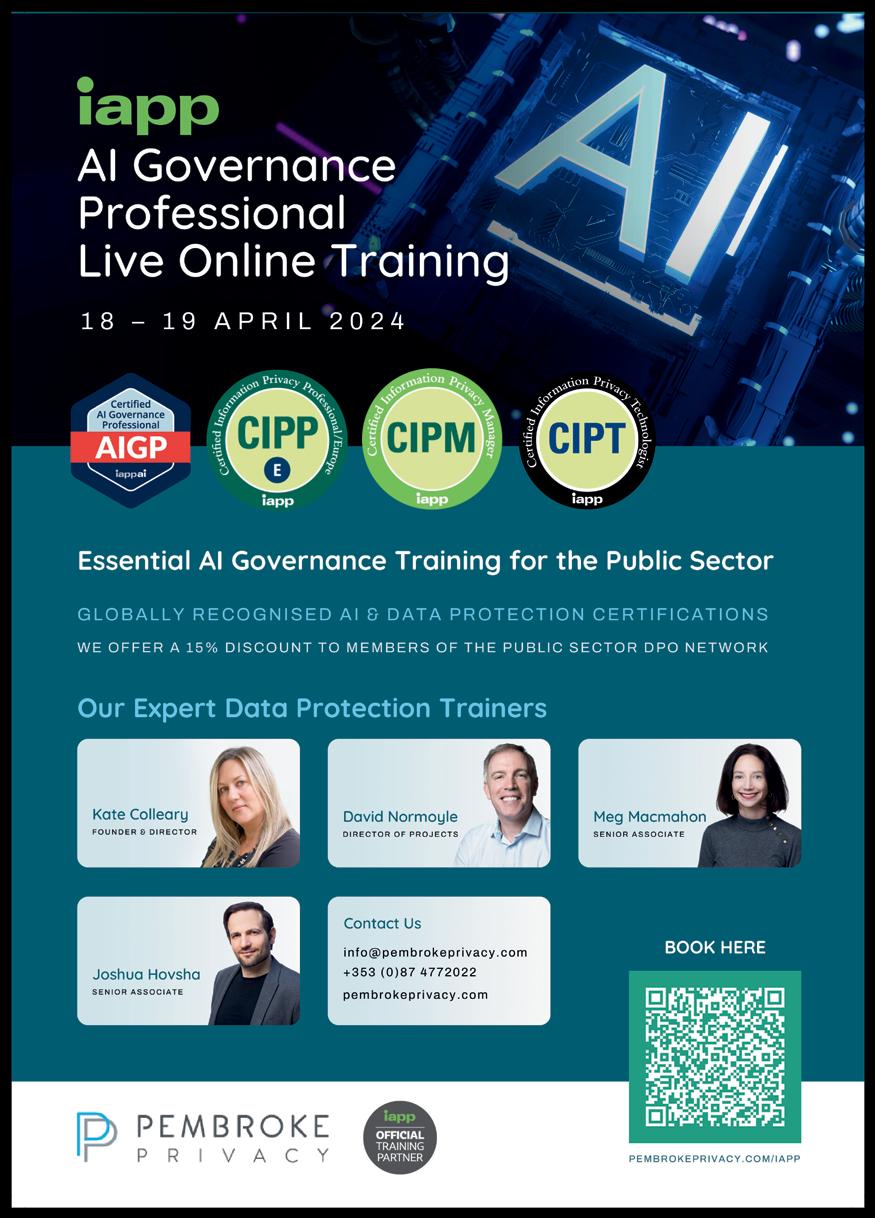













Becoming more sustainable is the right thing to do for your business, your customers, and your planet. It also means that you can attract talent and investment, reduce your costs, and meet the standards of international customers. Irish companies like KORE Insulation are already seeing the bene ts.
Sustainability starts with making a plan. Enterprise Ireland is here to help, with the support, advice and funding you need to reduce your carbon footprint.
Start your sustainability journey today at enterprise-ireland.com/sustainability
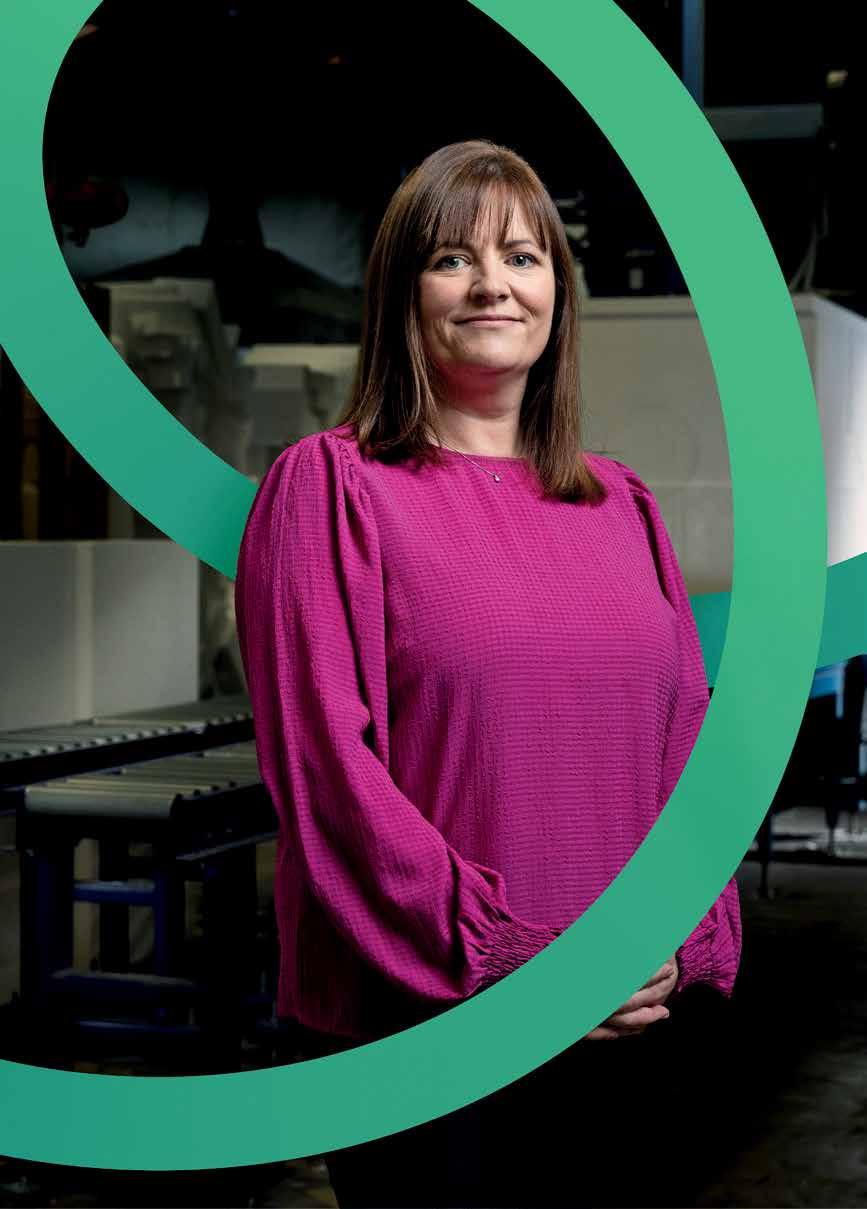




The world needs “trillions” of dollars to spur on the green transition and tackle global warming, according to Sultan al Jaber, the head of last year’s COP28 climate talks who has warned that political momentum can evaporate without clear action.
The UN-backed climate finance expert group has estimated that emerging economies except China will need to spend around $2.4 trillion a year by the end of the decade.
COP28 president Sultan Al Jaber hailed progress made at UN negotiations last year in Dubai, where countries agreed to triple global renewables capacity this decade and “transition away” from polluting fossil fuels.
However, critics say the deal lacks important details, particularly in relation to funding, putting the onus on this year’s COP29 meeting in Azerbaijan. With impacts accelerating as global heat records are smashed, experts say that funding agreed this year will also play an important role in encouraging governments to toughen up their decarbonisation targets.
Mr Jaber said finance was “the key enabler of positive change at the speed and scale” needed. “But not normal scale financewe need finance at every level,” he said, at a recent event in Paris organised by the International Energy Agency (IEA).
This year countries are expected to agree a new target for the amount of annual support rich nations will provide to poorer ones for their energy transitions and adaptation to climate impacts from 2025. The failure of wealthy nations to meet their previous goal of $100 billion per year by 2020 has soured trust, with indications the target was likely reached only in 2022.
Needs already far outstrip the money available. The UN-backed climate finance expert group has estimated that emerging economies except China will need to spend around $2.4 trillion a year by the end of the decade.
“The world must now raise the bar to address the challenge we face,” Mr Jaber said. “We need to start thinking trillions, not billions.”
Recognition of the scale of support needed has put the focus on expanding sources of funding.
The World Bank and International Monetary Fund are under pressure to initiate sweeping reforms to align their lending with the Paris deal goal of capping global warming at 1.5C above preindustrial levels. Other initiatives under discussion include new taxation, especially on polluting industries, as well as redirecting fossil fuel subsidies into green development.
The United Arab Emirates, Azerbaijan and the 2025 COP host Brazil are launching an initiative to maintain global focus on keeping the 1.5C goal alive and Mr Jaber warned that there was a risk that “political momentum can dissipate and then fade away or disappear between COPs”.
IEA chief Fatih Birol said the energy agency, which has become a key player in promoting the energy transition, would offer countries help to beef up emissions-cutting targets, with enhanced decarbonisation plans expected this year and in 2025. He also announced a new mechanism from 1 March to measure the gap between countries’ goals and the actions being taken.

“We trust the governments that they will do what they said they will do, but at the IEA, we believe in numbers,” he said.
In Ireland, the cost of meeting climate targets in full may cost the state up to 5.5 billion euros ($5.8 billion) a year or 2% of modified gross national income from 2026-2030, according to a recent estimate by the independent fiscal watchdog.
The impact will be felt through an erosion in tax receipts from a shift away from fossil fuels and increased public spending, mainly on compensating farm incomes and retrofitting older homes, the Irish Fiscal Advisory Council (IFAC) said.
Ireland was one of the few euro zone economies to post a budget surplus last year, and the government has pledged to set aside the majority of large projected future surpluses in a new sovereign wealth fund that could meet costs linked to climate change and an aging population.
The proposed fund would probably only help with costs beyond 2030 and IFAC urged the government to start planning sooner, noting that tax and spending forecasts only go out to 2026.
The climate costs also come on top of the 7-8 billion euros a year the finance ministry estimates will be needed by 2030 to fund rising pension costs.
The watchdog estimated that assuming no policy changes, tax revenues could fall by 2.5 billion euros per annum by 2030, rising to as much as 4.4 billion or 1.6% of modified gross national income (GNI*) in the long run.
That will be primarily due to a sharp decline in tax on fuel and energy use, the lower VAT rates on electricity, and reductions in vehicle registration tax and motor tax.
It said projections on public spending are highly uncertain and depend on the extent of private sector involvement, but that the government may face costs of between 0.6 and 1.1% of GNI* or 1.6 billion to 3 billion each year from 2026 to 2030, falling to 0.4 and 0.7% of GNI* from 2031 to 2050.
With Ireland currently forecast to miss its EU targets to cut greenhouse gas emissions by 51% by 2030, IFAC added that non-compliance costs could reach 3.5 billion euros by the end of the decade.
Supporting Ireland’s future energy security.

The story of Bord na Móna is interwoven with the history of Ireland itself. From its origins, 90 years ago as the Turf Development Board, securing fuel and rural employment through the harvesting of peat, it has constantly evolved to meet the country’s energy needs. The Bord na Móna of 2024 is a climate solutions company that has come full circle; supporting enhanced security of supply for Ireland’s energy once again through 21stcentury renewable sources that will power a net-zero future.
Fossil fuels powered the Industrial Revolution, the biggest leap forward experienced, up to that point, in the history of humankind. After many decades, we began to realise that the industry which we relied upon to power progress, was also creating changes in our climate that were proving catastrophic for the environment, biodiversity, food production and the security of basic resources. A change had to happen, a transition away from human activity damaging the planet, to one where our species could live in a more sustainable manner.
At the height of fossil fuel consumption, Bord na Móna owned and managed over 80,000 hectares of land, employed in the region of 7,000 people ,supplied peat to a number of the country’s power stations, operated four briquette factories, and
managed a private rail system larger than the national network run by Iarnród Éireann.
To contribute to Ireland’s ambitious goal of reaching carbon neutrality by 2050, Bord na Móna needed to rethink how it would power Irish homes into the future whilst transitioning away from peat to more sustainable energy sources.
John Reilly has been working in the energy sector for over 25 years and at Bord na Móna for 17 of those, where his current role is Head of Renewables. He is a passionate advocate for the transition away from fossil fuels to renewable energy and understands the challenges such a fundamental shift in energy production creates.
“This energy transition has been going on for nearly 20 years within Bord na Móna, accelerating our exit from peat over the last decade or so. In 2018 we established our “Brown to Green” strategy, which was the final step in the journey of taking peat out of our business, out of the Irish economy, and importantly out of the Irish energy mix.”
The Brown to Green strategy has proved to be extremely successful with the company formally announcing an end to peat harvesting in January 2021, and the last tonne of peat burned for electricity generation in December 2023.
In recent years, the war in Ukraine, and growing global geopolitical instability have highlighted the need for countries
to secure their future energy supplies.
John explains how Bord na Móna’s Brown to Green strategy is ultimately helping Ireland gain energy independence: “By transitioning to renewable energy, we are killing two birds with one stone because the vast majority of renewable energy that we have in our portfolio, and that Ireland will use going forward, is Indigenous. So, aside from supporting our national climate challenge goals, increasing renewable penetration, and taking fossil fuels out of the energy mix, we are enhancing energy security by focusing more on increasing energy supply from indigenous forms of generation.”
The transition has meant that the company needed to reassess how to use 80,000-plus hectares of land now that is no longer needed for peat harvesting. As John highlights, this actually provided the company with a positive competitive edge over other climate solutions and energy companies: “Bord na Móna’s land bank presents an enormous opportunity. We did not have to acquire land to grow our business and that gives us a unique strategic advantage allowing us to grow organically, whilst supporting the State.”

know when energy from battery storage, amongst other technologies, is needed to balance supply and demand. The digitalisation of the power system and the significant advancement in supporting flexible technologies is key to driving the penetration of renewable technologies required to meet our climate and energy security challenges in a sustainable way. Technology advancements and deployment mean that we are using technologies today that would have been a pipedream just two decades ago.”
As an example, Solar PV technology has increased significantly in efficiency in the last five years and PV technology is more focused on light rather than the sun itself, and daylight is a commodity that can be leveraged in Ireland right through the year. Driving all these technologies are powerful digital platforms which are constantly tweaking and refining output to ensure that energy systems can deliver clean power reliably on a millisecond, or indeed on a microsecond basis. In today’s world, it is that reliability of supply that is crucial for communities and businesses.
This “rethink” about the company’s land usage has resulted in a plan that brings a wealth of benefits for Irish energy supply, industry, the environment, and rural communities. John continues by proudly stating that: “Our plan to focus on delivering renewable energy projects of scale, is beginning to come to fruition, and it gives myself and the team a great sense of motivation, knowing that together we’re making a positive contribution to the biggest challenge facing the world today.”
Bord na Móna’s plan for its land bank is no doubt ambitious and, as John explains, is driven primarily by climate action and energy security goals; “It is all focused-on driving climate solutions. So, by 2040, Bord na Móna could have up to three gigawatts of renewable assets installed on its land bank that will be co-located with wetlands and rehabilitated elements of peatlands.”
Ireland has pledged to generate 80% of its electricity from renewable sources by 2030 and Bord na Móna is supporting that goal with its growing portfolio that currently holds a gigawatt of generating assets, dominated by renewable technologies. The company is now the largest producer of renewable electricity in the Irish market with the biggest portion of that generation coming from wind turbines that make the most of the island’s healthy onshore winds. Solar, biomass, and biogas all contribute to rounding out Bord na Móna’s renewable energy portfolio.
Green technology is evolving fast and, as John points out, “What we are doing with wind and solar technology today, we could not have done 20 years ago. Accurate weather forecasting is one of the advances that allow wind and solar farms to operate to maximum efficiency; knowing what the wind and sun are doing from hour to hour enables the company to
Biomass is another important form of energy in the renewables mix; it involves the use of sustainable organic residues from forests as well as energy crops to power generators. The vast majority (approximately 80%) of biomass Bord na Móna currently uses is Indigenous, coming from within a 100-kilometre radius of their Edenderry Renewable Energy Complex. Ensuring the biomass used in power generation is coming from sustainable sources is a key consideration for Bord na Móna and compliance with a range of internationally recognised certification schemes ensures all the biomass used meets Bord na Mona’s sustainability goals.
One of the interesting challenges with renewables is that at certain times they produce more energy than is required and, although modern battery technologies are used to store some of the surplus, there are other ways to capture and store this valuable excess clean energy. Bord na Móna is embarking on a project that explores an innovative solution, whereby excess energy produced by wind turbines overnight is converted on-site into green hydrogen which can then be used to produce energy at times when renewable output is low, and demand on the national grid is high. Bord na Móna secured planning permission to develop this green hydrogen production facility in 2023, and it is hoped to commence construction later this year.
Leveraging existing and emerging renewable energy technologies to achieve a climate-neutral future requires partners, and Bord na Móna knows that forging partnerships with government, industry and communities is crucial for success. In 2022, the company announced one such partnership with a leading developer of offshore wind, Ocean Winds, which aims to deliver enough energy to power two million Irish homes by 2030. Partnerships like these allow the company to bring in investment, as well as technologies and skills that may not currently exist within the business.
One concept Bord na Móna is exploring that will rely on

such partnerships is that of Bord na Móna Energy Parks, which will be powered by an array of different renewable technologies. The co-location of large energy users with zero-carbon generating technologies is possible in a number of strategic locations across Bord na Móna’s landbank. The idea is that large industrial companies of various types would be invited to relocate to the zero-carbon parks to form a symbiotic energy cluster, where the key objective would be for these industries to decarbonise their energy consumption. So, for example, excess heat from a data centre powered exclusively by renewable electricity, could be used to generate steam in an agri-food manufacturing facility next door, which would generate organic waste from its manufacturing processes that could be then used onsite to feed an anaerobic digestion facility producing biogas – and so on. If successful, the concept would help industry decarbonise and bring employment into rural economies. This type of energy transition, taking place in a sustainable manner, is the core focus of Bord na Móna’s Energy Park concept.
John himself is powered by his passion and belief in renewable energy, “I tell colleagues new to the sector that you are now working in an industry that is making a real difference. It is making a real contribution to the changes we need to bring about globally to crack this climate challenge.”
To reap all the benefits of renewable energy will require the construction of a lot of new infrastructure and this is where John is committed to honest and open communication between industry, government, regulators, and policymakers surrounding what Ireland needs to do to achieve its climate and energy security goals. Infrastructure development is not always popular with people, but it requires thorough engagement, as it is essential to a climate-neutral, sustainable energy future for all.
Bord na Móna’s plans for renewables are ambitious, yet the amount of land needed to realise these plans is relatively small. 10-15% of the entire 80,000 hectares is required for delivery of much needed renewable energy generation to the Irish energy grid, and the company envisages that the rest can be restored and rehabilitated. The former bogs, where peat has been cut away, are being actively rehabilitated into fen and water habitats, grasslands and reedbeds as well as wet woodlands and restored peatlands.
These rehabilitated habitats are key to increasing biodiversity by allowing a wide array of species to thrive, which
are also incredibly important for the climate. For millions of years, peatlands sequestered carbon from the atmosphere and that ability dwindled as the peat was cut away. In restoring them, the peatlands can sequester carbon once more, working to offset carbon-producing activities elsewhere.
Rehabilitation of this scale requires great expertise and Bord na Móna has a dedicated division within the company employing ecologists, ornithologists and other highly specialised skills needed to restore the land. As a result of their efforts, birds such as the Whooper Swan, Common Crane, Red Grouse, Lapwing and Hen Harrier have returned and, to date, over 900 species have been recorded in the rehabilitated wetlands.
As well as restoring nature and increasing biodiversity, the rehabilitation of the peatlands and expansion of the company’s renewable energy portfolio, has huge direct and indirect benefits for the surrounding communities. Making the peatlands accessible with kilometres of walkways and cycle trails, and the addition of interactive learning centres, fishing lakes and sculpture parks, not only enriches local lives, but also encourages new visitors to areas of Ireland that were not traditionally on tourist routes and that, in turn, can help to create local business and jobs.
Recognising that communities know their own needs better than anyone else, Bord na Móna supports them with Community Benefit Funds which contribute to local amenities and benefit projects in sport and recreation, culture and heritage, environmental sustainability and other social initiatives with local people actively participating in the award and administration process.
Bord na Móna is a company with a long and proud history, which has navigated a journey of significant transformation since its inception. It was created to secure an energy future for Ireland and, after 90 years, its work remains pivotal in securing a new future for Irish people, one where energy is renewable, reliable, affordable, climate-neutral, and indigenous. Where peatland and rural communities are not just restored but given the opportunity to thrive beyond expectation.
John’s final remarks encapsulate the passion Bord na Móna has for this transition, “We’re fully committed to supporting the continued transformation of a sector that is so vital to our economy and it’s something that we need to do, not just for ourselves, or our business, but for all of us in Ireland and I truly love that I can be part of that process.”


One year on from the launch of their Joint Venture, Ocean Winds and Bord na Móna remain committed in their mission to deliver offshore renewable

Ocean Winds (OW) and Bord na Móna launched their joint venture partnership in late 2022 in a collaborative effort to deliver offshore renewable wind energy in Ireland. OW brings a wealth of international experience in the development of offshore wind energy, with a gross portfolio of around 17 GW across 15 projects in 7 geographies. Critically, OW has been involved in all stages of the development, financing, construction and operation of projects across its significant portfolio.
“We welcome the recent progression as regards ORE policy in Ireland, however we would strongly encourage that this progression is maintained and accelerated so Ireland does not get left behind. Given that the overall European target for offshore
wind is at least 60 GW of offshore wind by 2030, and 300 GW and by 2050, Irish ORE projects will be progressing in a very competitive supply chain environment both within the EU and globally” says OW General Manager in Ireland, Angela Larkin. With a strategic ten-year ambition to invest €2.5 billion in renewable energy infrastructure and generating assets, including wind, solar, hydrogen, biomass and biogas, Bord na Móna is developing sustainable solutions that will lead Ireland towards a climate neutral future and help ensure the State delivers on its commitment to becoming carbon neutral by 2050. Looking offshore, OW and Bord na Móna have an exclusive partnership to develop offshore renewable energy (ORE) in Ireland.

“From our perspective”, says John Reilly, Head of Renewable Energy at Bord na Móna, “our partnership with Ocean Winds enables us to deliver more affordable, renewable and secure energy for Ireland. 90 years on from our foundation, we recognise that Ireland’s vast offshore wind resource is the next frontier for energy security in Ireland.”
Ireland has ambitious offshore renewable energy targets, aiming for at least 5GW of grid-connected offshore wind energy by 2030 and 20GW installed by 2040.
Government is taking a plan-led approach to the development of offshore wind energy in Ireland, via the creation of ORE Designated Areas and Designated Maritime Area Plans (DMAPs), which will guide investment and decision-making. The first DMAP, off Ireland’s South Coast, is due to be published in 2024, with work to hold Ireland’s second offshore renewable energy auction (ORESS 2.1) in late 2024 also underway.
The partnership with Bord na Móna complements Ocean Winds’ skills in the offshore renewable energy space.
OW is a pure offshore wind developer with over 10 years’ experience in the sector inherited from its sponsors ENGIE and EDPR, and is involved in projects across the world, from stakeholder engagement at the start of the process right through to the operation of offshore wind farms. Ocean Winds brings its international expertise and experience delivering innovative renewable energy solutions to help secure our energy future.
Bord na Móna brings its long and proud 90 year history of serving Irish communities’ energy needs and its expertise in developing renewable energy projects in Ireland as a climate solutions and renewable energy company.
The partnership welcomes and supports the significant progress the Irish Government has made in ORE policy in recent years. The establishment of the Offshore Wind Delivery Taskforce in April 2022 has resulted a cohesive, informed, whole-of-Government approach to the development of offshore renewable energy policy.
ORE poses a significant opportunity for Ireland, with a sea area seven times greater than its landmass. However, there are important challenges which Ireland will need to address if it is
to achieve its targets. Infrastructural issues, such as sufficient port capacity, as well as the development of an indigenous supply chain, and a marine planning regime that provides flexibility for complex ORE developments, are critical hurdles for Ireland to overcome if it is to achieve its objectives by 2030.
The imminent publication of a South Coast DMAP, is a positive step which will further Ireland’s progress towards achieve its renewable energy targets. Ireland should seek to develop an East Coast DMAP, for bottom-fixed technology, as soon as possible to ensure our targets remain on track. In Ireland, OW and Bord na Móna see there is great potential for bottom fixed on the east coast, with shallower waters, more suitable seabed conditions, and positioned closer to Ireland’s main energy demand centre, therefore providing the lowest cost option to the consumer.
In November 2022, then Tánaiste and Minister for Enterprise, Trade and Employment, Leo Varadkar launched the partnership, describing it as a “momentous step” towards achieving Ireland’s renewable energy objectives. Since then, OW and Bord na Móna have sought to live up to this, by working with Government ORE development and operations.
OW’s significant 6 GW portfolio of ORE projects in Scotland has provided opportunities for Irish policymakers to learn from the experiences of a country with similarities to Ireland, albeit more historically industrialised due to the presence of the oil and gas industry.
In 2022, OW hosted the Oireachtas Committee on Environment and Climate Action to its Moray East windfarm, where TDs and Senators had an opportunity to visit a 950MW ORE project and Operations and Maintenance (O&M) base in Fraserburgh, north of Aberdeen.
In 2023, OW and Bord na Móna hosted a delegation from the Offshore Wind Delivery Taskforce to Moray East windfarm, and to the in-construction Moray West windfarm. Officials from several Government Departments were able to witness a windfarm in operation, as well as one in the complex process of construction.
Later in 2023, the Oireachtas Committee on Environment
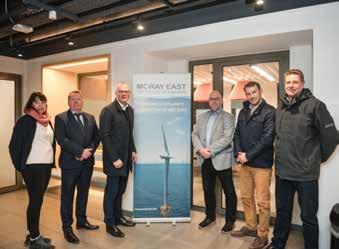
and Climate Action visited OW’s 25GW WindFloat Atlantic project, the world’s first semi-submersible floating offshore wind farm off the coast of Portugal. The visit allowed TDs and Senators to learn about the complexity of floating offshore wind projects in terms of construction and operation, and other challenges related to this technology.
In 2024, OW and Bord na Móna were delighted to host Minister for Enterprise, Trade and Employment, Simon Coveney TD at Ocean Winds’ Moray East O&M base at Fraserburgh and an offshore visit near Aberdeen facilitated by Principle Power. Minister Coveney acknowledged the economic benefits that ORE can have for small coastal communities, as well as the opportunities posed by the development of an Irish supply chain for ORE. Minister Coveney also met with representatives from Farra Marine, an Irish company involved in providing crew transfer vessels, already working with OW on the construction of Moray West.
Back in Ireland, the partnership has collaborated with industry partners, such as Wind Energy Ireland (WEI). OW and Bord na Móna sponsored the WEI Annual Conference Research Poster Event in 2023 and 2024 as well as networking events at WindEurope’s Annual Conference in Copenhagen in 2023 and Bilbao in 2024. In 2023, the partnership opened its offices in Dublin.
The partnership has supported the development of key reports from WEI examining the development of Irish ports to support the construction of offshore wind farms in Ireland. These reports include We Can Build Them: Supporting Irish Ports to Build Offshore Wind Farms and the National Ports Study: September 2022. Such documents are recognised by Government as useful, objective and independently researched policy development aids.
OW and Bord na Móna recognise the power of partnerships. Collaboration and strategic engagement with key stakeholders is key to the delivery of Ireland’s ORE objectives.
ORE offers opportunities for coastal communities in terms of economic development, energy security, and community
“Our partnership with Ocean Winds enables us to deliver more affordable, renewable and secure energy for Ireland”
benefit funds. OW has a wealth of experience in effective engagement with communities immediately affected by the development of offshore wind farms. In Scotland, for example, OW has employed both community liaison officers (CLOs) and fishery liaison officers (FLOs) to keep stakeholders informed, and for them to provide feedback to developers.
Bord na Móna also has extensive experience in community and stakeholder engagement through development and operation of its onshore projects across Ireland. Bord na Móna are industry leaders in this space and for years their community benefit schemes have been seen as best practice within the industry. With two successful onshore wind projects in the RESS-1 auction, Bord na Móna are again leading the way in this space by ensuring their projects community benefit funds and how they are managed are considered as best in class.
In the development of Moray East and Moray West, OW has partnered with academia from the University of Aberdeen to conduct Strategic Marine Mammal Monitoring Plans (MMMPs). This local partnership informed the development of the windfarm and benefitted academia with access to valuable data and funding.
OW’s experience in Scotland and Bord na Móna’s experience with onshore wind development has informed the approach of the OW and Bord na Móna partnership in Ireland. Prior to the Irish Government’s announcement of a shift to a plan-led, DMAP approach in 2023, the partnership had performed considerable engagement with communities and fishers in Dublin, Wicklow, Wexford and Waterford in relation to its two legacy windfarms in Ireland.
Now, the focus has shifted to the development of offshore windfarms within DMAPs, and the partnership has committed itself to maintaining relationships and keeping stakeholders informed of the latest developments in Government policy.
Ireland finds itself at the beginning of its ORE journey, with a considerable opportunity for growth. As part of the North Seas Energy Cooperation Group, Government knows that Ireland will have to compete with other EU Member States, and with jurisdictions further afield for ORE development. Constraints around port capacity, grid development, and supply chain will be felt all the more given the increased demand globally for ORE. For Ireland to achieve its renewable energy targets, Government must act at a greater pace.
Beyond this, the Ocean Winds and Bord na Móna partnership is committed to delivering offshore renewable energy to secure Ireland’s energy future. However, there are significant challenges to be overcome in achieving Ireland’s target of 5GW of ORE by the end of the decade. Nevertheless, the partnership is committed to collaboratively furthering the development of ORE in Ireland. Given OW’s extensive international experience and Bord na Móna’s local knowledge and legacy, the partnership is uniquely placed to deliver it.

Environmental, social and governance (ESG) questions are at the top of business agendas worldwide. Matheson’s ESG Advisory Group has the tools and legal expertise to help you navigate the implications for your business.
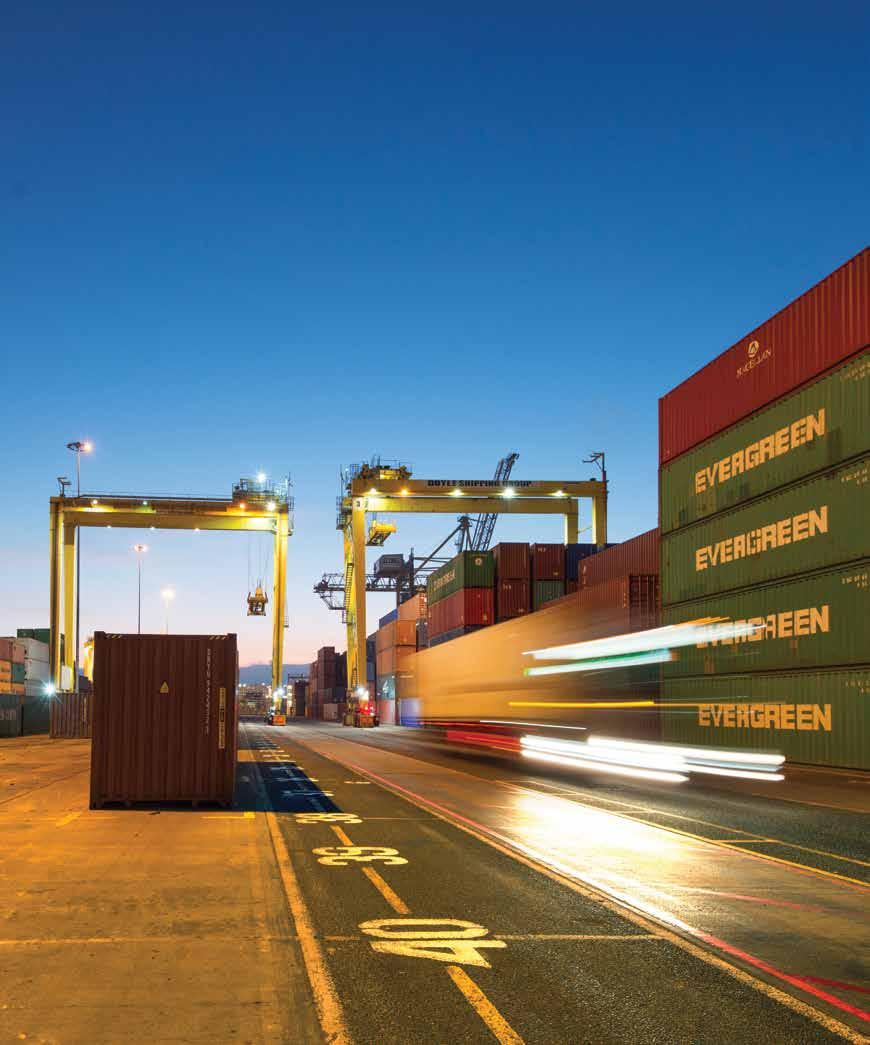
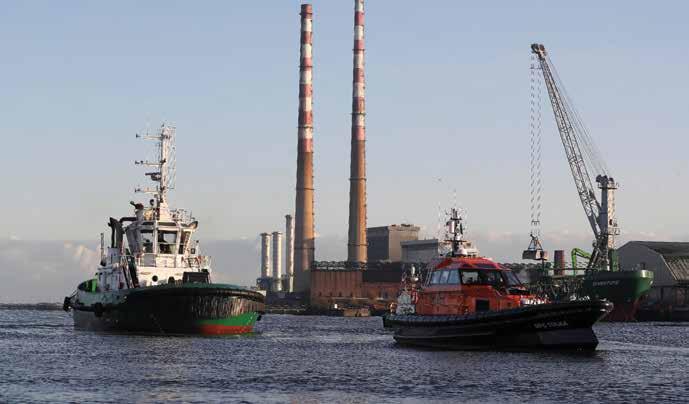
“The use of Hydrotreated Vegetable Oil in our Pilotage services has been a great success,” says Ken Rooney, Head of Engineering and Sustainability at Dublin Port Company. “After a series of comprehensive trials, we are pleased to announce we are now phasing out marine diesel in favour of HVO in our Pilot Boats.”
Hydrotreated Vegetable Oil (HVO) is a low-carbon renewable fuel which functions seamlessly in diesel engines. While HVO can be mixed with diesel, Dublin Port Company (DPC) will operate its pilot boats on 100% HVO fuel.
The Pilotage Service is a crucial aspect of Port operations, making 10-15 returns trips per day. The job involves the transfer of a Pilot to a ship by driving a Pilot Boat alongside the moving ship as it enters the Port. As this is a high-risk activity, Pilot Boats are considered safety critical equipment and require high reliability. DPC’s trials determined that HVO fuel had no adverse impact on the operation of the Pilot Boats, and the service could continue to its high standard using HVO.
Certa, DPC’s contracted fuel service provider, confirmed an 89% reduction in greenhouse gas emissions on the Pilotage service during its trials. A full switch to HVO in its Pilot Boats reduces DPC’s carbon emissions by up to 15%. A current trial aims to extend HVO fuels to DPC’s fleet of tugboats, which we
estimate should lead to a further 15% drop in emissions.
“HVO is a key pillar of our initial decarbonisation strategy, but it’s one of a few ongoing initiatives to create a more sustainable Port,” says Rooney. “It’s key to examine DPC’s footprint on land as well as sea – we’re upgrading our light goods road fleet to fully electric vehicles, and we hope to retrofit our headquarters, Port Centre, into a near-zero emissions building.”
“We are hard at work to ensure the Port reaches its full operational potential and green energy alternatives are at the heart of that,” says Barry O’Connell, Chief Executive of Dublin Port Company. “Our energy team has done great work to progress their HVO initiative from initial trials, which were carefully monitored to ensure a top standard of performance, to a fully operational HVO Pilotage service which we can expand further into our towing fleet.”
“As part of our Masterplan Project, we’re also future-proofing our quay walls, and we’re in talks with ESB networks on how to enable onshore power supply (OPS), which facilitates reduced emissions from vessels at berth in the Port. As we conceptualise what the Dublin Port of 2040 will look like, the Port Company must act as a leader, both by example and by directly facilitating sustainable solutions throughout the Port estate.”
By taking the lead in embracing sustainable energy practices, the public sector not only helps to mitigate climate change but also inspires citizens and businesses to join the movement towards a sustainable future. Declan Meally, Sustainable Energy Authority of Ireland (SEAI), discusses the critical importance of the public sector’s transition to a low carbon future and the pivotal role played by SEAI in facilitating this transition.

The public sector has a vital role to play in Ireland’s pursuit of a sustainable energy future. By adopting a leadership position and implementing stringent energy efficiency measures across its operations, the public sector not only demonstrates responsible environmental stewardship but also catalyses widespread adoption of sustainable practices.
SEAI has been actively collaborating with the public sector since the initiation of the Public Sector Energy Efficiency Program in 2010, which focused on monitoring and improving energy efficiency across public sector organizations. For the period to 2020, the primary emphasis was on energy efficiency and annual reports have been compiled as part of the program in order to track energy usage across various sectors and monitor progress.
According to Declan Meally, Director of Business, Public Sector and Transport and a member of the Executive Leadership Team in SEAI, a 33% target for energy efficiency improvement by the end of
2020 was established for the public sector, which was successfully achieved. While the efficiency gains were significant and helped set an example, the focus has now shifted to decarbonization which places the emphasis on reducing fossil fuel consumption and transitioning towards clean, renewable energy sources.
“Initially our main focus up to 2020 was on improving energy efficiency; to really ensure that the public sector provided better and more energy efficient services without an increase in energy. That was the big focus but now the challenge is to go it’s going deeper in terms of decarbonization, which takes it a step further. Decarbonization essentially comprises two steps: using less energy and using clean energy. So firstly, we have concentrated on shrinking the demand and now it’s about shifting it towards a renewable supply.”
While progress has been made, concerted efforts and collaborative action are needed to accelerate the pace of change
and achieve the 4% annual reduction in emissions which has been required since 2020. We continue to lag behind this target and Meally says radical change is required across the public sector in order to drive meaningful progress, and transition away from fossil fuels, which are having a detrimental impact on the climate. .
“It has gone in the right direction but it’s just not going fast enough and that’s the challenge we face.. We need radical changes in how we do our business. It’s not just about business as usual and doing a little bit better and a little bit better. We have to radically change what we need to do. And the public sector is just one sector. We have to do it in industry, we have to do it across transport and in our homes. The public sector, in particular, has to focus on the heat in our buildings, because that’s the most significant contributor to its carbon emissions for the public sector.

“The carbon budgets are set out in two five-year tranches, covering from 2020 to 2025 and from ‘26 to ‘30, and while we have been reducing energy use, we haven’t been reducing the emissions by as much as we should be. Like many sectors we got a benefit, because of Covid-19, because we weren’t using as much heat in our offices, but it bounced back a bit in 2021. We saw a further reduction in 2022 because we pushed out the ‘Reduce Your Use’ program, which provided great examples of what is possible..
“The opportunities are still there, but we should have been achieving a 4% per annum annual reduction in emissions since 2020 and we have only done about 4% overall. We’re behind the curve and we need to accelerate action. That’s the case for every sector. We’re seeing some reductions, but we’re not seeing nearly enough reductions in order to work within the budgets that have been assigned by the government and that are legally binding for us from 2020 to 2025.”
There is a pressing need for the public sector to prioritise the reduction in fossil fuel usage and embrace renewable energy sources and significant changes in business practices will be required. Collaboration among key stakeholders, including government departments, schools, universities, and local authorities as well as the health sector, is crucial in implementing sector-specific solutions, according to Meally.
“Fossil fuels are the biggest cause of emissions in Ireland. We’re releasing too much heat into the atmosphere through our use of fossil fuels, and that’s going out into the atmosphere in the form of CO2. Agriculture is different and releases greenhouse gases in the form of methane from the sheep and cattle and from the nitrogen when spreading the fertilizer on the land.
“So Agriculture accounts for approximately one third of the overall emissions.. The other two thirds are from fossil fuels and that’s why every sector has to reduce and decarbonize their fossil fuel use. My message to the public sector is that their climate and sustainability plans need to be firmly focused on reducing and decarbonizing fossil fuel use which means to use less and to use cleaner energy sources. And as I said, we got really good traction in
doing more for less up to 2020, but we now really need to accelerate this transition to a decarbonized energy system.”
A significant portion of energy consumption in the public sector is attributed to heating buildings and the SEAI Heat Study in 2022 identified sectorspecific solutions tailored to key segments such as hospitals, schools, and office blocks. These solutions range from district heating schemes powered by renewable sources to the adoption of biomass boilers and heat pumps. Hospitals may benefit from district heating powered by renewable sources, while schools could transition to wood chip or wood pellet boilers. Meanwhile, office buildings could leverage district heating or deploy heat pumps for efficient heating. The technology is available now and has been proven to work.
“There’s around 13,000 buildings in the public sector and there’s about 1,000 of those 13,000 buildings that are the really significant users of heat,” Meally says. “Over half the heat used in the public sector is accounted for by 1000 sites, including the main hospitals and university campuses. So, we have a very good idea of the general usage of the big energy users, and we are building better knowledge of the smaller buildings.
“We’ve tasked every public sector organization with detailing and developing a profile of their building stock. The SEAI Heat Study that was launched in 2022 showed that the health and education sectors are the biggest energy users. Offices are next



















“We have been providing funding through our Pathfinder Programme over the last five years to set out these pathfinders for each of those sectors and demonstrate how to really make the building stock more efficient,”
of a district heating scheme for a hospital fed with renewable heat is an excellent solution depending on where a hospital is. It needs heat twenty-four seven, 365 days a year, which needs to be delivered through a heat pump, biomass boilers or even waste heat. That’s where the Ringsend Heat System in Dublin would be ideal in terms of helping to feed into the hospitals such as James’s, Vincent’s and others.
“For the rural schools it is likely that district heating will not be a solution however be out, and rural schools or the larger schools in town that might be on oil boilers, switching that to wood chip or wood pellet boilers has been identified by the Department of Education as a really good solution. And then for office blocks, depending on whether they’re in the centre of Dublin, district heating could be an option. But if they’re well insulated, we could put in heat pumps and then you’re using renewable electricity, deploying the heat pump, and the heat is renewable.”
SEAI is prioritising those sectors with significant energy consumption, which Meally terms the “big five,” and which include healthcare, education, government offices, and local authorities. “There are smaller groups, but they’re the big hitters, and that’s what we need to be going after, the big ones in those areas, and finding those solutions,” he says.
Again, stressing the need for accelerated action, Meally highlights the urgency imposed by carbon budgets as well as Ireland’s legal obligations and the long-term goal of decarbonizing every public building by 2050. In addition, European mandates,
including requirements for solar panels on public sector buildings are likely to become more onerous in the near future.
Acknowledging the substantial effort required for this transition, he references the funding provided through SEAI’s Pathfinder Programme which has been instrumental in showcasing viable pathways for decarbonization across key sectors such as healthcare, education, and government offices. These initiatives, such as retrofitting old schools, are showcasing the most feasible pathways towards energy efficiency and the benefits of decarbonization.
However, Meally also acknowledges the urgent need for
additional resources and internal capacity within the public sector to scale up these efforts effectively.
“We have been providing funding through our Pathfinder Programme over the last five years to set out these pathfinders for each of those sectors and demonstrate how to really make the building stock more efficient,” he says. “We are working with stakeholders, working with the OPW, working with the HSE and we have demonstrator sites to show that this is where we should go and how to actually get there. But given the scale of the challenge this needs a significant increase in funding, and resources right across the sector. There is a need for building a lot of internal capacity in the public sector to be built in terms of technical teams and other resources. The SEAI Pathfinder programme will be necessary to continue to build capacity and maintain momentum however activities will need to grow significantly beyond that if we are to hit our targets.
“While we need to keep working on the big energy using buildings and we also know the huge opportunity there is in terms of demand reduction by being smart about how we use the spaces and by making sure that our buildings and our building management systems are operating as efficiently as possible.” Energy efficiency and reducing our demand is the best and most affordable activity that every organisation can take. However there has to be buy-in across the whole system, right across the public sector. It’s not just down to the ‘green champions’ or it’s not just down to the Minister, SEAI or one department, it has to become everybody’s responsibility. There also has to be overall leadership demonstrated across the sector and clear management demonstration that they are taking this seriously. There’s a willingness there, but sometimes it can be
everybody’s job and yet it ends up being nobody’s job.”
The demand for resources, and skilled labour, is clearly significant and while industries have scaled up in response to funding incentives, the public sector faces challenges in procuring, designing, and implementing these significant projects. A concerted effort is needed to reduce bottlenecks and accelerate project development. Despite these challenges, Meally remains optimistic about Ireland’s potential to meet targets through collective action and proper strategic planning.
He points to the success of the home retrofit programme and says there is the potential for similar schemes in the public sector. By providing financial incentives and mobilising the market, significant progress can be made while public awareness and engagement are also key factors in driving uptake and participation in sustainability initiatives.
“The home retrofit scheme is moving at pace and in terms of the decarbonization, it has got out of the blocks quicker than the public sector since 2020. Given the scale of the emissions from residential heating it was the right place to start however the Public Sector must now move fast to try to catch up.
“Part of the encouragement that I take from the home retrofit is that we’ve seen companies scale up and we see more activity and more vans on the road. The funding commitment was signalled by Government and the industry supply chain reacts to this, so there’s no doubt the retrofit industry can move quickly, when properly incentivized. I think the bigger challenge is actually within the public sector to have the capacity to procure, to design and to do the work on the inside to get the industry going. That’s where we are identifying in terms of the needs of the ‘Big 5’ that I mentioned.
“There’s only a certain level of capacity within the system and we have to make sure we reduce bottlenecks and see how can we accelerate development of these projects. Could we work on group activities? Is there a really clever way in terms of doing district heating? Can we do it faster? But a lot of these take years of planning, and that’s a challenge, It’s going to take time. We’re signaling these are happening, but we’re only at the start in terms of the current level of activity in comparison to what needs to happen.
The window for action is narrowing and while ESG obligations and public pressure are driving businesses towards sustainability, the public sector’s slower pace of change presents unique challenges. However, challenging targets have been met previously, despite scepticism over our ability to do so.
“The media don’t tend to focus on it when the targets are hit and the 2020 target of a 33% reduction in energy use by the public sector was hit. When we set out the 40% renewable electricity target for Ireland back in 2007, people said we couldn’t do but Ireland did hit that target. So, I’m optimistic that as an island nation, if we put our shoulders collectively to the wheel and make a concerted effort that we can do it. But it’s getting harder and harder and harder the longer we leave it.. We can however see from the great work we are doing through our Pathfinder partnerships that there are huge benefits for everyone in the retrofit of our schools, hospitals making those building more comfortable and less costly to run. Lets not waste this fantastic opportunity to future proof our public building stock and build on the great work that is happening right across the public sector.

ESG remains firmly in the spotlight in the corporate law arena. Despite some elements of the green agenda yielding to political pushback in 2023, Matheson expects the corporate sustainability landscape to be transformed in the coming years, with far-reaching reporting, enhanced transparency and closer alignment with global sustainability initiatives.
“As the June 2024 transposition deadline approaches, we look forward to analysing draft implementing Irish legislation and assisting clients in gearing up for the regime ahead.”
Garret Farrelly, Head of Matheson’s ESG Advisory Group
The landmark Corporate Sustainability Reporting Directive (“CSRD”) was adopted in January 2023 but has since seen some of its more ambitious features curtailed. CSRD introduces, on a phased basis, a wide-ranging sustainability reporting regime for tens of thousands of companies across the EU and beyond, eventually putting sustainability reporting on an equal footing to traditional financial reporting. Companies in scope will have to report information on a full range of environmental, social and governance issues. CSRD is designed to revise and expand the regime introduced by the EU Non-financial Reporting Directive (“NFRD”) which was transposed into Irish law in 2017.
The related Corporate Sustainability Due Diligence Directive remains locked in trilogue negotiations between the EU Commission, Parliament and Council, as those institutions attempt to bridge the significant policy differences that exist between them.
2024 will be a landmark year in the evolution of corporate reporting, being the first reporting year for the initial wave of in-scope companies under the CSRD.
2023 saw the evolution of the European Sustainability Reporting Standards (“ESRS”) which contain the detailed reporting metrics under the CSRD. EFRAG, as technical adviser to the Commission, developed a set of sector-agnostic ESRS which were adopted by the Commission in July 2023. Despite an unsuccessful attempt in the Parliament to vote down the delegated legislation adopting them, the ESRS were deemed to have been adopted by the EU co-legislators in October 2023 and are now formally part of the EU corporate sustainability framework.
As well as the proposal to increase the applicability thresholds under the CSRD, proposals to dilute the ESRS and delay key deadlines under the CSRD have been advanced, one such being

the Commission proposal to defer
the adoption deadline for the sector-specific ESRS from 30 June 2024 to 30 June 2026.
Preparing for CSRD is a considerable undertaking. The resourcing and cost will depend on the size, complexity and geographic spread of your business. Systems and controls for reporting should be in place by the beginning of the financial year which is being reported on. Matheson estimates up to 18-month lead in time from beginning of preparations for CSRD to CSRD readiness.
Information correct as of 6 December 2023.
These are the current thresholds under CSRD but, on 13 September 2023, the Commission announced proposals to increase these thresholds in light of inflation:
■ EU stock exchange listed companies and large companies (meeting two or more of the following criteria: a balance sheet total of €20m, net turnover of €40m, at least 250 employees)
■ SMEs with securities admitted to trading on an EU regulated market (other than micro undertakings)
■ Non-EU companies with substantial activity in the EU (generating an annual net turnover of €150m in the EU and with at least one subsidiary or branch in the EU).
The new reporting requirements will be phased in over stages as follows:
■ From 1 January 2024 (reporting year 2025) for companies already in scope of the NFRD;
■ From 1 January 2025 (reporting year 2026) for companies not currently in scope of the NFRD;
■ From 1 January 2026 (reporting year 2027) for listed SMEs, small and non-complex credit institutions and captive undertakings but SMEs can opt out until 2028; and
■ From 1 January 2028 (reporting year 2029) for non-EU companies in scope.
Rexel Energy Solutions is the specialist solar electricity, electric vehicle charging and energy solutions division of Rexel Ireland.
We operate via our branch network, Kellihers Electrical and CT Electric, Ireland’s largest electrical distributor.

REXEL Energy Solutions
Tel: +353 (0) 1429 7237
Mail: info@rexelenergysolutions.ie

JFW Renewables is one of Ireland’s leading Solar PV companies, installing Solar PV Panels on Households, Businesses and Farms nationwide.
JFW Renewables is committed to revolutionising the renewable energy landscape for Ireland. Founded on the principle of sustainability, innovation, and a greener, cleaner tomorrow, JFW Renewables strives to make solar energy accessible, simple, and efficient for every homeowner, farmer, and business.
With over eight years of experience working in both Ireland and Australia in the Solar Energy sector and with some of the most experienced installers in the country, JFW Renewables prides itself in tailoring the most efficient system for your premises and carrying out a top-quality installation.
The company understands the urgent need to transition towards renewable energy sources to combat climate change and reduce our carbon footprint. As such, JFW Renewables is dedicated to providing top-tier solar panel installation services that meet the highest standards of quality and reliability. The goal is to make the green isle greener, one panel at a time.
The JFW Renewables team comprises highly skilled technicians and engineers who are experts in designing and installing solar energy systems tailored to clients’ unique needs. Whether it’s a residential rooftop installation or a largescale commercial project, the team approaches each job with meticulous attention to detail and a commitment to excellence.
At JFW Renewables, customer satisfaction is top priority. From the initial free site survey consultation to post-installation support, the firm provides personalized service every step of the way. The team works closely with clients to assess their energy needs and develop customised solutions.
JFW Renewables redefines your relationship with energy, saves you money, and minimises your home or commercial property’s carbon footprint. Take control of your power costs.
Get your free site survey and no-commitment quote today Call 0818 470 928 or visit www.jfwrenewables.ie

Alternative Energy brings 12 years of experience in the domestic, commercial and agricultural sectors.
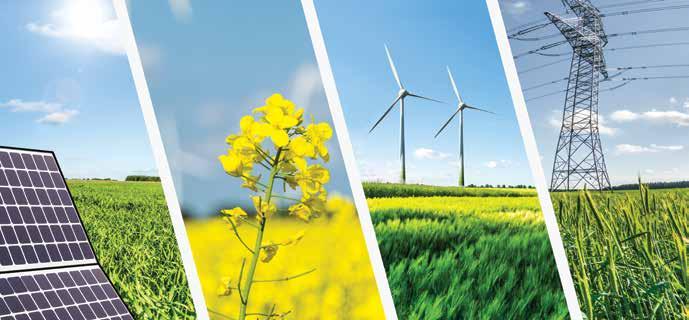
Alternative Energy originated as J & R Electrical Contractors in 2004 (J & R Electrical (NI) Ltd). In 2011, the firm diversified into renewable energy, primarily Solar PV, specialising in Domestic, Commercial and Agricultural installations. Based in Omagh, Co Tyrone, the team consists of two Directors, Office Manager, Sales Consultants and Roof and Electrical Engineers.
With over 12 years of experience in the industry and one of the first companies to start installing Solar PV in Ireland, Alternative Energy has a large customer foundation ranging from family homes to commercial and agricultural premises.
Using reputable and well-known branded products, the firm has installed over 1700 systems, which includes Solar PV, battery storage and EV charge points. Thes highly trained and competent team, ensures quality workmanship, great customer service and excellent aftercare support, all perquisites for a successful business. Alternative Energy is a ‘Safe Electric’ Registered Electrical Contractor and holds many accreditations, including ISO 9001 (Quality), 45001 (Health & Safety) and 14001 (Environmental).
With many renewable energy grants currently available, many people have decided to install Solar PV and battery storage systems in their homes and businesses. In a consultation, The Alternative energy team will discuss in detail the requirements of the customer so they can offer the best available options, which will satisfy both needs and budget.
With SEAI registration and on its approved list of Contractors and Installers for both Domestic and Non-Domestic Micro-generator (NDMG) installations, Alternative Energy can
offer an installation package which includes everything from survey and design to installation and commissioning. The office team will also complete the necessary ESB and grant paperwork and submit it on the customers’ behalf. In Northern Ireland, the firm liaises with NIE, completing the required application for Solar PV installations and can also assist the customer with building control if necessary.
As with any business, meeting customer demand is important and continual company development is crucial. One of the plans for this forthcoming year is to offer Air Source Heat Pump Installations. A heat pump transfers existing heat energy from the air into your home in order to heat radiators and hot water. Even in below-freezing temperatures, a heat pump is extremely efficient and can deliver more heat energy than the electrical energy they use. The system is very low maintenance and has an approximate life span of 25 years. It is also fully functional all year round.
Alternative Energy is proud of its wonderful team and has a database of loyal customers who have in turn recommended the firm to family, friends, neighbours and work colleagues. The team is looking forward to another busy year ahead, assisting customers to invest in their homes and businesses as well as reducing their impact on the environment.
A portfolio of some of Alternative Energy’s completed projects and full contact information can be found at alternativeenergy.ie where you can also request a quotation.


In the quest for a sustainable future, E-volv, an award winning company based in Cork & Dublin, stands out as a beacon of innovation and practical solutions in the renewable energy sector. At the heart of their mission is the ambition to make homes smarter, greener, and more efficient. This aim is not just a tagline but a commitment to transforming the way we consume and think about energy.
E-volv’s approach is notably customer-centric and independent, meaning they shop around to ensure consumers receive the best value for their unique needs. This business model, which emphasizes finding tailored solutions rather than pushing a one-size-fits-all product, sets E-volv apart in the renewable energy marketplace.
The company’s array of services includes solar photovoltaic (PV) systems, heat pumps, and energy-efficient home insulation. But at the core, they work with your budget. “You can make small changes that can make a big difference” notes Mike Cody (Managing Director).
These systems are not just eco-friendly; they are a smart investment, enhancing the Building Energy Rating (BER) of homes and increasing their value. Furthermore, the potential to earn from excess energy generated and fed back into the grid amplifies the appeal of E-volv’s solar solutions. By harnessing the power of natural light, their solar PV systems offer free electricity for over 25 years, providing significant savings on energy bills.
A key aspect of E-volv’s strategy is the introduction of flexible financing options. As Mike Cody, one of the founders,

remarks, “Since advertising a monthly payment option with no upfront costs, demand has increased because people no longer have the worry of upfront costs.” This innovative approach aligns with E-volv’s mission to make sustainable energy solutions accessible to a broader audience. By removing the barrier of high initial investment, E-volv is enabling more homeowners to participate in the green revolution.
In addition to their product offerings, E-volv provides a comprehensive service that includes advising on and facilitating access to grants, ensuring customers benefit from every available opportunity. Their commitment extends to guarantees of up to 30 years, providing customers with peace of mind and assurance in their investments.
The company’s growth and impact are evident, not only in its expanding reach and services but also in its commitment to creating jobs and fostering a sustainable community. As energy costs climb and the need for modern, efficient solutions grows, E-volv’s role becomes increasingly vital.
In conclusion, E-volv is more than a provider of green energy solutions; it is a partner in the journey towards a more sustainable future. Their independent, customer-first approach, combined with innovative financing options and a comprehensive range of services, positions them as a leader in the transition to renewable energy. E-volv’s dedication to enhancing home comfort and efficiency while reducing environmental impact exemplifies the kind of forward-thinking and action-oriented approach needed in today’s world




Ecoplex – the one-stop-shop for homes and businesses across Ireland
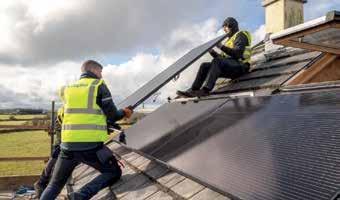
Ecoplex Solutions is an Irish family-owned renewable energy company based in Dublin, providing renewable energy solutions for homes and businesses across Ireland. They specialise in installing home and commercial solar panels, electric car chargers, heat pumps, and boilers.
Ecoplex’s team of energy experts and innovators dedicated to improving the way individuals and businesses produce and use power. Ecoplex guides clients through the entire process, including system design and installation, right through to helping with the relevant paper work and guidance with SEAI grants.

The firm is a registered member of SEAI Ireland and is regulated by Safe Electric Ireland and Registered Gas Ins. The world is becoming more and more environmentally aware, and people are looking for ways to reduce their carbon footprint. EcoPlex Energy Solutions is the perfect solution for those who want to make a difference but don’t know how.
Ecoplex offers a variety of services that will help you reduce your energy consumption, save you money, and help the environment. EcoPlex Energy Solutions provides the latest green technology to homes and businesses. The firm is a onestop shop for solar panels, solar batteries, heat pumps, and EV chargers. Ecoplex also provides a grant application service for the SEAI Better Energy Homes Scheme and the Renewable Heat Incentive Scheme.
Why Should We Invest in Solar Panels? Solar panels offer a variety of benefits, including:
Energy savings
Energy costs are rising, but solar has never been more affordable. Solar panels are a great way to reduce your energy bills by up to 70%. Solar panels allow you to power your home without relying on the electricity grid. This will help you save a lot of money on your electric bills.

Solar power is an unlimited source of energy that can be used anywhere on the planet. Using solar also helps reduce your carbon footprint. Solar panels also have a positive impact on the environment. They help us reduce our reliance on fossil fuels, and they produce clean, renewable energy.
Your home’s value will increase with the help of a professional
Solar panels can make your home more valuable if you sell it. Solar panels increase the value of your home and in some cases, solar panels added as much as €30,000 to the value of a property. This is great news for homeowners who are considering solar panels.
You can avoid electric grid failures with solar panels.
Solar energy may be the solution for you if you live in an area that experiences frequent power outages. You will become completely dependent on the electricity generated by solar panels if you go solar. Do you want to learn more? To help you understand the advantages and disadvantages of solar panels in Ireland, we have created a comprehensive guide.
The SEAI grant can save you as much as €2,400 off your solar installation. The Solar PV scheme also offers a grant for a single solar PV system or battery storage system. The grant is now available to homes built before 2021. To be eligible for the grant, you don’t need to have a C3 rating in BER. The solar panels must be installed by a registered SEAI contractor (RGI).

The Galway-based renewable solutions provider has an impressive project pipeline in Ireland, plans to expand their team into Dublin and start work in the Philippines

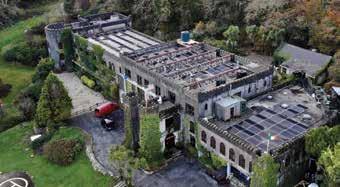
Galway based EnergieXPro® is a full-service renewable energy solutions provider, specializing in residential, commercial, and industrial solar PV installations. They design, supply, install and maintain high-quality, efficient, carefully crafted, and longlasting solar PV systems, energy storage, heating and hot water systems and EV chargers. The company is a SEAI registered contractor with a team of experienced electrical installers - all Registered Electrical Contractors (RECs), fully compliant with all relevant regulations.
EnergieXPro® has invested in its own EV charging platform in January and is one of the few companies in Ireland to have such a platform and operate private and public EV chargers. Their brand will be known as G Charge.
EnergieXPro® partners with local finance providers in Ireland that evaluate their clients and can offer finance directly, in many cases in advance. The company also offers grant applications services for clients that can give them back between 25% and 50% of the project value.
Since entering the market in 2020, EnergieXPro® has successfully completed over 300 solar projects throughout Ireland. Their extensive experience spans solar PV and hybrid solutions for households, commercial outlets, manufacturing plants, hotels, nursing homes and schools. The company has designed and installed а 160kW rooftop solar system, on-site EV charging stations, and full LED lighting upgrade in Castle Modular’s Gort-based plant, making it up to 99% energy selfsufficient. EnergieXPro® completed a 41kWp rooftop hybrid PV system at the C.B.S. Primary School in Ennis, achieving over 80% self-sufficiency. They have designed and installed a cutting edge 166.5 kWp solar PV System on the roof of the main campus building of the Technological University of the Shannon (TUS) in Limerick, as well as a 147kWp rooftop PV system at the award-winning Menlo Park Hotel in Galway.
EnergieXPro has also completed solar installations at three of the Talbot Collection hotels, as well as at the Abbeyglen Castle Hotel in Galway, and the Meadowlands Hotel in Co. Kerry. Another key project worth mentioning is the 300 kWp system installed on the rooftop of Pettitt’s SuperValu Bray.
“We offer survey, design, procurement, installation, and commissioning of complex systems, bespoke most of the time, where we combine solar PV with battery storage, heating systems, hot water systems and electric car chargers. We offer complete renewable energy systems that deliver, and this is where our success stems from”, says Ger Barry, Director at EnergieXPro® “Our comprehensive range of services makes the adoption of green practices easy and straightforward and helps clients to achieve efficiency, cut costs and reduce their carbon footprint.”
2024 is already shaping up to be a busy year for EnergieXPro®. January saw the completion of the solar installation at the Talbot Hotel Wexford, one of the three hotels done so far for the Talbot Hotel Group. EnergieXPro® won the tender for TG4 TV station in Galway in 2023 with delivery to site of materials in December and commencement of work in January 2024. The company will have a busy schedule in 2024 with an impressive project pipeline, including the Irish Seaspray in Connemara, Bonham Quay Galway, Reflector Building in Dublin, and multiple domestic projects.
Presently EnergieXPro is in negotiations to sign MOUs in the Philippines for a large scale, 10MW utility project in Malangas. As the number of projects grow, the company plans to expand its team into Dublin. EnergieXPro has also submitted their Tender for six CIE projects.
EnergieXPro® is a collective of experts striving to build a more sustainable world powered by renewable energy. They make the transition to renewable energy trouble-free and affordable for their clients.
With a target of becoming climate-neutral by 2050, Ireland is on an energy transition journey that demands expert knowledge and innovative solutions for businesses and homeowners alike. Rexel Energy Solutions is the leader in electrifying solutions that make a sustainable future possible.

The Rexel Group has been developing and distributing professional electrical supplies worldwide for over 50 years and, as part of its Sustainable Development Strategy, commits to developing and promoting solutions for energy efficiency by providing Rexel customers with a wide choice of innovative products and services for energy management and renewable energy use via a sales force that is continuously updated on the latest technologies.
As a division of Rexel Ireland, Rexel Energy Solutions is the expert in Solar PV, electric vehicle (EV) charging, home automation and other energy-efficient products for the commercial and domestic sectors. Operating via their electrical wholesale branches, Kellihers Electrical and CT Electric, Rexel Energy Solutions is Ireland’s largest distributor and delivers throughout the country.
A clean, practical and economical way to create sustainable energy is by turning light into electricity using Solar Photovoltaic (PV) systems. Panels, ranging from a few
centimetres to hundreds of square metres in size depending on the application, soak up photons from sunlight and shake loose negatively charged electrons that pass through the panel creating Direct Current (DC) electricity that an inverter converts to Alternating Current (AC) suitable for use in a building’s main electricity supply. To achieve optimal power generation, the ideal location for a Solar PV system installation is an unshaded, South-facing orientation at an angle of 30 to 40 degrees from horizontal.
Part L of current Building Regulations require new buildings to generate a certain amount of energy from renewable sources. Solar PV systems represent one of the best solutions for meeting this requirement, being economical, easy to install, and thanks to having no moving parts, boasting long warranties and needing only minimal ongoing servicing. To meet Part L requirements, a Solar PV system needs to generate 4kWh (Kilowatt hour) of electricity for every square metre of floor space a year. In the average 200M2 home, this equates to 800kWh of solar electricity annually generated by as little as four 270-watt panels that are typically 1.7 metres high and 1 metre wide.

Navigating the mathematics to work out what size of Solar PV system is required for a new build can be onerous, but Rexel Energy Solutions’ experts are on hand to perform those calculations for their customers and create the perfect solution from the wide range of panels they supply of various types and wattage, along with the inverters, mounting equipment and accessories needed to complete the project.
Rexel Energy Solutions also lends its knowledge to car parks and workplaces seeking the best solution for charging multiple electric vehicles, particularly if there is uncertainty about how many charging points are needed, whether they should be DC or AC and if each socket needs to supply 22KW of power. The company’s specialists also advise homeowners on the right EV charger for their needs, and many units can benefit from a Sustainable Energy Authority of Ireland (SEAI) grant of up to €600.
The prospect of finding capital for the installation of a Solar PV system for commercial, public or non-profit sector use can be daunting. Luckily, to encourage the energy transition and meet Net Zero targets, there are several grants and funding options available.
The SEAI provides grant funding to businesses, farms, schools, community centres, public sector bodies and nonprofit entities via the Non-Domestic Microgen Grant (NDMG) for systems up to a maximum of 1000kWp (Kilowatt peak) making the switch to solar cost-effective. The grant ranges from €2,700 to €162,600 and typically covers 20-30% of the installation cost, reducing the payback period down to as little as 5 years.
A funding avenue for education is available via the Schools Photovoltaic Programme, a Department of Education initiative to deliver a fully funded 6kW solar electricity system for every
school in Ireland. In addition to the PV system itself, there is a requirement for the school to install a display screen that’s a minimum of 32” (500mm x 400mm) in size and viewable from at least 8 metres away in a public area of the building. Rexel Energy Solutions can advise SEAI registered installers on whether a purpose-built PV display panel or a monitor attached to a PV inverter output best fulfils the needs of the individual project.
Rexel Energy Solutions supplies a range of innovative products for non-domestic Solar PV installations such as the ValkAgri corrugated adapter. This ingenious product overcomes a common challenge when installing PV systems in agriculture buildings; how to mount them on the uneven surface of a corrugated metal rooftop. The ValkAgri corrugated adapter, jointly developed by Van der Valk and Rexel Ireland, allows standard Van der Valk trapezoidal PV mounting products to be installed on most corrugated agricultural roofs.
Helping installers and their customers at every step of the value chain is at the core of the Rexel Energy Solutions ethos so, in addition to their comprehensive range of products, the company offers advice on tailor-made solutions for projects, support and installer training in partnership with product manufacturers.
In January 2024 Rexel Ireland opened a new Kellihers wholesale distribution hub in County Dublin to deliver a wider range and faster stock availability throughout the country. The state-of-the-art distribution centre boasts 929M2 of warehouse space and gained an Outstanding certification from BREEAM, making it the most sustainable building in Ireland.
With the momentum of Rexel’s Sustainable Development Strategy behind it, Rexel Energy Solutions is ideally placed to continue leading in the supply of sustainable electrical solutions in Ireland.


At Freedom Energy, we believe in a future where homeowners have the power to take control of their energy consumption while contributing to a sustainable planet.

Kildare-based company providing a smooth transition to solar

With years of industry experience, Freedom Energy leads the way in delivering reliable solar solutions. Our seasoned professionals ensure a smooth transition to solar power, backed by their deep knowledge and technical prowess.
Freedom Energy understands that your home’s energy needs are unique. The firm’s personalized approach involves a thorough assessment to design a solar system that maximizes efficiency, aesthetics, and savings – ensuring you get the most out of your investment.
At Freedom Energy, quality and reliability are nonnegotiable. The company uses top-tier components and cuttingedge technology to create solar solutions built for long-lasting performance, providing you with enduring energy savings and peace of mind.
Freedom Energy’s vision is a world where every home is a beacon of clean energy, where solar power is the driving force behind a more sustainable and equitable future. The dedicated team envisions a seamless integration of technology and nature, where homes generate their own power, reduce their carbon footprint, and inspire others to make the switch to renewable energy.
At Freedom Energy, its not just about installing solar panels – they’re fostering a movement towards energy independence and a cleaner, greener planet. By choosing Freedom Energy, you’re choosing a partner that understands the transformative power of solar energy and is dedicated to making it accessible to all. Join them in embracing a brighter, more sustainable future.
Freedom Energy’s solar solutions for homes pave the way for a brighter and cleaner tomorrow. Discover how you can liberate your energy usage and embrace the freedom of solar power.
What Freedom Energy offers:
■ Affordable Pricing
■ Rewiring Experts
■ Safety First Approach
■ Extensive Experience
■ Peace of Mind
Experience a comprehensive service that begins with meticulous planning and execution by Freedom Energy’s seasoned team. The installation process is defined by precision and an unwavering focus on detail, guaranteeing the seamless integration of your solar system into your property. From the initial system design to the ultimate installation, the team’s commitment remains resolute in delivering outcomes that consistently adhere to the highest standards of quality.
Are you tired of ever-increasing electricity bills? Say goodbye to those worries with Freedom Energy. Cutting-edge solar systems allow you to generate your own energy, reducing your reliance on the grid. By harnessing the abundant power of the sun, you’ll experience a significant drop in your energy expenses while contributing to a greener environment.
Government publishes first-of-its-kind strategy for Ireland’s energy security















The government has published the ‘Energy Security in Ireland to 2030’ report, which outlines a new strategy to ensure energy security in Ireland for this decade, while ensuring a sustainable transition to a carbon neutral energy system by 2050.
The comprehensive report, which has 28 actions in total, is a roadmap to ensuring a sustainable, affordable and secure energy landscape that balances energy risk and resilience against our binding European and domestic energy and climate commitments.
It is informed by six pillars of analysis, including the technical review of the energy security of Ireland’s electricity and gas networks carried out by Cambridge Economic Policy Associates (CEPA), over 450 consultation responses to this analysis, and the Independent Review on the Security of Electricity Supply, carried out by former Secretary General of the Department of the Taoiseach, Dermot McCarthy (the McCarthy Report).
Overall, the in-depth consultation and analysis highlights the vital importance of Ireland’s renewable energy policy agenda. It also identifies strategic risks for Ireland within a changing European and international energy context. Based on this, the









report sets out several conclusions, including:
Electrify: Ireland’s future energy supply will be more secure by moving to an electricity-led system.
Delivering on the plans already in place: Ireland’s existing plans to grow renewable generation, demand-side flexibility, new gas-fired generation as back-up, interconnection and storage are the right ones to secure electricity supplies.
Balancing sustainable gas demand and supply: While gas supplies and infrastructure are adequate to meet our demand projections, there are risks in the event of disruption to infrastructure. To reduce reliance on gas imports, we will reduce natural gas demand and develop renewable, indigenous gas supply and renewable gas-compatible storage.
As a transitional measure, we will introduce a Strategic Gas Emergency Reserve to address security needs in the mediumterm, to be used only if a disruption to gas supplies occurs. Based on the preliminary analysis of the department (DECC) it is anticipated that a floating reserve (FSRU) will best meet the criteria set by the government today, a solution preferred by a



range of EU states. This will be examined by Gas Networks Ireland and a detailed proposal will return to Government for final approval in 2024.
Robust oil supply: Back-up reserves and distribution plans in case of an oil emergency are sufficient. Into the future, we need to ensure commercial oil supplies into the State will be robust, along with the infrastructure for distribution. Over time, oil demand will be reduced.
Anticipating Risks: Maintaining a strong focus on anticipating risks and good governance to ensure delivery, robust risk management and adequate resources.

Minister for Climate Change Eamon Ryan: “Ultimately, it will ensure our energy system is secure and affordable as we transition to a carbon neutral future.”
Minister for Climate Change Eamon Ryan said the strategy integrates energy, climate, enterprise, and digitalisation policy ambitions so that Ireland’s energy future is clear and certain.
“Ultimately, it will ensure our energy system is secure and affordable as we transition to a carbon neutral future,” Minister Ryan said.
“Ireland is currently one of the most energy import-dependent countries in the EU. By reducing our import dependency through our energy efficiency measures and our investment in a diverse number of renewable energy sources, Ireland will reduce our dependence on imported fossil fuels and dramatically reduce our exposure to energy shocks.
a trusted contractor to various domestic, commercial and industrial businesses that have come to rely on our professional and efficient electrical services.
“We are already world leaders in onshore wind energy and are actively pursuing our offshore wind, solar, interconnection and other renewable sources. The delivery of this ambition will ensure an energy system that is no longer oil and gas-based but grounded in indigenous renewable electricity.
“While we transition to this more sustainable energy landscape, we will need a range of measures to ensure a resilient, reliable, and secure energy system throughout. This Strategy sets out how we can power Ireland’s progress, enhancing our energy security with a mix of energy efficiency, a continued shift to electricity from renewable generation, smart grid interconnection to the UK and Europe, better storage as well as flexible, state-led and temporary access to key fossil fuel reserves as we make the switch.”
Two major new areas are highlighted in the report for action: increasing Ireland’s resilience in the unlikely event of a disruption to natural gas supplies and developing the anticipatory capacity of the energy sector in Ireland.
To view the ‘Energy Security in Ireland to 2030’ report, please visit: www. gov.ie/en/organisation/department-of-the-environment-climate-andcommunications
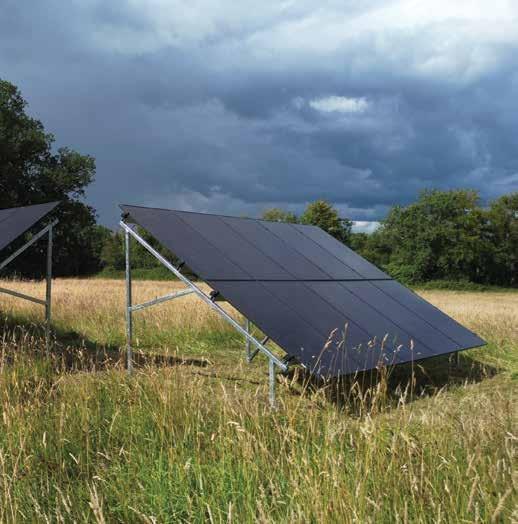

In the realm of renewable energy solutions, lennon solar stands out as a beacon of innovation and commitment to a sustainable future.
With a focus on harnessing the power of the sun to provide clean and reliable energy, lennon solar has established itself as a leading and trusted provider of solar panel installations and services. This editorial explores the ethos of lennon solar, an Irish family run business in County Louth, the services they offer, and the impact sustainable energy is making in the transition towards a greener planet.
At the core of lennon solar’s mission is the belief that solar energy can transform the way we power our lives. By offering a range of solar panel solutions for residential, commercial, and industrial properties, lennon solar empowers communities to reduce their carbon footprint and embrace a cleaner energy alternative. From rooftop solar installations to ground-mounted arrays, lennon solar customizes solutions to meet the unique energy needs of each customer, paving the way for a more sustainable future.
The Team at lennon solar goes beyond just installing solar panels, the company offers a comprehensive suite of services to ensure a seamless transition to solar energy. From initial consultations and site assessments to system design, installation, and maintenance, lennon solar guides customers through every step of the solar journey.
With a team of experienced solar experts and technicians, lennon solar ensures that each installation is completed with precision and efficiency, guaranteeing optimal performance and long-term reliability.
Innovation is at the heart of the company’s approach to solar energy solutions. By leveraging cutting-edge technology and industry-leading practices, lennon solar maximizes the efficiency and effectiveness of its solar installations. The use of advanced monitoring systems, smart inverters, and highquality solar panels ensures that customers receive the bestin-class technology for their energy needs. This commitment to innovation sets the team at lennon solar apart as a forwardthinking leader in the solar industry.

Sustainability is not just a buzzword within our business, it is a driving force that shapes every aspect of the company’s operations. From sourcing eco-friendly materials to minimizing waste and carbon emissions, the entire operational team at lennon solar is dedicated to reducing environmental impact and promoting a greener way of doing business. By embracing sustainable practices and promoting energy efficiency, lennon solar sets a high standard for responsible corporate citizenship and environmental stewardship.
Beyond providing solar solutions, lennon solar actively engages with the community to raise awareness about the benefits of solar energy and promote environmental conservation. Through sports and community sponsorship, 5ks and local marathons, apprenticeship workshops in the local college at DKIT, and community events, lennon solar aims to educate the public on the importance of renewable energy and inspires individuals to make the switch to solar power. By fostering a culture of sustainability and environmental consciousness, lennon solar is driving positive change inthe communities it serves.
As we navigate the challenges of climate change and energy sustainability, the team at lennon solar shines as a guiding light towards a brighter and cleaner future. With its commitment to sustainability, and community engagement, Lennon Solar is leading the charge towards a world powered by renewable energy. By choosing Lennon Solar, home and business owners not only invest in a reliable and efficient solar solution but also contribute to a more sustainable and eco-conscious world. Let lennon solar illuminate your path to a greener tomorrow.
New energy efficiency guidance to support energy upgrades in traditional buildings has been launched with the intention of facilitating warmer, more energy efficient homes in pre-1940s housing stock, and to help to address vacancy and revitalisation of towns and cities.
The guidance is primarily aimed at the specifiers and installers of retrofitting projects, the guidance will also be of interest to owners, occupiers and other custodians of historic buildingsboth residential and non-residential – who want to increase the comfort in these buildings while reducing their energy usage, energy bills and greenhouse gas emissions. The guidance will greatly assist in the regeneration of historic buildings in our towns, cities and countryside, enabling disused or underused buildings to be brought back into use.
According to Malcolm Noonan Minister of State for Nature, Heritage and Electoral Reform, there has been a significant increase in demand for renovations, including energy upgrades to bring older building stock back into use and the guidance will ensure that more of these types of buildings can now be brought up to better energy efficiency standards and in turn, make them more comfortable places to live.
“As these types of buildings are often located in our towns and cities, this guidance can also help to support our efforts to revitalise town centres and address vacancy,” he said.
“By sensitively upgrading our historic buildings, we not only protect their architectural heritage value, but improve the comfort and quality of life for occupants and enable vacant properties to be brought back into use. In addition, we can reduce the energy use of these buildings which is an important step in meeting our climate targets.”
The guidance will assist specifiers and installers by providing practical advice on how to make the right decisions when undertaking retrofitting works to traditional buildings. It explains how these buildings work, how to assess their performance and how to plan for climate change. Advice is given on options for upgrading the different elements of the building fabric, and what to take into consideration when upgrading existing services or choosing a new energy system, including renewable energy, for a traditional building.
In Ireland, traditional buildings are built with solid, loadbearing masonry walls, single-glazed windows and timberframed roofs. This type of construction was used in the majority of buildings built in this country before c.1940 and forms a significant component of our built environment.
Traditional buildings form the core of our cities and towns, and populate the countryside. They can be landmark buildings of high heritage significance, simple single-family dwellings and any building type in between. Their continued existence as the backdrop to our everyday lives plays a key role in our cultural heritage, our identity and sense of place.

Special care is required when undertaking building or energy upgrade work to building stock of this nature. The guidance will assist the custodians of traditional buildings in increasing energy efficiency in ways that protects the character of the buildings while also avoiding potential damage to the fabric of the buildings and the health of their occupants.
A Project Steering Group, chaired by the National Built Heritage Service, was formed to oversee the preparation of the guidance and included representatives of the Department of Housing, Local Government and Heritage; the Department of Environment, Climate and Communications; the Department of Education; the Office of Public Works; the Heritage Council; and the Sustainable Energy Authority of Ireland
The Project Steering Group worked with a contract team led by the Irish Green Building Council together with Carrig Conservation International, KRA and Passivate.
Under the Climate Action Plan, the equivalent of 500,000 homes are to be retrofitted to a B2 Building Energy Rating (BER) or cost-optimal equivalent by 2030. All public sector buildings are to achieve a BER of B by 2030, with around one third of commercial properties aiming to achieve the same target. The EU’s Renovation Wave aims to at least double the annual energy renovation rates in the next ten years.
This guidance will assist in unlocking the potential to upgrade a significant portion of the building stock in a way which takes account of its construction and safeguards its fabric and historic character.
A number of case studies will be developed based on the principles of this guidance to show what energy-efficiency options are appropriate to use and what they are likely to achieve in terms of improvement to their BER.

Established in 2012, Next-Gen Power offers a comprehensive energy solution for your home and/or business.

Next-Gen Power works with leading suppliers and only provides accredited solutions based on their outstanding quality and performance.
The firm provides green energy solutions to homes, farms and businesses all over the United Kingdom and Ireland.
Rising energy costs are causing all of us to rethink how we heat and power our homes. Many households are facing a fuel poverty crisis.
So, what can be done? Using the power of the sun, NextGen’s solution uses solar PV and battery storage. The result: a natural, efficient and cost-saving alternative to electricity from the grid. Reduce monthly costs and your carbon footprint in the process.
Solar PV systems can be mounted on any roof type; tile, slate, pitched, or flat. They can also be ground-mounted if roof space is not available.
■ Solar Panels: JA Solar / Q-Cells / Canadian Solar Monocrystalline
■ Inverter: GivEnergy 3.6 / 5.0 Hybrid / Solis 4G
■ Battery Storage: 5.2kWh / 9.5kWh / 32.50kWh (commercial)
■ Power Diverter: MyEnergi EDDI Smart Immersion
■ Mounting Kit: Renusol
The solar prioritises the home first, any generated power will be used to cover any consumption in the property at that time, any excess past this will then go towards charging the battery and finally anything that is surplus will be diverted towards the customer’s hot water tank through the smart immersion, giving them free hot water.
A GivEnergy installed system provides a smart energy solution and allows you to store and use generated power while also taking advantage of cheap rate electricity with its ‘winter mode’ setting meaning the customer can set charge times during the night to top the battery up and discharge during the day when solar production would be at its lowest during the winter months.
All of this can be controlled and monitored through a userfriendly app on their phone or online portal. Graphs and reports are on hand to track the solar, battery, house consumption, import and export on a daily, monthly or annual basis.
Contact Next-Gen Power for all your renewable energy solutions.

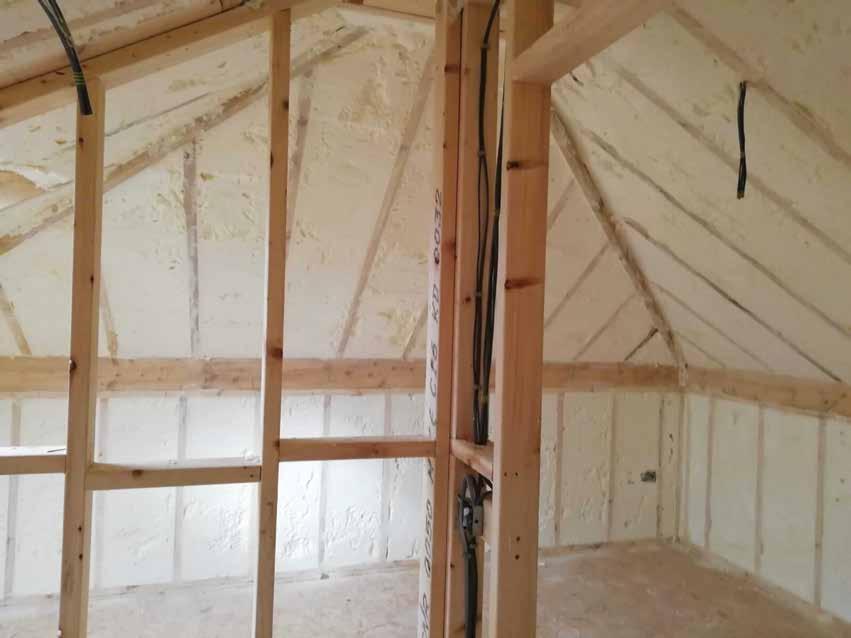
Spray foam insulation is an alternative to traditional building insulation, and due to its fantastic versatility, can be used on any areas of your property, including your roof, loft, walls and floors. Using spray foam assists in retaining the warmth and heat within your home, therefore reducing energy costs with less heat being wasted and lost. Contact us today to arrange a free quote and to find out how we can help with your residential or commercial property.
Pro Spray Foam Insulations are based in Birr, Co. Offaly, being so centrally located we are able to cover the whole of our beautiful country. We are accredited SEAI insulation contractors and are able to access grants under the Better Energy Homes Scheme. Contact us today to avail of a FREE QUOTE for all your insulation needs.
Contact Us
Roscrea Road, Crinkle, Birr, Co.Offaly, R42 EP94
Dublin: 01 9695226
Cork: 021 2428903
Offaly: 057 917 2717
Mobile: 087 6323186
Email: info@prosprayfoaminsulations.ie
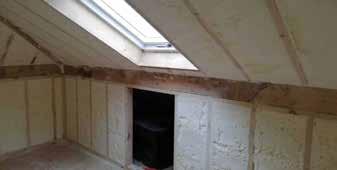
PSMPro Spray Foam Insulations provides cost-effective spray foam insulation expert attic, shed and container contractors comprehensive insulation services for domestic, agricultural, commercial and industrial applications nationwide. The firm has representatives in Dublin, Cork, Offaly and all surrounding areas in Ireland.
Pro Spray Foam Insulations uses EZero 500 from CPI FOAM and Synthesia technology from Red Letter Supplies, which have both been tested by the National Standards Authority of Ireland (NSAI) and been awarded its coveted agrément certificate.
Pro Spray Foam utilizes numerous products and the work is tailored to suit customer requirements depending on the type of building.
Open cell spray foam insulation is used in domestic applications – attic insulation, roof insulation, floor and wall insulation. As the cells are open, water vapour can pass through the foam, allowing your roof timbers to breathe while maintaining a total airtight seal.
In Ireland, with our cold winters, keeping a house warm can be expensive. Especially since the introduction of the Carbon Tax, which has consistently increased from budget to budget, meaning that the cost of home heating will continue to increase. One solution is to put on extra clothes and suffer from the cold. The other is to use proper attic insulation and put a lid on an expensive heating bill.
Properly insulating your attic will reduce your heating bills by improving your energy efficiency, increasing your home comfort levels, and supporting the climate by reducing your greenhouse gas carbon emissions.
Closed-cell spray foam insulation is used in shed insulation and commercial, industrial and agricultural insulation applications. Closed cell does not expand like an open cell so when it is applied to steel, asbestos and concrete it forms an airtight rigid

seal which strengthens the structure while reducing heat loss and moisture build up but does not let water vapour escape. Closed cell is very cost-effective and offers good value for money.
Closed-cell spray foam forms a dense, rigid covering that also strengthens your structure when applied. It has a higher insulating value than open-cell foam and creates a resistant barrier against water, vapour and the elements.
The system is certified by both European and British boards. Closed cell insulation can be applied both vertically and horizontally due to its high reactivity. It is also perfect for overhead spraying.
Pro Spray Foam Insulations use both open-cell spray foam insulation and closed-cell spray foam insulation which deliver unrivalled levels of air tightness and uValues, making spray foam insulation the most cost-effective insulation material in reducing heat loss and moisture content.
In September 2019 Pro Spray Foam achieved an All-Star accreditation. The accreditation was awarded by Business All-Stars, a national body responsible for identifying and accrediting Best-in-Class Irish Businesses.
All-Star Accreditation means much more than just having an accreditation title for Pro Spray Foam Insulations. This is an award the firm takes great pride in and is keen to give its customers confidence by offering the highest quality spray foam insulation throughout Ireland.
Whilst the accolade enhances the firm’s reputation and gives its customers reassurance in its services, the team continues to strive towards the best possible service, no matter what work you require for your property. To become All-Star Accredited, you must already have high performance, trust and a customerfocused approach. Pro Spray Foam Insulations maintains its approach to all services, ensuring customers are left fully satisfied with the work they complete and their standards never drop.
To find out more about cavity wall insulation and the benefits for your property, get in touch with Pro Spray Foam Insulations, visit prosprayfoaminsulations.ie
Many experts believe Ireland’s target of 80% renewable electricity by 2030 is virtually beyond reach due to fractured planning and weak policy implementation.

A number of recent reports have cast doubt on Ireland’s ability to meet its renewable energy targets by 2030, citing planning delays, inadequate capacity on the electricity grid and a lack of “joined up thinking” in policy development as being among the factors likely to hinder the possibility of the target being met.
The reports substantiate comments made by Environment Minister Eamon Ryan’s to the Oireachtas Climate Committee recently in relation to delays in rolling out renewable projects and our “incredibly elongated” planning and legal systems, which he said are hampering our climate ambitions.”
The system takes 10 years to deliver a bus lane, Minister Ryan claimed.
“We do clearly have a problem in our planning system and in our legal system. It leads to delivery of certain projects in a timeline that is not compatible with our climate targets.
“We have a whole load of wind and solar projects that as soon as they get out of planning, tend to be judicially reviewed, and that takes another incredibly elongated and very expensive process that I don’t think necessarily serves the public sometimes,” he said.
Under the Climate Action Plan, the Government aims to have 50% of Ireland’s electricity made by renewable sources by 2025 before hitting the 80% mark by the end of the decade.
According to Central Statistics Office (CSO) figures from last year, Ireland’s share of renewable sources in electricity generation in 2022 at 39%. However, when it came to overall renewable energy use, and not just for electricity, Ireland is an EU laggard at just 12.5%, according to Eurostat.
During his address at the Cop28 summit in Dubai, Taoiseach Leo Varadkar told fellow world leaders that
Ireland has “a new Maritime Area Regulatory Authority to oversee Ireland’s renewable energy revolution and harness our vast offshore wind potential, powering millions of homes and businesses across the continent with clean, renewable energy”.
The Taoiseach also said that Ireland will double its contribution to international climate finance to at least €225 million euro a year by 2025.
However, a study by KPMG, commissioned by Wind Energy Ireland, which was published as world leaders gathered in Dubai for the Cop28 climate summit has found 95% of industry experts do not believe Ireland will achieve its target of having 80% of electricity generated from renewable sources by 2030.
The research, ‘Act NowAccelerating onshore renewable energy in Ireland’, found that the current grid was designed for the fossil fuel economy of the late 20th century and is not fit for purpose and it identified planning as the single biggest barrier to delivering the Climate Action Plan,
According to the report, “too few projects are coming through the planning system too slowly” and the length and uncertainty of decision times, coupled with the risk of judicial reviews, undermines Ireland’s efforts to build onshore renewable energy.
“There are concerns that the planning system in particular suffers from insufficient resourcing and that this has a disproportionate effect on the ability of industry to achieve results,” the report said.
The Government’s continues to maintain that - if enacted - the controversial Planning Bill will unlock the blockage but, many industry people are pessimistic about its chances of doing so and claim that the targets that are being announced chop and change too much, with little thought as to how realistic they are.
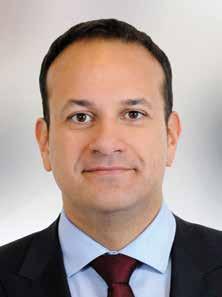
The report also recommends a complete overhaul of the national grid through the delivery of EirGrid’s strategy and says that a taskforce should be established to coordinate the delivery of offshore renewables, as well as onshore renewables, wind and solar.
“There was unanimity across stakeholders that Ireland can and should be a leader in Europe’s energy transition,” James Delahunt, Partner, KPMG Sustainable Futures said.
“A mobilisation of government and industry stakeholders is required if we are to extend this capacity to enable delivery of Ireland’s abundant renewable potential. Collaboration will be key.”
However, there was also a recognition that many elements of Ireland’s renewables ecosystem are already at capacity.”
The KPMG research says the Government must act on three priorities if the targets are to be achieved. These include ensuring the planning system is properly resourced by cutting out the current bottlenecks to prevent further backlogs and making sure people are in place with the skills to make decisions within the timelines of planning laws.
According to the KPMG report, “too few projects are coming through the planning system too slowly” and the length and uncertainty of decision times, coupled with the risk of judicial reviews, undermines Ireland’s efforts to build onshore renewable energy.
Noel Cunniffe, CEO of Wind Energy Ireland, said the report should be a wake-up call to anyone who wants to cut carbon emissions and end dependency on imported fossil fuels.
“I believe we can, and must, be a leader in Europe’s energy revolution,” he said. “We have the natural resources; we have the project pipeline and we have the ambition. This report highlights the obstacles to achieving these ambitions.”
He added that by pooling resources, State agencies, Government departments and industry can solve the challenges and delivery the change required.
Meanwhile Siemens Smart Infrastructure has released key insights into the divisive nature of the energy infrastructure transition in a new report, titled “Siemens Infrastructure Transition Monitor 2023: The Great Divide on The Path to Net Zero.” Data from the study reveals that there is limited alignment on priorities and how best to progress towards a decarbonized and resourceefficient world.
Whilst more than half of people surveyed believe the infrastructure transition is accelerating in their region, a quarter of participants - senior executives from seven major industry groups - said that progress is “too slow”, while 29 percent believe progress is “coordinated”, and 31 percent describe it as “on target”.
The study set out to measure the current state of the infrastructure transition, including developments within the systems, services, buildings, and structures that are needed for industries, cities,

and countries to function effectively. Data was collected through a global survey of 1,400 senior executives from 22 countries, as well as a series of in-depth interviews with leaders and experts.
The guiding principles behind the research outlined in the report include the necessity of the infrastructure transition to have a positive impact beyond decarbonization. Secondly, smarter infrastructure integration is mandatory to affect change. Finally, action must be undertaken urgently and at top speed to avert disastrous global consequences.
Despite the acceleration of the infrastructure transition, faster progress is needed at the regional (country) level to support a low-carbon world. Energy is a key priority as almost three quarters of global greenhouse gas emissions come from production, use and transportation of energy. According to the report, less than 10 percent believe their region (or country) to be “advanced, fully integrated, full-scale” on major energy goals of the transition.
In the fight against climate change, cities have a major role to play. In the survey, half of respondents (51 percent) believe that being ahead in decarbonization is a competitive advantage for a city. Decarbonizing mobility, including public transport networks and commercial and private vehicles is a priority to reduce emissions. 45 percent of respondents feel their cities have made progress to encourage the use of public transport. However, according to

the report, 44 percent also believe that the privatization of public transport would speed up decarbonization.
In terms of feasible mobility policies, 46 percent of executives believe that subsidies or taxes should be used to make electric cars cheaper than combustion engine vehicles. Currently, the lack of charging infrastructure was found to be the biggest barrier to widespread adoption of electric vehicles.
Currently, the lack of charging infrastructure was found to be the biggest barrier to widespread adoption of electric vehicles.
Businesses are under pressure to decarbonize their business models, assets, and infrastructure. According to the report, nearly half have targets for Scope 1 and 2 emissions (47 percent). Only 40 percent think it is likely that they will meet their targets for the year ahead and just 44 percent expect to meet their 2030 targets. The report indicates that there could be a correlation between confidence in organizational growth prospects and confidence in decarbonization targets.
Another key area of consideration for businesses is their buildings. Only 37 percent of respondents rated their organization as mature or advanced in improving the energy efficiency of facilities and buildings, and just 30 percent said the same for electrification and/or decarbonization of heating and cooling. There is, however, hope that businesses can leverage innovative solutions to enhance their performance and sustainability of their buildings without the need for extensive new construction, but progress needs to be quicker.


A new milestone in renewable energy rollout has been reached with the confirmation from ESB Networks that there is now one Giga Watt of solar photovoltaic generation capacity connected to the electricity network here.
1 GW is enough electricity to power the equivalent of around 400,000 homes when it is sunny. The peak demand point on Ireland’s electricity system is around 5.5 GW.
500 MW of the total is utility-scale solar connections with two thirds of that coming from larger projects connected to the transmission system, managed by EirGrid. A further 300 MW is coming from microgeneration, primarily produced by solar panels on homes while the remaining 200 MW is coming from non-exporting solar generation.
“Enabling the connection of 1,000 MW of clean solar power onto Ireland’s electricity network is a significant collective achievement for ESB Networks, our solar industry partners and indeed the 82,000-strong cohort of microgeneration customers across Ireland,” said Nicholas Tarrant, Managing Director of ESB Networks.
“This scale of connections is underpinned by our sustained investment in a cleaner, more resilient, and more flexible electricity system. It is reducing our dependence on imported fossil fuels and ultimately delivering the electricity network for Ireland’s clean, electric future.”
The news was also welcomed by the solar industry.
“Meeting our climate action targets requires a significant
contribution from solar electricity, connecting 1 Giga Watt less than two years after Ireland’s first solar farm was energised demonstrates the genuine potential of solar,” said Conall Bolger of the Irish Solar Energy Association.
“There is a strong pipeline of new solar farms currently under development and we must continue to support this momentum to enable Ireland to achieve its goal of 8 GW of solar by 2030,” he stated.
Minister for Climate, Eamon Ryan also welcomed the news that solar power has achieved this important milestone. “Since I launched the first solar farm in Co Wicklow in May 2022, there has been a major acceleration in the deployment of solar farms, providing new income streams to farmers, supporting jobs and benefitting communities across the country,” he said.
“This announcement marks an important milestone in Ireland’s journey to 8GW of solar connections by 2030 and shows that even in ‘cloudy Ireland’ we can harness our homegrown green resources to power homes and businesses,” he added.
Solar’s recent growth in Ireland has been revolutionary. From 0% in 2022, Sustainable Energy Authority of Ireland (SEAI) statistics showed a day in May 2023 where solar provided 10% of the country’s electricity.
According to ESB Networks recently stated that solar is now “the fastest growing renewable power source in Ireland.” This exciting progress was unlocked by two changes: removal
There are a few things to consider before you take the big step to stick solar panels on the roof of your house South or east-west facing: Ireland is in the northern hemisphere, so the sunrise is in an easterly direction and sunset is in a westerly direction, meaning the two options for a photovoltaic panel installation are either south facing or east-west facing. Depending on the roof space available, south facing panels will yield a higher output for a shorter time period but east-west panels will yield a lower output for longer periods throughout the day.
Roof Access: This is a primary concern for the initial installation of the panel frames, individual panels, and interconnecting wiring. There will need to be a route to transfer the equipment from the delivery vehicle and there will need to access to roof for a day or, depending on weather conditions, two days at the most. This will require a combination of safe scaffold and ladder access to the roof.
There will also be a requirement to access the photovoltaic panels at least once a year for cleaning to remove dust, organic matter, bird droppings etc. Dirty panels can reduce output by up to 20% without annual cleaning.
Space Available: The location where the solar photovoltaic equipment is installed must be safe for installation, replacement, maintenance and equipment observations. There must be a safe route identified from the external panels to the wall mounted Inverter and from the inverter to the main household incoming power distribution board.
The ideal location for the inverter would be at ground level, with a wall space of 2,000mm wide x 1,500mm high and located
1,200mm above ground level. There will be requirement of 1,200mm clear access in front of the inverter panel (clear all the time). This will comply with BS7671 wiring regulations and allow the electrical installation to be certified.
It’s recommended to have the new inverter panel installed in an easily accessible ground level location for intermittent display panel observations and assessment. There will be a requirement for a wifi signal adjacent to the inverter to allow for the mobile application to read and transmit the real time electrical energy generation data, a signal booster may be needed here.
Cable Routes: The following cable routes need to be considered and verified to minimise costs and unforeseen works. Cables from the solar panels will penetrate the roof with a waterproof grommet and are typically run at attic or roof truss level and connect to the inverter panel. Cables from the inverter must be routed to the nearest distribution board, which can be in a garage or the distribution board in the house. If the garage distribution board and the main distribution board are seperate, the interconnecting cable size must be verified as this may limit the capacity of your solar photovoltaic installation.
Existing Electrical Installation: A new solar photovoltaic equipment installation will be tying into the existing domestic installation so it is important that the existing installation is both safe and meets the current regulations. Otherwise, the solar photovoltaic equipment installation cannot be completed.
To allow for any surplus electricity generated to be fed back to the ESB grid for payment, there must be an ESB Smart Metre in place. In some cases, this could take up to
of barriers to rooftop solar; and a route to market emerging for utility scale ground mount solar.
Consumers are placing solar on their homes and businesses at an unprecedented rate. Domestic users are installing an average of 500 systems a week. Commercial players are installing not only kilowatt scale but megawatt scale.
Complementing this rooftop growth has been the longawaited flourishing of the substantial utility scale pipeline developed by the solar industry. A key enabler has been the Renewable Electricity Support Scheme auctions.
The growing confidence in solar’s potential was reflected by Government increasing the country’s solar PV target from 1.5-2.5GW by 2030, to 5GW by 2025 and 8GW by 2030. Solar is not a fringe technology but a significant part of Ireland’s
three months depending on the roll out plan in the locality so the secret is to apply for this as soon as possible.
Your new installation will be connected to your existing distribution board so there will need to be a minimum space requirement for three double isolator units, two of which will be used and 1 space for a future spare, depending on the equipment being installed.
For the Eddi or equivalent hot water diverter equipment installation there must be an electric immersion heater in the hot water cylinder. For larger hot water cylinders, there may be both top and bottom immersions controlled by a bath/sink switch, the control of these will be replaced by the Eddi or equivalent diverter. If you have or are planning to use an electric car, it may be worth investing in car charging port.
How long will it take for solar panels to pay for themselves: This is always the crunch question, and most solar providers will give an indicative payback evaluation with the equipment quotation. The most important criteria for payback for a solar photovoltaic panel installation is to use the generated electricity for household daytime consumption, hot water generation with an Eddi panel, charging your EV car with a Zappi unit or storing your electricity in a battery for use during darkness.
Currently in Ireland, most electricity suppliers will take back any surplus solar electricity at a rate of 50% of the associated day rate and this credit is deducted from the electricity bill. This may not always be the case as many of the electricity suppliers in Europe do not offer a payment for surplus household solar electricity. To avoid any hidden post installation costs, it is advisable to request a full survey at the time of the final cost proposal from the solar PV installation contractor.
decarbonisation toolkit, alongside storage and wind.
The question is not whether solar will scale, but how large an industry can be built in Ireland. To facilitate that growth, fundamental decisions need to be taken by the State.
We must build the network to support a zero-carbon system, quickly. Building that grid will deliver the green electrons needed to shape and power the future clean economy of Ireland.
Planning remains a challenge. The system requires resourcing. For example, the national planning authority An Bord Pleanála is struggling to decide on solar planning appeals within the mandated 18 weeks, currently averaging close to 36 weeks, with some cases taking over 70 weeks. 86 per cent of projects are successful in that process, suggesting something needs fixing.


SolarSol Specialises In The Design, Supply, Installation, And Maintenance Of Solar Energy PV, EV Charging, And Battery Storage Systems.
As An SEAI Registered Solar PV Company We Insist On Providing Customised Solutions To Our Customer’s Preferences With Top Quality Service, Commissioning, Along With Financing And Excellent Value For Money.
This Winning Formula Has Made Us One Of Ireland’s Leading Independent Solar PV Installers With A Strong Reputation For Our Technical Expertise And Engineering Excellence.
www.solarsol.ie
Specialises In The
Supply, Installation, And Maintenance Of Solar Energy PV, EV Charging, And Battery Storage Systems.
As an SEAI-registered solar PV company, SolarSol provides customised solutions to customer preferences with top-quality service, and commissioning, along with financing and excellent value for money.
This winning formula has made SolarSol one of Ireland’s leading independent solar pv installers with a strong reputation for technical expertise and engineering excellence.
Tier-1 Longi and Trina Solar PV panels generate 70% more energy than conventional panels over the life of your system. Longi and Trina Solar Optimisers allow each panel to operate independently, increasing reliability and functionality. Huawei and Alpha SS inverters give more power than normal Inverters. Monitoring the power production of your system is easily done through your smartphone, tablet, or computer.
People choose to buy solar panels for various reasons. Solar is an unlimited renewable energy source that doesn’t produce CO2 emissions or other gases. Also, it doesn’t consume fuel or require other resources, such as water or wind.
This is one aspect that makes it one of the most interesting systems for producing energy from the environmental perspective and this is the main reason why you should buy a residential solar panel in Ireland.
There are plenty of other benefits of solar energy that aren’t quite as obvious. Here are a few:
Solar energy doesn’t require any outside supply to work, so its maintenance and energy production costs are practically zero. After the manufacture and installation of the components, solar is pretty much free. This means that despite the initial investment, there are no additional costs associated with its use, so the installation is recovered quickly.
Losses during transport and distribution of energy increase with the distance between the production and supply points. These affect the performance of the installation in densely populated areas.

With photovoltaic solar systems, the distances are drastically reduced, increasing the efficiency of the electrical system.
SolarSol solar systems aren’t generic. Like any addition to your home, it should be customised and tailored to your needs. With a dedicated project manager and certified in-house team, you’ll be in the know from beginning to end. The firm handles it all—from SEAI regulations and making sure every step is clear to ensuring you’re taking advantage of SEAI incentives. With SolarSol, your switch to solar could be complete in one day.
SolarSol includes free initial consultation and quotation, free completion of tender documents, in-depth feasibility studies and system design with performance estimates and system optimisation.
SolarSol liaises with other project designers: structural engineers, M&E and sustainability consultants. SolarSol provides technology integration – on-grid and off-grid solar, storage, lighting controls, EVcharging and voltage optimisation. This along with installation using in-house installers, servicing, and maintenance.
SolarSol supplies the highest-quality solar panels for residential and commercial properties. The team’s expert knowledge can help guide you toward the perfect panel.
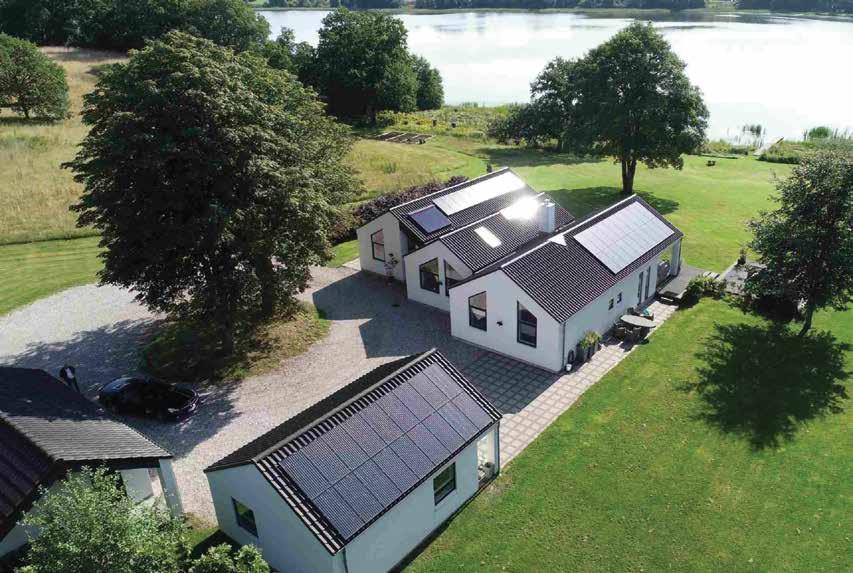


Sunvolt Ireland, based in Dublin is a leading provider and installer of everything solar. Products and specialities include complete Solar Systems, inverters, solar modules, components for solar modules and solar modules mounts.
Sunvolt takes pride in offering Ireland’s best prices for solar systems, making renewable energy solutions affordable and accessible for everyone.
With an impeccable customer service record, Sunvolt offers complete transparency, allowing customers to see all system components before purchase, ensuring they know exactly what they’re getting.
Sunvolt customers can count on the expert team for assistance with installation queries as well as access to handy guides for various roof types, ensuring a smooth experience before, during and after installation.
The government recently announced that the VAT rate for domestic solar installations would be reduced from 13.5% to a remarkable 0.0%, this came into effect May 1st, 2023.
This exciting change not only paves the way for a greener future but also makes sustainable energy solutions more
accessible than ever for homeowners. Don’t miss out on this incredible opportunity to go solar and save!
Purchase a complete hybrid solar array system with a battery – everything you need to become self-sufficient with a green energy source. A hybrid solar system sets itself apart from a standard system by incorporating a connected battery. This enables you to store the energy generated and use it during times when household consumption exceeds production, or during periods of high electricity prices.
The use of solar energy is increasingly being adopted by both domestic and commercial users as homeowners and entrepreneurs become more aware of the need to reduce their carbon footprint, not to mention the energy-saving benefits.
Utilizing the services of a company such as Sunvolt ensures you will receive the benefit of years of experience and expert knowledge so that you can get the very best from your transition to solar energy.
Reach out to the Sunvolt team for a swift and professional response through chat or email at contact@sunvolt.ie.

Established in January 2023 by Shane Ryan, Western Solar has rapidly become a prominent player in the solar industry.


Strategically headquartered in Lahinch, Clare, and boasting warehouses in Lahinch and Ennistymon, alongside a robust transportation network, the company has positioned itself as a leader in both technological innovation and logistical expertise within the solar revolution.
Recognizing the burgeoning opportunities in Ireland’s solar technology landscape, Shane Ryan enlisted the expertise of Sales Director Stephen McDermott. Stephen, with a wealth of experience garnered from previous roles in the solar sector, brings valuable insights into both emerging and established technologies, as well as expertise in design and advisory services.
Western Solar places a premium on efficient pricing strategies and staying competitive, while simultaneously prioritizing the crucial aspects of delivery and logistics. The company proudly guarantees same-day or next-day delivery nationwide, recognizing the importance of prompt delivery for tradesmen, facilitating early morning installations for optimized time management.
The company’s exceptional delivery capabilities are underscored by a fleet comprising three vehicles, including a small van, a large box truck, and the latest addition, a 40ft Curtainsider equipped with a Moffat forklift. This strategic fleet allows for the convenient drop-off of pallets virtually anywhere in the country, eliminating the necessity for clients to have their own forklift.
At the core of Western Solar’s commitment to cuttingedge technology is its partnership with Growatt, a renowned supplier. Growatt, with a distinguished track record in Solar PV technology, consistently receives accolades for innovation,
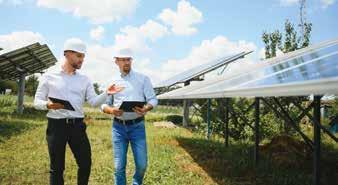

ensuring that Western Solar’s customers receive the latest advancements in the market.
Central to any solar setup are the panels, and Western Solar proudly offers two distinguished brands. Jinko Solar panels from China are a popular choice, alongside Recom Technologies from France, offering Tier 1 status, outstanding efficiency, and remarkably low degradation at 0.25%, one of the lowest in the market.
With only 6% of the country currently adopting solar technology, Western Solar recognizes the vast potential in the market. In light of various incentives such as community grants, business grants, and the TAMS Agri grant, there is a compelling case for homeowners, farmers, and businesses to embrace solar as a clean and forward-thinking technology.
As Ireland progresses towards its Carbon Neutral target, Western Solar stands ready to provide expert advice, design services, and guaranteed delivery throughout the country. The launch of the schools solar program this year further demonstrates the company’s commitment, with Clare being among the selected counties to benefit from the solar grant.
Stephen and Shane have actively immersed themselves in the evolving landscape of solar technology, attending trade shows across Europe to ensure that Western Solar remains at the forefront with the latest technologies and advancements.
Heading into 2024, Western Solar continues to strengthen its position, expanding its product range, services, and advisory offerings. Whether a trade client, farmer, small business owner, or homeowner, clients can trust Western Solar to provide unparalleled advice and access to top-tier brands.

Open data has evolved from a best practice process into a legal requirement for all public sector organisations throughout Ireland. UrbanTide leads this transformative movement, delivering extensive training and support to ensure public bodies not only comply with the Open Data Directive but also capitalise on the numerous advantages of Ireland’s forward-thinking Open Data Strategy. This initiative represents more than legal compliance; it’s a gateway to unlocking the full potential of open data.
For the last six years, UrbanTide has collaborated closely with the Department of Expenditure, NDP Delivery and Reform, delivering vital open data training to public sector organisations throughout Ireland. It’s crucial that public sector organisations fully understand and efficiently implement their legal obligations under the new Open Data Directive. UrbanTide’s role goes beyond ensuring compliance; we’re empowering these bodies to enhance transparency and foster innovation. With UrbanTide’s guidance, they are not just meeting the directive’s requirements –they are transforming their approach to open data.
In 2019, the Public Sector Information Directive changed to adapt to the evolving landscape of new data technologies, including the Internet of Things and Artificial Intelligence. This update to the Directive strives to maximise the benefits of sharing public sector data and ensure that organisations keep pace with technological advancements. Since 2021, the Open Data Directive has been enforceable by law, and failure to comply could lead to consequences such as fines and loss of funding.
This directive mandates that all public data must be accessible to the public, reusable, and kept up-to-date.
Fundamentally, the Open Data Directive is a positive development for the public sector. It brings many benefits crucial for fostering transparency, innovation, and growth. More than just a regulatory framework, it is a tool for ensuring responsible management and sharing of public sector data. This directive and Open Data Strategy guides organisations and sets the stage for more open and effective use of public information, which will serve as a catalyst for innovative data reuse across the EU.
In recent years, Ireland has emerged as a leader in data maturity, consistently performing well in the EU’s Open Data Maturity Report. This annual assessment evaluates EU member states on their open data policy, impact, quality, and usage of national Open Data portals (data.gov.ie). The 2022 report places Ireland in a commendable 4th position in the EU, with a 95% score, closely trailing France’s top spot by just two percentage points.
Driven by this success, the Irish government aims to position Ireland as a global open data leader, recognising and leveraging the economic, social, and democratic benefits of open data.
Open data has become law for good reason. There are a whole number of benefits that come with opening up public sector data – for citizens, for organisations and for Ireland’s economic growth more broadly. These include;
■ Efficiency and cost savings: Organisations can streamline operations and save resources by using open data to improve service delivery, optimise resource allocation, and reduce redundant efforts.
■ Innovation and economic growth: Open data creates an abundance of new opportunities for public and private sector organisations to develop new technology and
“This Open Data Strategy 20232027 lays out how we can build on progress to date and ensure the better use of data across businesses, government, civil society and individuals. The strategy provides a framework for the actions the Public Service will take on Open Data over the next five years. Open Data and its uses provide opportunities to be embraced; opportunities to transform and improve public services; opportunities to boost productivity and create new businesses and jobs; and opportunities to build public trust.”
Helena Campbell, Department of Expenditure, NDP Delivery and Reform.
services, which drive economic growth and innovation.
■ Improved services: Access to cross-sector data helps organisations gain a more accurate understanding of the needs and preferences of Ireland’s citizens, allowing them to develop more tailored and effective public services.
■ Data-driven decisions and solutions: Access to open data enables organisations to make more informed and evidencebased decisions based on a wealth of data, which can be used to address complex societal challenges and provide more effective solutions.
■ Transparency, reputation and trust: Open data promotes transparency by making all public sector activities and decisions more accessible. This transparency fosters accountability and trust in government and all related public bodies.
How Urbantide can help get your data ready for AI
UrbanTide’s mission is to make a sustainable world with AI. The company specialises in unlocking data’s potential, guiding organisations in unlocking data, and utilising AI for Good, with over a decade of experience in delivering data-driven solutions to businesses to help them improve sustainability outcomes. Their approach, which champions the integration of people, data, and technology, is fundamental in their quest to cultivate more inclusive communities for everyone.
In response to the evolving landscape of open data management and the growing importance of artificial intelligence (AI) in the Irish public sector, UrbanTide will be integrating AI-focused content into their open data training courses. The aim is to elucidate the many benefits of using AI tools to prepare open data effectively, thereby empowering public sector bodies to embark on their data-driven journey confidently. By incorporating AI tools into the training curriculum, UrbanTide will equip participants with the knowledge and skills necessary to harness the power of AI in streamlining data preparation processes and maximising the value of their datasets.AI offers

invaluable capabilities that can transform how open data is managed in the public sector. One major advantage is its ability to automate tasks such as organising and cleaning data. Using machine learning, AI can efficiently standardise and validate datasets, making them ready for use. Additionally, AI tools can enrich data by adding relevant context, improving overall quality. By using AI to prepare open data, public sector bodies can improve data accuracy, interoperability, and accessibility, setting the stage for more advanced AIdriven analysis in the future.
By providing open data training for all public bodies, UrbanTide is supporting Ireland towards becoming a global leader in open data.
UrbanTide, together with the University of Galway, have redeveloped these courses specifically for Irish public sector staff. These targeted training courses are delivered online or in person anywhere in Ireland and are designed to give participants confidence and competence in the growing open data ecosystem.
There are six open data courses available:
■ General Introduction to Open Data - Develop knowledge and understanding of what open data is and what it means for citizens and the public sector.
■ Introduction to the Open Data Directive - Learn what Public Sector Bodies need to do following the new EU Open Data Directive and how to do it.
■ Open Data Audits and Data
“Data is an essential resource for economic growth, competitiveness, innovation, job creation and societal progress”
European Commission.
Publication - Develop more practical knowledge about publishing open data in line with the Open Data Publication Guidelines.
■ Introduction to Data Analytics and Visualisation - Learn how to work with analytics to create insight and visualisations that engage.
■ Data Anonymisation TechniquesAnonymisation enables data to be published without breaching data protection principles through depersonalisation and aggregation.
■ Introduction to Linked DataRecommended best practice for exposing, sharing and connecting pieces of data.
All course content is suitable for beginners and those with existing data management experience. The focus is to provide deep insight and practical training that participants can apply from day one.
Ready to unlock the potential of open data in your organisation - Connect with us at hello@urbantide.com and start your journey to open data mastery today!
Open Data Ireland Training Services | Eventbrite - book your courses directly at https://www. eventbrite.co.uk/cc/open-data-ireland-trainingservices-391349
Ireland’s Open Data Portal - find out more on the National Open Data Portal at https://data.gov.ie
“We’re proud to support Ireland’s public sector towards its ambitious goals of becoming a global leader in open data.”
– Stevie Revill, Co-Founder and CEO of UrbanTide.
“These courses helped demystify the concept of open data and how it can be implemented.”
David O’Leary, Higher Executive Officer - ICT Unit, Office of the Director of Public Prosecutions
“I really enjoyed the course. I think it is a wonderful initiative, the content is relevant and easy to follow. Sufficient information is provided if you wish to go into more detail on particular elements.”
Department of Housing, Local Government & Heritage
“Excellent course which, among other things, emphasises the appropriateness of different data visualisations depending on what is sought to be communicated and measured.”
Ciarán Colley, Administrative Officer (Economist), Parliamentary Budget Office, Houses of the Oireachtas
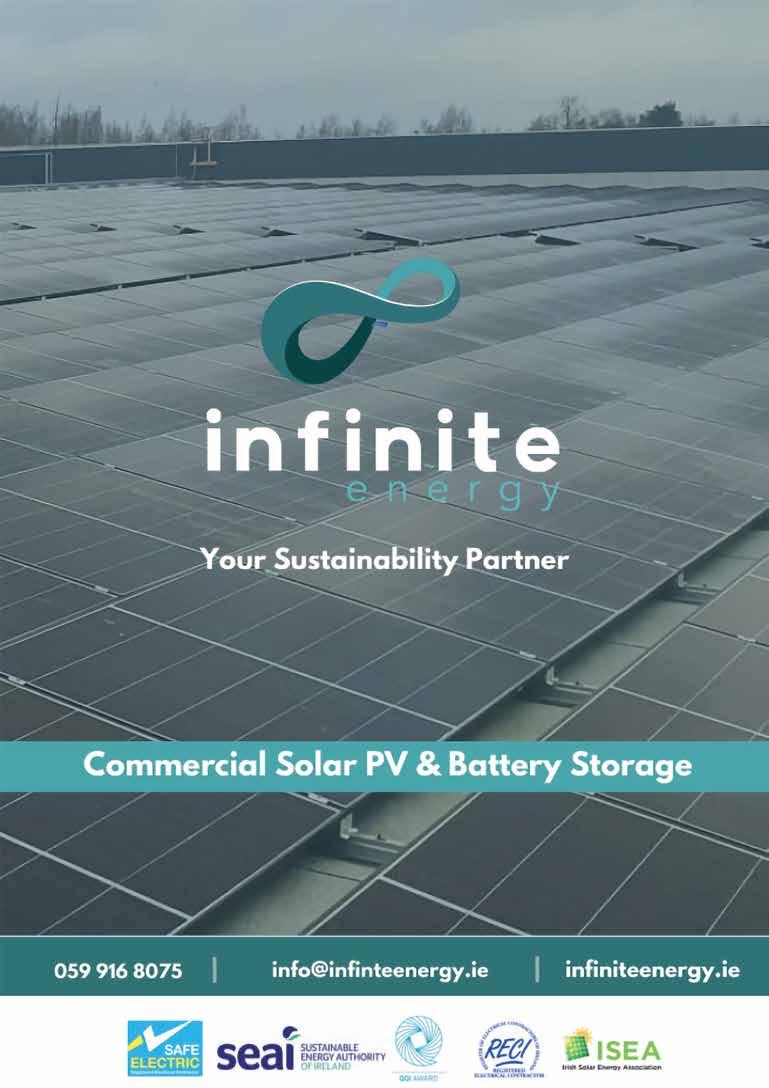

From new build installations to repairs and refurbishment of existing floors, we find the right flooring solution for you.
McLoughlin Industrial Flooring Limited is one of Ireland's leading industrial flooring and corrosion protection contractors with a professional, time-served and sizeable work force, specializing in the installation of resin flooring and high performance wall systems

www.mcloughlinltd.ie
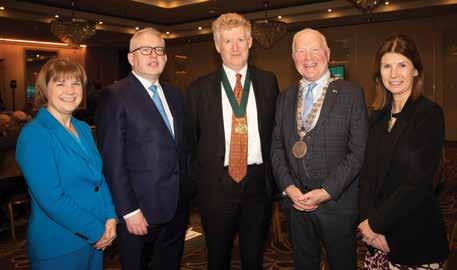
The Royal Institute of the Architects of Ireland (RIAI) in partnership with the Department of Housing, Local Government and Heritage (DHLGH) have announced details of the upcoming Joint National Housing Conference.
This year’s conference which is taking place in Waterford on 11 and 12 March, 2o24, is entitled Diversifying and Expanding our Housing Delivery and brings together high-profile speakers from government, local authorities, industry, and practice to explore solutions for the challenges Ireland faces in housing planning, design and delivery in the decades.
Speakers include national and international housing experts including architects, urban designers, policy makers and planners, as well as Minister for Housing, Local Government and Heritage Darragh O’Brien.
Minister O’Brien said the conference serves as a timely reminder of the significance of collective gatherings in exchanging knowledge and embracing fresh ideas and it will contribute to confronting the numerous challenges we face.
“I was especially pleased to see that the theme this year is Expanding and Diversifying our Residential Delivery,” Minister O’Brien said. “This is particularly appropriate as it coincides with a number of initiatives my Department has undertaken to expand and diversify our housing output. Measures such as the Town Centre First policy, the new Sustainable Residential Development and Compact Settlements Guidelines and the reshaping of our planning laws mean that we are growing in a manner that establishes sustainable communities in our cities and towns.”
RIAI President Sean Mahon said the conference offers
a unique opportunity for the built environment professionals in the public and private sectors to come together to discuss and develop innovative ideas for housing delivery.
“Housing is critical infrastructure required to sustain human well-being. Architects have a leadership role in driving innovation in housing design solutions the conference is an excellent opportunity to hear about new models and solutions that exist for housing delivery, but also to discuss the challenges impeding progress,” he said.
“Our discussions are set against a background of increasing urbanisation, the vast demographic changes in Ireland and the need to mitigate against climate change. The provision of high-quality homes, neighbourhoods and urban settlements are drivers of climate resilience social cohesion, cultural vibrancy, and economic growth. It is through collaboration, sharing experiences and ideas, and forwardlooking thinking that we can achieve these objectives and enable the delivery of long-term sustainable housing for our people.”
The conference will include an in-depth introduction to the Compact Settlement Guidelines and Design Manual. These guidelines will enable the building of a new type of housing development and bridge the gap between unsustainable suburban sprawl and unaffordable apartments.
The programme will also include further sessions examining ‘Quality Masterplanning’; ‘Sustainable Compact Settlements’; ‘Delivering at Scale’; ‘Town Centre First Initiatives’ and ‘Tackling Vacancy’.
As is now traditional, the conference will feature the presentation to the winner of the biennial RIAI Silver Medal for Housing. The Winning practices of the DHLGH and RIAI architectural design competition for Town Centre Living will present their winning schemes for public housing in the town centres of Castleblayney, Kildare, Roscrea and Sligo.
Also included in the programme are a study tour of new housing projects and of the high-quality public realm in Waterford, which has been developed by an architect-led multidisciplinary team in Waterford County Council.
The full programme is available to view at www.riai.ie/whats-on/events/ joint-national-housing-conference-2024
EML Construction Ltd is one of Dublin & Kildare’s leading building contractors, encompassing domestic, residential and commercial construction. The dedicated and experienced team members are experts in project management, refurbishment and restoration.

Founded in late 2012, EML Construction Ltd. has established itself as a reputable construction company, driven by a core group of experienced management professionals and skilled tradespeople. With a firm commitment to cultivating strong relationships with clients, architects, engineers, sub-contractors, and suppliers, the team takes great pride in its ability to deliver exceptional results. The company’s unwavering dedication to client satisfaction ensures that it consistently strives to exceed expectations in every project undertaken.
For more than a decade, EML Construction has established its reputation with professionalism, integrity, honesty, and dedication. With confidence, the firm can guarantee expert project management and high-quality products and services. The team’s
combined skills give them a thorough understanding of clients needs. This is achived by combining meticulous attention to detail, with a genuine desire for client satisfaction. EML Construction is fully insured and all its staff are licensed and experienced.
■ EML Construction offers:
■ Experienced and fully integrated team
■ Tailor made solutions for your needs
■ End-to-end Project Management
■ Competitive Pricing
Much of EML’s business is garnered through word of mouth and recommendations from architects, engineers, design teams, and previous clients. The firm works closely with new clients and designers to get a clear picture of their requirements and
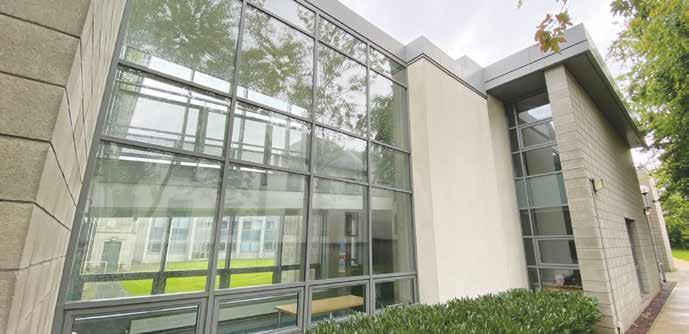
For more than 20 years, EML Construction has established its reputation with professionalism, integrity, honesty, and dedication.
expectations and understand how the client’s goals can be met.
For EML, its staff is everything. The firm believes that a company can survive and thrive with properly trained and motivated skilled staff. The vast majority of EML’s staff have been with the firm since day one, with some new additions along the way. The company operates a friendly, one-to-one approach with an entire team who pull together to deliver hard work, diligence, and outstanding effort.
EML Construction boasts a diverse portfolio, seamlessly transitioning between various sectors with expertise and finesse With capabilities extending to restoration and conservation projects, meticulous preservation techniques are required. Collaborating closely with architects and engineers, they adhere to strict guidelines and regulations, ensuring the highest standards of quality and authenticity are upheld throughout the process.
In addition to proficiency in restoration and conservation, EML Construction excels in the construction of high-end modern homes, small house extensions, office fit-outs, and commercial projects. Whether it’s creating luxurious, contemporary residences or seamlessly integrating extensions into existing structures, the team of skilled professionals is dedicated to bringing clients’ visions to life. Working closely with architects to ensure that their designs are meticulously executed, while also offering valuable experience to optimise functionality, costs and aesthetics.
Understanding the unique requirements of office fit-outs and commercial projects, EML recognises the importance of balancing finances, functionality, efficiency, and aesthetics in these endeavours. By collaborating closely with clients, they create tailored solutions that meet their specific needs, whether it’s building dynamic and modern office spaces or constructing functional commercial facilities. Their commitment to open
communication and collaboration ensures seamless project delivery and strong client satisfaction.
EML Construction recognises the importance of building strong and lasting relationships with clients. Prioritising clear and open communication ensuring that clients are informed and involved every step of the way. Dedicated project managers oversee each project, ensuring that timelines and budgets are meticulously adhered to, while maintaining the highest standards of quality and craftsmanship.
To achieve its goals, the firm relies on a network of trusted sub-contractors and suppliers who share a commitment to excellence. Carefully selecting partners who align with the same values and standards, ensuring that every aspect of the projects is of the utmost quality.
EML Construction’s expertise in project management covers all spheres of construction, from small to large extensions, new builds to small residential developments, laboratories to lecture theatres. Complete Office Fit outs along with Bar & Restaurant refurbishments for multinational companies.
EML Construction has just completed an inspiring restoration project, restoring three large whiskey stills from the nineteenth century. The firm is also immensely proud of its restoration and conservation works of the Shelbourne Hotel façade. The team finds these projects particularly rewarding - conserving and protecting living pieces of history for future generations.
EML Construction prides itself on building strong relationships. Its diverse portfolio means it possesses the expertise to excel in various sectors. Unwavering dedication to excellence, attention to detail, and commitment to client satisfaction set the firm apart in the industry.
Visit emlconstruction.ie
As Clúid Housing approaches its 30th anniversary of delivering homes for the social sector, Eibhlin O Connor, Chief Commercial Officer, reflects on what makes Ireland’s foremost Approved Housing Body so successful.
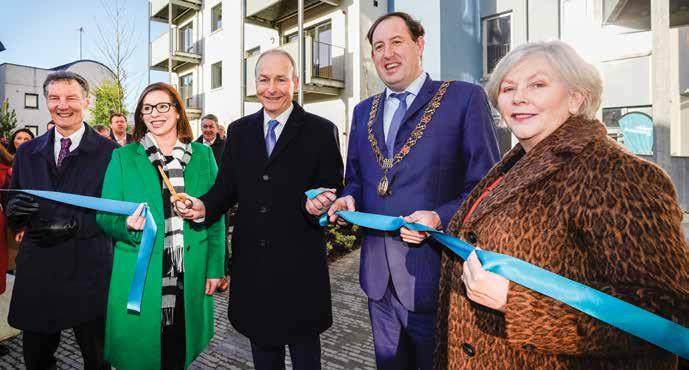
Established in 1994 by London-based St Pancras Housing Association, Clúid has adopted much of the ethos and values of the original organisation that, before setting up in Ireland, had built a reputation for providing quality homes for service people returning from the First World War. Clúid’s vision is a society where everyone has a great place to live and they are busy achieving that vision with the delivery of safe, secure homes that residents are proud to live in.
The not-for-profit organisation is now the country’s leading Approved Housing Body providing housing management services to over 29,000 residents across all counties of Ireland. Clúid has created 11,360 homes to date and is off to a flying start in 2024 with 89 homes delivered in January. Alongside its reputation for delivering social housing, Clúid can boast awards for its sustainable architecture, best-of-breed regeneration projects, housing management team excellence, collaboration initiatives, community integration and excellent customer service.
Eibhlin O Connor, herself an award winner, is Clúid’s newly appointed Chief Commercial Officer, having taken up the post in the second half of 2023 following 12 successful years at the organisation that began with a maternity cover as a development manager and progressed from there to Senior Architect and then Head of New Business. Eibhlin’s 26 years in the construction industry spans private, public and non-profit, giving her a unique perspective on the design and delivery of social housing and expert insight into what makes Clúid the foremost Approved Housing Body (AHB) in Ireland:
“We are a key player, we are different in the sense that we own the majority of our housing stock. We also have a mass construction programme, so where some AHBs would predominantly purchase off the market, between 50-60% of our

housing delivery is through construction.”
Clúid has a strong in-house ethic that allows it to take projects from feasibility through to handover via a highly skilled commercial development team that oversees the construction pipeline. This hands-on approach, which further differentiates Clúid, continues after hand-over as Eibhlin explains, “80% of our repairs are carried out by colleagues in Clúid Works, our national repairs team. We have a full team of tradespeople and they get to know the residents quite well and so they’re building relationships.”
Eibhlin’s first task in post was meeting Clúid’s end-of-year development targets which were exceeded with the delivery of 1,085 new homes in 2023. Her 2024 focus is on keeping the construction pipeline flowing whilst continuing to build an in-house centre of excellence that can rise to future challenges and deliver new homes using lean construction and sustainable housing principles.
“We have never had such a wealth of expertise,” enthuses Eibhlin, “When I came into the role I built Clúid’s design team. Engineers, architects, quantity surveyors, planners, building surveyors, valuers and so on, so that we have everything in the team to facilitate every aspect of the development process.”
This focus on collaborative working and a strive for excellence led Eibhlin to develop the first guidance document in an AHB that detailed the standards Clúid applied to housing construction. When going out to tender or entering into discussions with developers or local authorities, the guidance document allowed Clúid to share their vision of social housing standards upfront. The organisation went on to develop other guidelines, such as one specifically for agefriendly housing that applies universal design principles but dives into much deeper detail around such aspects as legislation, signage, colour coding and other elements that facilitate smooth, stress free living for people aged 55 and over.
Whilst Clúid’s in-house centre of excellence approach ensures that the organisation has strong oversight of a project from feasibility
through to handover, there is also an elemental belief that building strong partnerships is essential to success in meeting targets set by the Irish government in its Housing for All strategy. Eibhlin emphasises, “Collaboration with key partners is really important. Without our key stakeholders and partners, we just wouldn’t be able to deliver at scale.”
One key area of partnership is with Local Authorities to deliver under the Clúid Design and Build scheme. Local Authorities invite Approved Housing Bodies to bid for a particular development site in a procurement process that necessitates the AHB demonstrating how it will develop the site, in what timeframe and with what team. Eibhlin elaborates, “We would work through the planning process, the tender process and the construction process and complete the project and then we would manage it.” It’s a traditional process that relies on the Local Authority working closely with the AHB and giving them the opportunities to develop.
An example of this type of partnership is Clúid’s recently completed Green Lane development in Cork which was officially opened in January by the Tánaiste, Micheál Martin. The development, based on the site of the former Blackpool flats, provides permanent homes for around 150 residents across 112 apartments, including 36 which are age-friendly. Developing the site was a challenge, as Eibhlin describes, “We had Japanese Knotweed, culverts running through the site and a main fibre optic cable and the site was quite steep so it was really difficult. It was fantastic to see that development completed.”
Another key partnership is with the private sector under their Developer Design and Build scheme where Clúid runs a tender process for developers with ‘shovel ready’ sites that have planning permission in place. The developer gives a price for the construction and Clúid then seeks support for the development from the Local Authority. The Developer Design and Build scheme is an attractive one for developers who get a cash injection from the offset when Clúid purchases the site up front, negating the need for expensive bridging finance. The construction is then cash-rolled with stage payments, making it a low-risk venture for the developer.
Under this scheme, developers are armed with Clúid’s design
guidelines and then work closely with their in-house team on a detailed design that fulfils all the organisation’s requirements for construction. These partnerships with developers have proven very successful, delivering over 1,000 homes and resulting in much repeat business.
Clúid’s commitment to homes for all extends beyond new builds and into the regeneration of existing social housing. These tend to be fairly complex and difficult projects involving rundown housing where the communities are experiencing lowincome or unemployment, crime and antisocial behaviour and are in desperate need of being turned around.
St Mary’s Mansions, an apartment block built over 70 years ago by the Dublin Corporation, is a regeneration project that aligns with Clúid’s vision of a society where everyone has a great place to live. The site comprises 80 apartments for families and single people, with 20 families being former residents returning to the site and the remainder coming from Dublin City Council’s housing list. In addition to two new floors, the regeneration project included the creation of play areas, a community room, a central courtyard and socially aware landscaping. Eibhlin comments, “The implications of that are massive for the community, because it’s not just new homes, it’s how that impacts the broader community and sense of place.”

with physical or intellectual disabilities. The organisation has recently won a pilot government initiative for youth housing, in conjunction with Focus Ireland, which sees the first 20 properties being developed aimed at providing supported homes for vulnerable 18-year-olds coming out of a care environment.
Under the Irish government’s ambitious Housing for All strategy, Approved Housing Bodies are expected to deliver 40% of the overall social housing target, a total of 22,000 homes over the lifetime of the plan. This is a big challenge, but one that Clúid feels is achievable with lean construction and innovative ways of working.
The regeneration scheme showcased another partnership, the one between Clúid and the people who reside in the homes managed by the organisation. In the St Mary’s Mansions project residents were involved from the very beginning with one of the returning residents commenting in an article in Eolas magazine that: “It was really important being on board from day one for the first meeting with Clúid. With the residents being involved, we had our say.” One of the inputs from residents was a request to retain the external walkways that ran around the courtyard on each floor, linking the apartments in the old building. Clúid took the input on board, retaining the walkways with a modernised design, greatly pleasing the returning residents who felt they promoted a sense of community with households able to call across to each other with the latest news or invites for a cup of tea.
Eibhlin relays another practical example of where strong partnerships with the people who will live in Clúid homes deliver successful outcomes, “In one of our age-friendly communities we asked the residents, what would you change if you could? They all wanted a bathroom that opened into the bedroom but also opened into the hall. So they were like, I just want to be able to get to the bathroom easily if I have to get up in the night. So then we changed our design and now nearly every age-friendly independent living home has a bathroom right beside the bedroom.”
Clúid also recognises the strength of partnerships to deliver homes that meet the diverse needs of communities. By supplying the housing, managing the tenancies and entering into a Service Level Agreement, Clúid works in partnership with organisations such as the Irish Wheelchair Association, Sonas Services and St Michael’s House to support vulnerable sections of society such as homeless youth, survivors of domestic violence and residents
In another first for AHBs, Clúid has appointed an innovation partner to work alongside their in-house team of experts right from the feasibility and pre-planning stages. Eibhlin explains, “We’ve appointed GEM construction as our first innovation partner, and we’re delighted they’re aligned with us in their sustainability and design principles. They, as the builders, are the experts and they’re going to help us streamline the construction so that it is efficient and affordable for our residents to live there for life.”
A part of this innovative partnership process will be the development of an embodied carbon methodology and framework, to enable Clúid to demonstrate sustainability and meet their ESG requirements. Clúid is committed to environmental sustainability, launching its Greening Strategy in 2021 and becoming the first AHB to roll out biodiversity guidelines. In addition to being a thought leader in the sector on biodiversity in social housing at a macro level, Clúid’s horticulturist and landscape designer works with residents on a micro level on initiatives such as creating pollinator-friendly areas, rain gardens and planting pocket forests.
As part of its commitment to Ireland’s Climate Action Plan, Clúid’s new housing stock meets an A2 building energy rating and Clúid has an ambitious retrofit programme underway to bring its existing older stock to a B2 energy rating by 2030. At the end of 2023 over 1,800 properties have been retrofitted, with approximately 4,000 properties remaining.
Clúid’s biggest challenge in its future delivery of social housing is the restrictions placed upon its activities by gearing, the ratio of its debt to equity, and to remove that restriction it, along with the Irish Council for Social Housing and other AHBs, are lobbying government to reassess how the sector is funded.
Eibhlin is upbeat about the future, wrapping up by saying:
“We’re ready to deliver big multi-tenure developments of scale. We just need access to land and we need support from the government to resolve the challenge put forward by gearing. We’re open for business and we have our Developer Design and Build programme, so if any developers out there have a shovelready site, come talk to us!”


At CPAC Modular, we recognise the positive impact our modular buildings have on the learning environment.
Working to the highest ISO safety and quality standards, our team is fully committed to delivering compliant building solutions to meet the current and future needs of the education sector.
Using our extensive experience and LEAN principles throughout our business, we create modern sustainable spaces for teachers and pupils to thrive in.
Bright futures are built in our buildings.


The Construction Industry Federation has released the Modern Methods of Construction (MMC) Report which outlines the transformative potential of MMC in the Irish construction sector.

In 2016, the CIF established a Modern Methods of Construction (MMC) Working Group consisting of member companies from the Housing, Specialist M&E, Civil Engineering, Modular Manufacturers and General Contracting companies. The group is chaired by Martin Searson, CEO of Quality Positive Ltd, which supports engineering and construction firms in developing operational processes, digitalisation strategies and management systems.
In order to prepare the second in a planned trilogy of MMC reports, the MMC Group used the UK’s MMOC Definition Framework document as a baseline and the working group interviewed key industry stakeholders and subject matter experts (SME’s) involved in modularisation.
Published recently, the Modern Methods of Construction Report, focuses on identifying the key market requirements to drive further adoption and implementation on a broader scale for both domestic and export markets. It also looks at barriers to adoption.
The principal aim is to make construction as controllable as
manufacturing with the same cost and scheduling certainties, thus reducing variability in the fabrication and assembly process.
Emphasising the shift from construction to manufacturing and focussing on the best means of making the industry more predictable and efficient, the report highlights the challenges of traditional methods, including skills shortages and rising costs, and proposes a series of recommendations to drive MMC adoption.
Among its key proposals is the establishment of an MMC demonstration park supported by a research and innovation centre (Construction Technology Innovation Centre) and it also recommends creating testing facilities, advancing education and training, developing certification systems, and supporting DfMA installation.
When asked to name three key requirements for the MMC Demonstration Park and Construction Technology Innovation Centre, 28% of those interviewed by Searson and his team were keen to see some form of testing facility, particularly for fire, acoustic, structural, and thermal products. Twenty-seven per cent
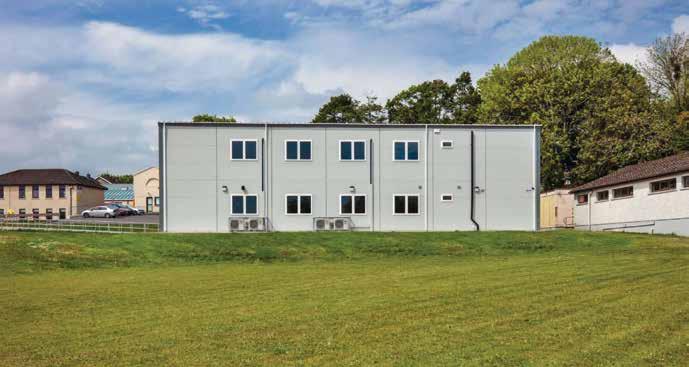
felt that education and training facilities were important for MMC to ensure Ireland stayed up to date on industry best practices.
Developing and supporting a ‘golden thread’ concept in standards, regulations and certifications was a high priority, with 23% of stakeholders stressing that this is a key requirement. While 13% and 9% spoke about building collaborative partnerships and developing a new procurement route and contract for MMC, respectively.
When asked to name the key drivers for the adoption of MMC, time to market and cost certainty came out on top, while sustainability didn’t really feature at this early stage.
The report also calls for a change in mindset, declaring that offsite construction should be prioritised as the primary strategy for delivering solutions to Ireland’s housing and building challenges. While Ireland faces volumetric challenges, increased client demand for MMC solutions offers promise, it says and stakeholders need to concentrate on providing testing facilities, education, and regulatory frameworks in order to advance MMC adoption.
The report stresses the need for upfront investment and collaborative partnerships in MMC contracts, with time-tomarket and cost certainty driving adoption. Skills development is paramount, and personnel trained in mechatronics, data analytics, and smart city development are urgently required. The industry must educate and train individuals across all levels to meet future demands.
The issue is not the quality of the work being delivered by the industry, rather it is the industry’s ability to maintain that standard in the face of growing skills shortages, rising materials costs, and the need to embed the principles of sustainability and circularity into future built environment projects.
While Ireland’s offsite manufacturing industry shows promise, sustained commitment and volume growth are essential for its growth and contribution to national goals. Ireland is a small market as it stands, but without a significant shift by clients to embrace MMC, there will be insufficient demand to support the nascent MMC supply-chain and sub-supply sectors.
In addition, with the emergence of new materials and accelerating product innovation, a crucial concern for the industry in Ireland is the lack of testing and certification facilities in certain key areas. For example, the fire testing facility in the Republic of Ireland is located on the Ulster University Jordanstown campus. However, since Brexit certification from UK bodies is no longer recognised in Ireland and companies now have to send products to Europe for certification.
In the event of significant changes in the technology or materials being used, they may need to be re-certified. The NSAI has recently published a Guide to Agrément certification for Modern Methods of Construction (MMC), which will be a useful resource for companies adopting OSM solutions.
The MMC Report underscores the transformative potential of MMC in the Irish construction sector. While challenge such as skills shortages and certification processes persist, the opportunities for growth and innovation are plentiful. By prioritising education, training, and collaborative partnerships, Ireland can harness the full potential of MMC to meet its national development objectives.
■ Establishment of an MMC demonstration park and research centre.
■ Creation of testing facilities for durability, acoustic, thermal, and structural properties.
■ Advancement of education and training in MMC-related skills.
■ Development of certification systems for standardization across sectors.
■ Collaboration between clients and the industry for upfront investment and risk-sharing.
■ Support of design for manufacture and assembly (DfMA) installation and management of follow-on trades and to build the necessary skills in sufficient numbers to meet national construction demands for MMC.
Joe Walsh, Managing Director of the Calnan Group discusses the company’s rich history, core values, performance, and future goals as well as the industry trends shaping its path to continued success.
For over half a century, the Calnan Group has been consistently setting new standards for innovation and excellence in the world of steel containers and modular construction.
Established by Jerry Calnan in 1973, the company’s sustained growth and success is a testament to the founder’s unwavering determination, passion for perfection, and commitment to delivering top-notch solutions to its customers.
As we move into 2024, the Calnan Group remains firmly focused on the future and according to Managing Director, Joe Walsh, the company is intent on continuing its growth and diversification for the next 50 years.
“Our commitment to customised design, manufacturing, and installation of steel containers and modular buildings, combined with our industry expertise, and quality products, has earned us a trusted reputation as an industry leader in the market. Today, the Calnan Group has cemented its status and expanded its offerings to meet the ever-changing demands of its diverse clientele.
“Calnan now encompasses eight distinct company divisions, each offering a range of products and services tailored to various industries and applications with both sale and hire options. Spanning anti-vandal steel cabins/containers, modular buildings, container sales, refurbishing (Re-New Division), bespoke living accommodations, welfare facilities, and specialised container solutions.
“We are now in a position to grow our public contracts division and other sectors of the business for the next 50 years,” he says.
“Essentially, our focus and mission remain the same as it was when our visionary founder
Jerry Calnan first established the business and that is to provide the highest quality bespoke containerised and modular solutions that meet the unique needs of our customers throughout Ireland and further afield.”
Operating across multiple sectors, the Calnan Group caters to construction, healthcare, agricultural, manufacturing, renewable energy, hospitality, tourism, film/TV production, petrochemical etc., and the public sector. Their clientele comprises international renewable energy contractors, government bodies, architects, engineers, and businesses seeking temporary or permanent accommodation solutions.
For over 50 years, Calnan is privileged to have been able to provide solutions to nearly every sector and industry. Their units have been exported worldwide from decontamination
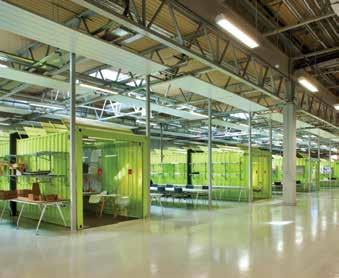
units to Chernobyl, support units for the United Nations Peace Keeping missions, realistic Fire Training towers for Firefighters as well as living accommodation units that can be installed anywhere in the world.
The Calnan Group would like to thank its team and customers for which none of this would be possible. Loyal customers over the years have allowed Calnan to expand its expertise and Jerry is glad to see that the same customers he dealt with in his early years remain loyal to Calnan. Joe Walsh also adds: “We are so proud of our team in Cork and Kells, who have really pulled together over the years, not only to deliver projects on time for clients that need a quick turnaround but for also looking out for each other during COVID and during other events such as recent floodings in Cork. We are a family-owned business and despite our staff growing close to 100 people, I am proud to say we are still a company that operates as one.”
With a legacy spanning over half a century, the Calnan Group has not only weathered industry storms but has consistently thrived. With an eye on the future, they’re poised to continue shaping industries, forging new partnerships, and advancing the cause of sustainability in Ireland and beyond. The company benefits from its recognised and respected brand status with a strong financial standing.
Quality is the commitment throughout the product range which ensures reliability and aligns with the company’s sustainability goals by reducing the need for frequent replacements. Meanwhile, innovation remains a cornerstone of the group’s strategy and new ideas and technologies are embraced to deliver premium solutions.



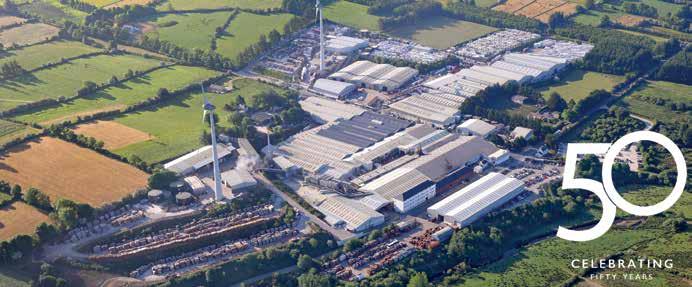
From small beginnings in 1973, supplying the local Munster market, the company has grown from strength to strength. It is now a leading supplier to Ireland, Northern Ireland and UK markets as well as supplying Passive House windows to the US market. Today windows and doors are manufactured at a 960,000 sq ft production facility in Ballydesmond Co. Cork and at a 360,000 sq ft facility in Warwickshire in the UK. The company employs more than 2700 people.
The company’s growth has been based on its commitment to meeting the needs of the consumer both in terms of service and product design and innovation. Providing an all in service, from on-site survey to installation and lifetime after sales service, together with the shortest lead times in the industry has proved to be a unique market offering. For homeowners, builders and construction professionals alike the impact of this on build efficiency is very welcome.
Over the decades the company has expanded its product ranges to embrace market trends and technological improvements. The product ranges available include uPVC, aluminium and AluClad, all in double glazed or triple glazed options. Today’s window is a far cry from the single glazed timber window which was the market leader 50 years ago. The modern window serves a myriad of functions providing
daylighting, thermal insulation, solar gain, ventilation, weather tightness, security, safety and structural stability.
Munster Joinery has risen to many challenges which faced the industry including recession, regulation changes, the energy crisis and climate change. The company has optimised the thermal performance of all their products. Munster Joinery offers the lowest U-value windows and doors available on the market with eight window systems certified by the Passive House Institute in Germany. Many energy excellent projects throughout Ireland, the UK and the US have used these products to achieve the Passive House dream.
As well as providing energy efficient products Munster Joinery is conscious of the need to do business sustainably. The firm’s operational energy needs are largely met by green solutions with 4.2 MW on site wind generation and a CHP plant capable of outputting 2.8 MW electrical and 12 MW thermal. A waste management programme is in place to reduce, reuse and recycle waste wherever possible with the aim of eliminating waste to landfill. Green Procurement practices are applied to source materials with low environmental impact.
While celebrating 50 years in business Munster Joinery looks forward to serving the ever changing needs of the consumer into the future.




An older building might have been built to the highest specs, and still be in good condition, but standards and practices have improved a great deal in recent years, so any building over a certain age is using - and losing - a great deal more energy than it should, at great cost to the environment, as well as the owner.
The answer is an upgrade, making it more comfortable, more economical, with lower ongoing maintenance for years to come. By retrofitting quality windows and doors, you will be improving the U-value, reducing heat loss and saving on energy costs. In short, windows and doors are an essential part of the retrofitting process, making a building as energy efficient as it possibly can be.
Whatever way you approach your retrofitting project you will need a window and door specialist with the resources, range, experience and expertise to give you the ideal windows and doors. Whatever style, colours and accessories you choose, your home will look exactly as you want it to look, while you enjoy the additional comfort - and lower bills.
Should you install double or triple glazing? Should you have the same throughout your house? Different window manufacturers will offer different specifications and different prices but how do you know which will deliver the best results for your home? With a network of expert dealers and installation teams across Ireland, Senator Windows are well placed to
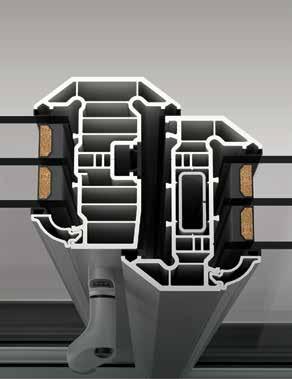
answer your questions and help you choose the ideal suite of windows and doors for your home, with energy saving performance among the best – if not THE best – in Ireland.
Since 1985, Wexford based Senator Windows has built a considerable reputation as Ireland’s most trusted and innovative manufacturer of windows and doors. That reputation continues to grow. Senator Windows - a member of the Gowan Group - employs 100 people and supports a dealer network of 120 Senator representatives across the country. Senator Windows is proud to be a trusted national brand, providing energy efficiency, warmth, security and value to customers, in a range of contemporary styles and colours. They are particularly proud of their impressive list of first-to-market innovations, which have earned recognition from prestigious national, EU and global standards bodies along the way.
In 2022, Senator launched its uPVC Passive and High Performance Window Range, crafted using the EnergyPlus90 window system, one of only a handful of window products able to comply with exacting Passive House standards and certified by Germany’s Passive House Institute as suitable for the Irish climate. Independent tests have resulted in EnergPlus90 achieving U-values as low as 0.71 W/m²K, for triple glazing and as low as 0.53 W/m²K with quadruple glazed windows.
Retro-fitting more energy efficient windows and doors in your home, an office or a rental property, is more than an exercise in energy conservation.
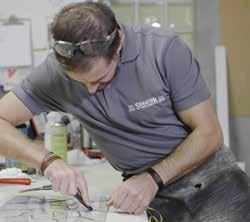
It’s an opportunity to re-imagine how the building looks and the experience of living or working within it. The result is a more comfortable environment and significantly reduced energy costs, savings that continue into the future, ensuring that your choice of elegant, efficient windows and doors will pay for themselves over and over again.
For more information about our aluminium and uPVC ranges and the address of your nearest Senator dealer, visit senatorwindows.ie

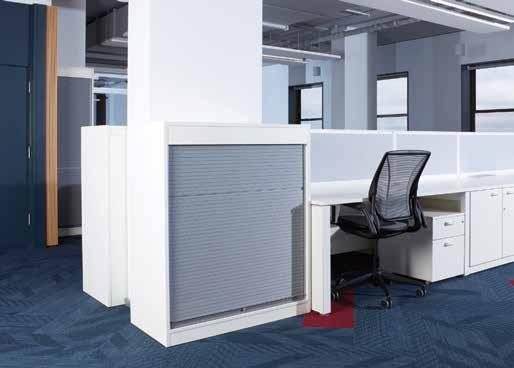
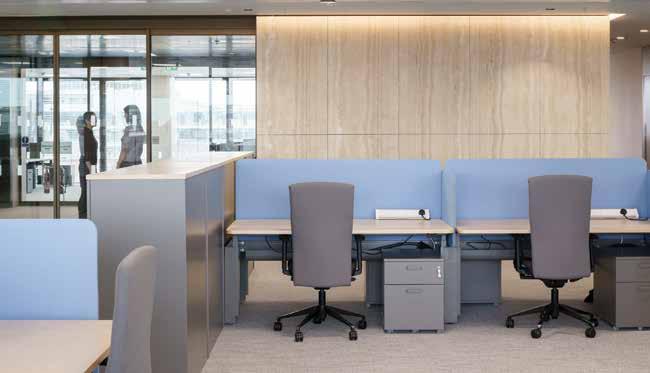
Founded in 1961 by brothers Ollie and Paddy Farrell, Farrell is now in its second generation, pairing innovation and tradition as furniture partners on the most ambitious commercial and residential projects across Ireland and the UK.
Now in the expert hands of Brendan and Paul Farrell, the company continues to adapt and evolve. Farrell employs around 120 people in Ardee and 8 in The UK.
“Throughout our 63 years in business, we have been faced with a series of challenges, including Brexit and the global pandemic. However the Farrell Family adaptability allowed us to not only survive during these times, but to flourish, expand and retain all of our staff” explained Paul Farrell, Joint-CEO.
In 2022, Farrell successfully applied to the Circuléire Innovation Fund to pilot a new strategic initiative called “Do More With Less”.
The collaboration project with the Office of Public Works and GMIT Letterfrack’s National Centre for Excellence in Furniture Design and Technology sees old furniture made by Farrell for the OPW decades ago taken back and given a second life.
The scheme allows Farrell to extend the useful life of furniture, and hopefully inspire others in the industry, academia and the public sector to rethink how we look at furniture.
While the company is continually embracing new ideas and initiatives, Farrell remains true to its roots in a service-focused environment with people at the core of the business.
While the firm started out as a jointly held passion between two brothers, today the team extends to over 100 top designers, crafters and manufacturers across Ireland and the UK.
Everyone on the team has one common aim – a commitment to doing things right every time for customers, partners and collaborators.
As an active member of the Forestry Stewardship Council (FSC), Farrell only uses FSC-certified wood, chipboard and MDF. It sources as much of its other materials locally where possible.
When working with veneers its designers opt for sustainable cherry and oak where possible, as opposed to over-forested mahogany and teak. They use solvent-free polishing and varnishing techniques.
From its state-of-the-art manufacturing facility in Co. Louth, Ireland to its dedicated in-country support teams, Farrell designs, manufactures, supplies and fits all of its furniture, building flexibility into its offerings to deliver solutions for today, and tomorrow.
“As a family-run business, we are passionate about the
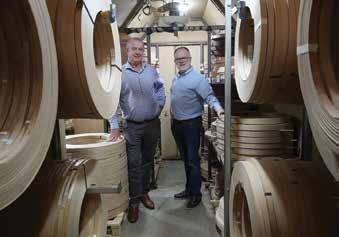
power of the personal touch. Growing up, furniture was a way of life for us” said Brendan Farrell, Joint-CEO.
By bringing timeless, tailor-made crafts to its customers at scale, the firm’s philosophy is to make furniture work better for everyone.
Farrell adheres to the Weee recycling scheme for electrical machinery and appliances, has installed energy-efficient LED lighting throughout, and uses wood waste and offcuts to generate heat. When required to use metals, it opts for aluminium rather than steel, as the former is easier to recycle. It uses low-emission glues during assembly and adopts lean principles throughout to reduce waste.
Farrell takes a proactive role in the communities it works in. The firm is a regular supporter of charity, not-for-profit and educational institution engagement in the community, locally in Ardee, Co. Louth, nationally in Ireland and in the localities and communities surrounding the UK office.
Farrell is also very proud to host the annual Conor Farrell Award for Excellence in Design. In memory of Conor Farrell, and his love for design and work in the furniture industry, the award seeks to give back to the new community of designers coming into the industry.
Farrell Furniture is dedicated to producing the finest furniture for commercial offices and contract residential spaces in Ireland and the UK.
This family run business successfully blends 63 years of expertise in the art of furniture making with modern scale and production capability. From its factory to the clients’ floor, Farrell Furniture delivers the highest quality products and solutions customised to its clients’ needs and spaces.
The Royal National Lifeboat Institution reaches a significant milestone serving coastal communities for 200 years.
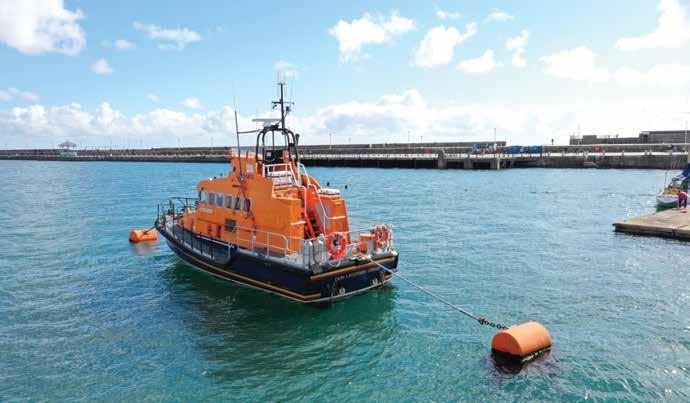
The RNLI (Royal National Lifeboat Institution) has a long and deep connection with the island of Ireland and maintains close ties with the Irish Coastguard.
2024 marks the 200th anniversary of the RNLI’s maritime rescue service. Events and celebrations throughout the UK and Ireland will be held to commemorate this significant milestone.
This volunteer-driven service remained in place following the creation of the Irish Free State in 1922 and the subsequent creation of the Republic of Ireland.
In the March 1926 issue of The Lifeboat Journal, an article on the roll-out of motor lifeboats reads:
‘This work in Ireland has not been affected by the political changes and the setting up of an Irish Free State Government with the status of a Dominion. At the express wish of this Government the Institution is continuing to maintain the Service in the Free State and Northern Ireland.’
Lifeboat stations throughout the island of Ireland have carried on saving lives under the RNLI banner since.
The RNLI’s presence in Ireland is deeply rooted in a legacy of selflessness and courage. The organization was founded in 1824 by Sir William Hillary, a philanthropist who recognized the need for a dedicated lifesaving service to combat the perilous conditions
of the Irish and British waters. Over the years, the RNLI has evolved into a modern, efficient, and highly trained institution that continues to be a crucial part of the Irish maritime landscape.
One of the most remarkable aspects of the RNLI is its reliance on volunteers. These everyday heroes come from diverse backgrounds but share a common goal – to save lives at sea. The volunteer crews, made up of people from all walks of life undergo rigorous training to operate the lifeboats and respond to emergencies effectively. This volunteer spirit adds a unique touch to the RNLI’s lifesaving mission, fostering a deep sense of community and camaraderie.
The RNLI in Ireland operates a diverse fleet of lifeboats, each designed and equipped to handle different sea conditions and rescue scenarios. From the powerful all-weather lifeboats to the nimble inshore lifeboats, the RNLI ensures that it has the right tools for the job. Cutting-edge technology, navigation systems, and safety equipment contribute to the efficiency and success of each rescue mission.
Operating in the dynamic environment of the Irish waters

The challenges posed by evolving sea conditions, climate change, and new technologies necessitate a forwardthinking approach, ensuring that the RNLI continues to be a beacon of hope for generations to come.
comes with its challenges. Unpredictable weather, treacherous coastlines, and the vastness of the sea present formidable obstacles to the RNLI’s lifesaving efforts. However, the organization has consistently demonstrated resilience and adaptability, pushing the boundaries of what is possible in maritime rescue.
The RNLI’s anniversary is a moment to celebrate the legacy of a humanitarian institution. What started as a simple mission to assist those in peril has evolved into an iconic, sophisticated and highly effective organization that stands at the forefront of maritime rescue globally.
Beyond the immediate lifesaving efforts, the RNLI has made a significant impact on coastal communities throughout Ireland and the United Kingdom. The anniversary serves as a reminder of the organization’s role in fostering community resilience, educating the public about water safety, and creating a sense of solidarity among those who call the coast their home.
As the RNLI celebrates its anniversary, it also looks towards the future. The organization remains committed to innovation,
training, and community engagement. The challenges posed by evolving sea conditions, climate change, and new technologies necessitate a forward-thinking approach, ensuring that the RNLI continues to be a beacon of hope for generations to come.
One of the initiatives launched to commemorate the event is the release of a collection of photos depicting iconic scenes and, community events and courageous crew. Featured in the collection is the most decorated RNLI lifesaver, Henry Blogg, who was born on 6 February 1876. Henry served for 53 years on Cromer’s lifeboats before retiring in 1947, having saved 873 lives and been awarded many honours including three Gold and four Silver RNLI Medals for Gallantry.
The RNLI’s anniversary is not just a marker of time but a celebration of resilience, compassion, and the indomitable spirit of those who dedicate their lives to saving others. As the organization looks back on its rich history and forward to the challenges ahead, the anniversary serves as a poignant reminder of the vital role the RNLI plays in safeguarding lives and ensuring the safety of those at sea. Here’s to the past, present, and future of the RNLI – a testament to the power of people and communities working together to make the seas safer for all.
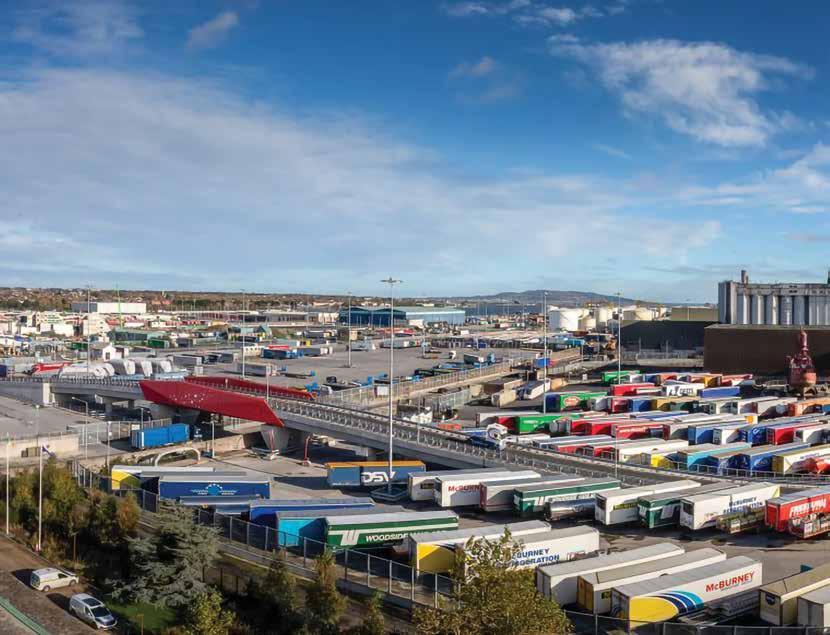
T4, a newly redeveloped RoRo freight terminal in Dublin Port costing €127m, is officially open for business.
Self-financed by Dublin Port Company (DPC) and delivered on time, and on budget, T4 marks a major milestone in the delivery of the ABR Project, the first of three major capital development projects under its Masterplan to futureproof Dublin Port’s cargo handling capacity to 2040.
T4 will handle more than 220,000 RoRo units annually, which equates to over one-fifth of all RoRo units at Dublin Port based on 2022 volumes and more RoRo freight per annum than any other port in the Republic of Ireland.
T4’s capacity comes from 4.1ha of existing port lands having been reconfigured, creating more efficient space for handling European and UK unaccompanied RoRo units. It comes into operation at a time of growing demand for unaccompanied RoRo freight services (goods on trailers transported by ferry without a driver) to and from the greater Dublin market post-Brexit.
T4 brings into operation 3km of new quay walls, upgrading Victorian-era port infrastructure to service direct routes between Dublin and Liverpool/Heysham by ferry operator Seatruck.
The work also involved the demolition of an old jetty, replaced with two best in class modern jetties of 270m each, that will accommodate the largest ferries measuring 240m in length and which have been future-proofed to allow for shore to ship power in the years ahead.
Importantly the development of T4 has also facilitated the closure of an entrance onto East Wall Road paving the way for DPC’s Liffey Tolka Greenway project on East Wall Road to commence construction in 2024. This will see the transformation of the East Wall Road with a new dedicated 1.4km cycle and pedestrian route which will eventually form part of the 16.5km of cycleway / walkway planned as part of the overall Masterplan.
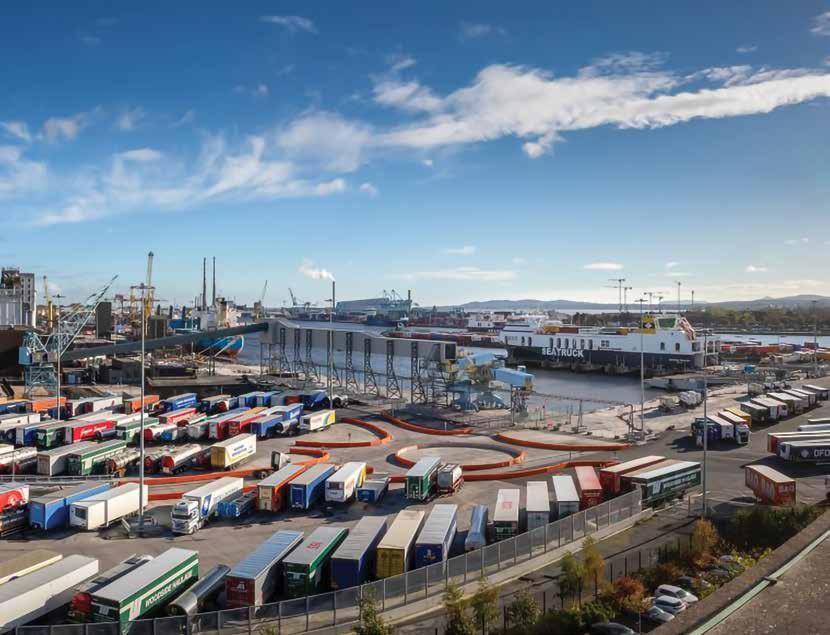
“T4 will handle more than 220,000 RoRo units annually, which equates to over one-fifth of all RoRo units at Dublin Port based on 2022 volumes and more RoRo freight per annum than any other port in the Republic of Ireland.”
It has also enabled the opening of a new transhipment route to Santander
Launching T4, Minister of State, Jack Chambers, TD said the opening of T4 represents another important step in DPCs journey to open up Dublin Port as a safe and accessible venue for all to enjoy.
“I am delighted to be on-site today for the opening of T4 and to see first-hand the world-class facilities that are in place at Dublin Port,” he said.
“Dublin Port is Ireland’s largest freight and passenger port handling approximately 51% of national tonnage. Its importance is even more pronounced in the unitised freight sector as it handles 71% of all Load-on/Load-off and 80% of all Roll-on/ Roll-off tonnage in and out of the country.
“In line with its Masterplan, Dublin Port has been progressing the necessary infrastructure to provide for increases in throughput. T4 will greatly enhance Roll-on/Rolloff capabilities at the Port.
“As an island nation, sufficient capacity and the efficient and seamless operation of our ports are indispensable for the success of Ireland’s importers and exporters.”
Barry O’Connell, Chief Executive of Dublin Port Company, said the new terminal will support the continued growth of Dublin city and the wider national economy.
“Dublin is already one of the most efficient ports in Europe. With T4, we are driving even more efficiencies and facilitating growing customer demand for direct shipping routes between Dublin, the UK and Europe.
“Even with T4 now fully in operation, Dublin is running at 91% average capacity and therefore it is imperative that our plans to complete all three of our Masterplan 2040 projects continue as planned.
“This will ensure we create the capacity needed to support the ongoing growth in the economy to 2040, while providing new public amenities that will support the growth of our city and neighbouring community for decades to come.”

PSM Dún Laoghaire Harbour is embarking on an exciting transformation that will pave the way for a vibrant and inclusive future. The Harbour Master Plan and the establishment of a National Watersports Campus will revolutionise the harbour, turning it from a traditionally industrial port into a people-focused space that benefits the entire community.
This transformation aligns with the town’s vision of becoming a premier maritime, tourism, and economic destination. These initiatives will not only enhance the harbour’s appeal but also contribute to the overall growth and prosperity of Dún Laoghaire and surrounding areas.
Under the leadership of Dún Laoghaire-Rathdown County Council, the Harbour Master Plan will aim to ensure the long-term financial sustainability of this historic port. Tim Ryan, Harbour Operations Manager, expressed his optimism and enthusiasm for the ambitious projects that will shape the landscape of the harbour and the town for years to come.
“The proposed Dún Laoghaire Harbour Masterplan will be a spatial plan, looking at what’s in place already in terms of
facilities and then filling in the gaps from there to ensure that the space it is being used efficiently and effectively” he explains.
The National Watersports Campus is the first major project in the plan, building on the success and reputation of Dún Laoghaire as a hub for sailing in Ireland. In the past, the watersports clubs, activity providers and sailing schools operated somewhat independently, resulting in a fragmented approach to water sports.
The National Watersports Campus will bring together these entities and implement a coordinated strategy, providing coordination, joint marketing, and the necessary additional facilities to support events and activities. One crucial addition will be an event management centre located on the Carlisle Pier. This centre will serve as an administrative hub for national governing bodies, fostering collaboration and shared resources. Furthermore, it will provide a dedicated space for hosting national and international water sports events, elevating the profile of Dún Laoghaire as a premier water sports destination.
The Watersports Campus also includes the construction of a new slipway on the east side of the Carlisle Pier, serving as
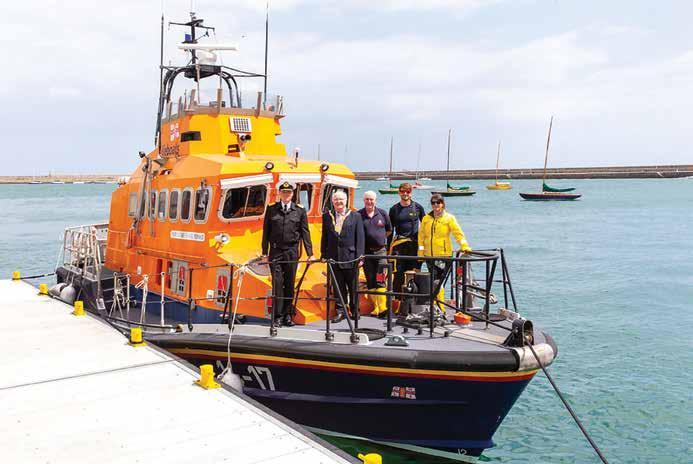
both an event slipway and an upgraded facility for the RNLI. This development will allow for the expansion of water sports events along the entire waterfront, ensuring accessibility and visibility for all residents and visitors. One of the primary areas of improvement includes a substantial increase in slipway spaces. Currently, the harbour only has one large slipway area, which experiences high demand, especially during the summer months when sailing schools and boat launches converge.
The plan includes the creation of apron slipways, offering designated spaces for families, akin to arriving at a beach. Parking facilities will be made available at the top of the slipway area, ensuring efficient provision between sailing schools, commercial entities, families and individuals.
The area behind the West Pier is being examined for the inclusion of water sports activities that are unsuitable within the harbour, such as kite surfing and windsurfing. Harnessing an under-utilised space, these initiatives will not only provide a safe environment for such sports but also position the campus as the premier water sports location in Ireland.
By offering a secure and welcoming area for individuals to learn and engage in water sports, Dún Laoghaire aims to stimulate interest and growth in all facets of these activities.
The proposed Harbour Masterplan encompasses the enhancement of several attractions within the harbour. For example, the East Pier battery has the potential to become a spectacular tourist magnet with the appropriate enhancements.
The primary goal is to promote and streamline access to the water, simplifying the process for locals and visitors alike. Significantly, the former ferry terminal area is now the focus of long-term development possibilities, such as a hotel or
conference centre.
In recent years, the harbour has accommodated a substantial number of cruise ships, bringing in over 127,000 passengers and 58,000 crew members in 2023 alone. After Covid and Brexit, Dublin Port was at full capacity and was not able to accommodate the levels of cruise visits and Dún Laoghaire Harbour has been able to facilitate them. This influx of visitors has generated much-needed funding for the harbour’s maintenance, particularly given the number of storms that have hit in recent times.
Dún Laoghaire has become the welcoming gateway to Ireland for many, and dedicated staff ensure that these tourists receive a positive and memorable experience. It is essential to highlight the array of local attractions to encourage visitors to explore beyond the city centre.
Collaborating closely with the Dún Laoghaire-Rathdown Tourism Office and the Economic Development Office, efforts are underway to maximise the benefits of the growing tourism numbers, diverting attention to renowned local attractions such as Dalkey Castle, the Maritime Museum, and the People’s Park.
The transformation of Dún Laoghaire Harbour into a more inclusive and popular destination is a testament to the dedication and commitment of the Dún Laoghaire Harbour staff team. After a period of decline in staff numbers, this revitalised team is wholeheartedly working towards creating a new future for the harbour. The plans in place ensure its continued importance and success moving forward.
“It’s very rewarding to witness this transformation of the harbour into a more inclusive and popular destination and the plans that we have in place should ensure its importance going forward,” concluded Ryan.
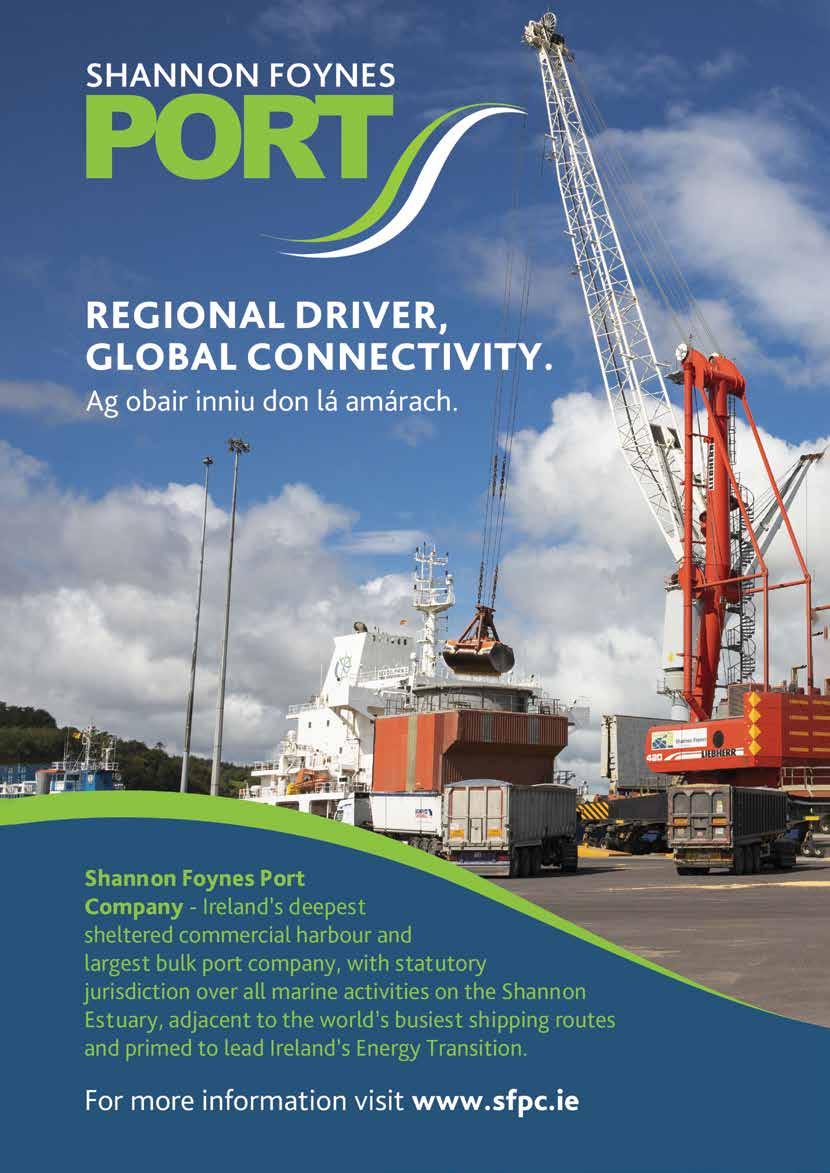


Cargo of a record-breaking scale was handled by the Port of Waterford over a weekend recently. A vessel load of 80 metrelong wide-turbine blades, the largest ever in size to be imported to Ireland were shipped to the Port of Waterford due to the Port’s expansive riverside space, ability to handle cargo of exceptional size and proximity to the motorway network.
The vessel, BBC Citrine 153m arrived from Turkey with the 80m long blades, which are the longest ever imported to Ireland, and also the longest in the UK, according to sources. The record-breaking exceptional loads of wind turbine blades were unloaded and are currently being stored at the Port. They will then be transported by road to their destination at Cushaling Wind Farm, Co. Offaly.
“Port of Waterford was chosen as it is the only port in Ireland capable of handling these long components, in addition, a second ship arrived with the tower section components for the same project,” Port of Waterford CEO David Sinnott said.
“While the Port of Waterford handed similar cargo in 2023 this is the first time that components of this scale were handled through an Irish Port.
“I would like to take this opportunity to thank the personnel here at the Port, again the team worked together to ensure smooth delivery. Thank you to the Port of Waterford marine, tug and mooring operatives, pilots, agents, stevedoring cargo handlers, South East Port Services and transport operators, Colletts Transport and Celtic Shipping; who are all playing an important role in the current and future provision of clean renewable energy to the national grid.
“The role that our national ports will play in the provision of offshore wind energy is a current topic and this particular project proves the important role that port teams are already providing in the creation of the current onshore wind energy
infrastructure.
“Port of Waterford is strategically positioned to support the future offshore wind energy sector and has currently proposed a 250m quay extension to further support this work and future growth in the sector while also recently applying for a Marine Area consent (MAC) to the Marine Area Regulatory Authority (MARA).
Here at Port of Waterford, we know that the proposed new facility and the proven expertise of the Port of Waterford team will ensure the further and future provision of even more clean renewable energy for our grid whilst also having a great economic impact on the entire South East region.”
Cushaling Wind Farm is being developed by Statkraft and will mark the first use of the Vestas V162-6.2 MW EnVentus turbines in the Irish market. The 9 turbines, which have a tip height of 185 metres and will be the largest on any wind farm in Ireland, will maximise the potential of the local wind energy resource. The nine-turbine development, which will deliver 55.8MW of urgently needed clean renewable energy to the grid, represents a €95 million investment by the company.
Belview Port is the centre of operations for the Port of Waterford. The port is served directly by the N29 and the N25, which provide direct connections to the M9 motorway. The port is also served directly by a rail connection, which provides the port with exclusive access to the national rail network.
Several organisations and teams were involved in the record-breaking project over the weekend from the Port of Waterford marine, tug and mooring operatives, pilots, and agents, stevedoring cargo handlers South East Port Services & transport operators, Colletts Transport and Celtic Shipping.
For further details see portofwaterford.com

Egis is a global consulting, engineering and operating firm with 18,000 employees across 100 countries. We create and operate intelligent infrastructure and buildings, capable of responding to the climate emergency, to help build a more balanced, sustainable future.
We have been active in Ireland since 1994; we ΄re one Ireland΄ s largest independent operators of infrastructure including the Dublin Tunnel, and some 470km of motorways. We were the designers of Dublin΄s first Luas.
In 2023 JB Barry and Partners became part of Egis.This alliance allows us to provide our clients with an unmatched end-to-end service – from idea to design to operation.
We work in intercity rail, bus, multi-modal transport corridors, active travel and light rail. In fact, we΄re involved in two out of every three major active light rail projects across the world.
www.egis-group.com

The strategic vision and sustainability initiatives guiding the ongoing evolution of Irish Rail will ensure that it continues to play a pivotal role in Ireland’s transportation landscape.

Established in 1987, Iarnród Éireann emerged amidst a backdrop of historical challenges, including a lack of investment and declining service quality. Widely criticised for its outdated infrastructure and poor customer service, Irish Rail faced an uphill battle in rebuilding its reputation and relevance. However, over the past two decades, significant improvements have been evident, with investments in new trains, upgraded facilities, and enhanced services signalling a brighter future.
Supported by the Government, which aims to strengthen urban train services and get cars off the road and backed by the tourism industry which is intent on create more opportunities in its sector and which acknowledges the vital importance of rail transport in encouraging visitors to travel within the country
Under the leadership of CEO Jim Meade, Irish Rail also unveiled its ambitious Strategy 2027, which charts a course for the future of rail transport in Ireland. Developed during the COVID-19 pandemic, this strategy emphasises the role of rail in postpandemic recovery and long-term national development. With a focus on improving customer confidence, enhancing safety, and expanding capacity, Strategy 2027 aligns with broader government initiatives aimed at sustainable growth and connectivity.
“We understand the key role Ireland’s railway will
play in helping to power the nation’s economic and social development towards a sustainable, inclusive and prosperous future,” Meade says.
“Iarnród Éireann, as Ireland’s public service railway, is ready and able to support recovery post COVID-19, while building for the longer term regional and national growth envisaged by Project Ireland 2040, leveraging our unique role in sustainably connecting people, communities, economies and businesses across the nation.”
Central to Irish Rail’s vision is its commitment to sustainability, both in terms of environmental impact and social responsibility. Through investments in electrification, new fleet acquisitions, and station accessibility enhancements, Irish Rail aims to reduce emissions, alleviate congestion, and promote compact growth. By aligning with national climate action targets and leveraging renewable energy sources, it seeks to position itself as a leading proponent of sustainable mobility in Ireland.
The Strategy outlines several key deliverables, including the electrification of the rail network, the expansion of freight services, and the strengthening of regional connectivity. By embracing new technologies and fostering partnerships with stakeholders, Irish Rail aims to create sustainable mobility hubs, facilitate goods transportation, and enhance the overall passenger experience.
With a focus on increasing capacity and performance, Irish Rail is striving to accommodate growing demand while also meeting the demanding targets for reductions in harmful emissions in Ireland’s Climate Action Plan, and in delivering the National Transport Authority’s transport strategy objectives.
Irish Rail’s strategic direction mirrors global trends in urban growth concentration, aligning with Project Ireland 2040’s vision to channel development into regional urban centres. Through transit-oriented development (TOD), Irish Rail integrates highcapacity public transport with mixed-use development, counteracting urban sprawl and promoting sustainable land use. By fostering vibrant communities around rail nodes, Irish Rail contributes to compact growth, reduced congestion, and enhanced connectivity, reflecting a global shift towards sustainable urbanization.

decarbonizing the rail network and promoting low-carbon transportation solutions. By embracing electrification and expanding rail freight services, Irish Rail contributes to Ireland’s climate action goals and establishes rail as a sustainable mobility solution for the future.
Key infrastructure projects such as the DART Underground and enhancements to InterCity services are pivotal in unlocking passenger growth and improving rail efficiency within the Greater Dublin Area (GDA). By increasing capacity and connectivity, these initiatives support compact growth along rail corridors, transforming stations into integrated hubs for residential and commercial activities.
CEO Jim Meade’s endorsement of Strategy 2027 underscores Irish Rail’s commitment to growth, sustainability, and transformation in rail travel, positioning the organization as a catalyst for urban development and environmental stewardship.
Continued investment in rail infrastructure is crucial for Irish Rail to accommodate future growth and maintain service levels and Transport Minister Eamon Ryan recently highlighted the potential for cost-effective rail line re-openings, emphasising strategic decision-making in infrastructure development.
Funding for Iarnród Éireann is provided under IMMAC and PSO contracts in line with EU regulations. Reduced levels of investment during the economic downturn led to a backlog of maintenance and renewal works. Higher levels of funding are now being provided towards addressing this backlog to support key pieces of network infrastructure including the National Train Control Centre (NTCC) and the Train Protection System (TPS).
In addition, Irish Rail is also continuing to address coastal erosion challenges through the East Coast Railway Infrastructure Protection Projects (ECRIPP), demonstrates its proactive approach to safeguarding critical rail assets, ensuring long-term resilience and connectivity in the face of climate change impacts.
Infrastructure Manager at IE, Eamonn Balance says that existing infrastructure must be future-proofed against the impacts of coastal erosion and flooding to ensure current and improved service levels are maintained: “The frequency of track washout, where the sea has eroded the land supporting the railway, along with wave overtopping onto the tracks, has increased in the last 20 years. These incidents have had significant impacts on performance and safety, as well as major losses of land and habitats.”
Electrification is a cornerstone of Irish Rail’s sustainability strategy, offering significant benefits in emissions reduction, journey time savings, and operational efficiency. Planned electrification initiatives, including InterCity routes and commuter lines, demonstrate Irish Rail’s commitment to
Irish Rail’s Strategy represents a transformative intervention in Ireland’s public transport landscape, supporting national development objectives and climate action priorities. By enhancing travel options, improving accessibility, and fostering sustainable growth, Irish Rail aims to contribute to the creation of a more resilient and inclusive society. Through strategic investments and collaborative efforts, Irish Rail seeks to realise its vision of a greener, more interconnected Ireland.
Jim Meade, CEO of IE extols the virtues of the IE Programme for the future: “Here at Iarnród Éireann, we believe that our Strategy 2027 is the strategy for growth, sustainability and transformation for all rail travel across Ireland.”
Irish Rail’s journey towards sustainability reflects a commitment to innovation, resilience, and societal progress. As it navigates towards a future defined by sustainability and inclusivity, it remains a vital catalyst for economic growth, environmental stewardship, and societal well-being in Ireland.
First All-Island Strategic Rail Review recommends electrification, new and enhanced routes, greater regional balance and improved speeds and frequency. If all the recommendations in this Review were delivered:
■ the rail network would be decarbonised
■ 700,000 more people would live within 5km of a railway station
■ rail journey times between some major cities could be halved
■ services on busiest intercity routes could run every 30 minutes in some cases
■ rail passenger numbers could double
■ 90% of aviation passengers could travel to the airport by rail
■ two thirds of freight tonnage would pass through ports served by rail
■ the island’s economy could be boosted by €20bn
Minister for Transport Eamon Ryan: Transport Minister Eamon Ryan recently highlighted the potential for cost-effective rail line re-openings, emphasising strategic decisionmaking in infrastructure development.



• Location: Based in Dublin, Serving Nationwide
• Stock Brands: Axalta, Axalta Percotop, Mipa, Catalfer, 3M, Mobihel
• All Industries Covered: Agricultural Machinery, Industrial Equipment, Floor Markings, Windows, Fences, Bus or Lorry Fleet, Alloy Wheels, Helicopters, trains and earthmoving equipment
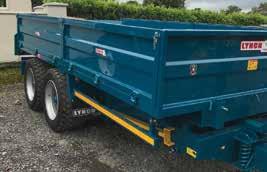
• Tailored Systems for Your Needs:
• Durable Coatings
• Weather Resistance
• Chemical resistant
• Gloss Retention
• Wet on Wet (WOW) Capability
• More Energy Efficient
• Lower Drying Temperatures Required
Why Choose BDM Coatings?
• Expertise: Over 50 Years of Industry Experience
• Nationwide Delivery: Efficient Service to Your Doorstep
• Wide Range: Stocking Trusted Brands
• Tailored Solutions: Customized Systems for Your Specific Needs
• Product Versatility: From Agricultural to Aviation
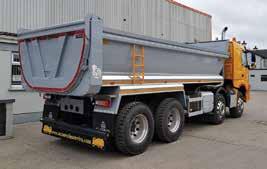
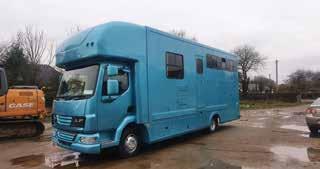
Given the level of investment planned for Ireland’s public transport system, it is vital that we deliver innovative, effective and long-lasting solutions with rail playing a central role, says Steve Preece, CEO of Egis in Ireland.
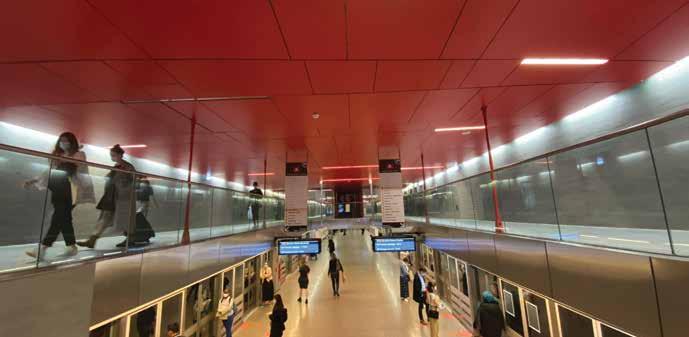
How to convince more people to use public transport? Develop the infrastructure and they will come. Or, at least, they will if you deliver the right infrastructure and ensure it is managed and operated in a way that works for everyone.
We all know the crucial role public transport can play in ensuring a sustainable future. Amid the urgent need to reduce our impact on the environment and achieve our climate targets, it is clearly the most efficient, effective, and inclusive option.
Public transport is proven to deliver social value. It serves as the enabler of a wider connectivity system, facilitating the creation of accessible, permeable cities and towns where multiple transport modes including walking and cycling can be enjoyed by more people.
At Egis, we know that public transport is vital to enable economic growth while reducing emissions and protecting biodiversity. We also know that upgrading or delivering new infrastructure is just the starting point.
As one of the world’s leading planning, engineering, consulting and operating firms, we believe that the local, regional and national changes required in many countries, including Ireland, can best be delivered by those with
global experience of building bigger and better. The climate emergency demands a systemic response that meets the needs of communities, industry, and the planet. This requires the broadest of vision and the highest levels of experience, expertise, and innovation.
The Irish government is pledging €35 billion in capital investment in sustainable transport up to 2030. This is a significant commitment and will help to meet the CAP 23 target of a 50% reduction in carbon emissions from transport by 2030. The planned solutions must be both intelligent and adaptive to connect communities, encourage sustainable growth, and stand the test of time.
With operations in over 120 countries and a workforce of over 18,000 highly experienced professionals, Egis designs and operates rail, bus, and active transport systems in addition to water and energy infrastructure, buildings, structures, and roads.
We have been involved in some of the world’s most transformative public transport projects and this has allowed us to fully appreciate the impact quality rail services can have – as the central spine in transport networks.
Our deep insight and high level of expertise comes from
the end-to-end service we provide throughout a project’s lifecycle; from feasibility studies and needs analysis, through preliminary design, planning, tender and project management to construction supervision, project commissioning and handover. Meanwhile – and in a point of difference from our peers - we bring considerable expertise in the ongoing operation & maintenance of infrastructural assets to our designs.
In France, where Egis is headquartered, we have a 50-yearold history and particular expertise in rail, metro and tramway projects. The Grand Paris Express, for example, is a new automated metro system for the Greater Paris region covering 200km with four new lines and 68 stations. We are project managing the civil engineering of tunnels and stations and the delivery of key infrastructure on several sections of the system itself, spanning 35km and ten stations. Meanwhile, we recently completed the development and implementation of a strategy for the management of Toulouse’s transport systems.
Our results at home mean our experience is valued across the world. In Doha in Qatar for example, we project managed the delivery of a four line, 76km metro track of which 55km is underground. We’re also partners in a PPP contract to operate and maintain the automated Metro in Thessaloniki in Greece.
In Ireland, Egis has been active since 1994 with the business now involving 600 people across 16 offices nationwide. Our work includes designing, operating, and maintaining railway, roads and mobility services as well as designing transport structures – bridges, ports and tunnels. We operate and maintain 470 kilometres of motorway and 5.8km of tunnels, including the Dublin Tunnel
In public transport, we are involved in intercity and light rail, bus, and active travel. We designed Dublin’s first Luas, for example, and we are now completing the planning stage for the Luas extension to Finglas with TII. We are also currently designing the National Train Control Centre and upgrading signalling and train protection systems on behalf of Irish Rail, improving network safety along 2,400km of the rail network.
In Cork, we are partners with Irish Rail in the delivery of the signalling and communications solution for the Cork Area Commuter Rail. This project is another example of where our global experience is matched by local knowledge. We recently acquired JB Barry & Partners, in an alliance that broadened the expertise and services we offer. JB Barry undertakes a mix of projects including the development of the N/M20 Cork to Limerick multimodal transport corridor, and the N22 Baile Bhuirne to Macroom bypass.
In developing and improving rail services, Ireland can apply methods and systems tried and tested elsewhere. It is critical, for example, for more of our intercity lines to be electrified, to help de-carbonise the heavy rail network, reduce journey times, increase the frequency of services and reduce operating costs. About 10% of the existing rail lines in the country are electrified, but in France this figure would be closer to 80%.
Improving rail services on their own, however, is not enough. We need to ensure we are delivering integrated public transport in our cities and towns to promote modal shift.
Transport corridors must connect with hubs including everything from park and ride to bus services, walkways, cycleways and wellbeing facilities. Where we are designing new roads, we now provide for cycling and walking options that can

ease congestion, improve air quality, and support better lifestyles.
The scale of the task may seem daunting at times, but the opportunities are immense and, as Egis in Ireland and across the world has shown, delivery at scale is possible.
To maximise the potential of the planned investment in public transport for Ireland, it is also vital that stakeholders, including the wider public, are given the chance to buy-in to what will amount to significant changes. At Egis we know that winning approval for new public transport systems requires community engagement, and we have significant experience of ensuring this need is met.
We also know the importance of leading when it comes to change. That is why we are doing everything we can as an organisation to respond to the climate emergency. Our vision and ambitions for Ireland’s response to this most pressing issue is matched by our own commitments. We aim to achieve net zero in our operations by 2050 and, in supporting clients, we report annually on the percentage of our turnover engaged in projects which enable energy and ecological transition – it is currently 45%.
In Ireland this translates into significant investment in understanding the impact of every design and operational decision in every single project we undertake in terms of embedded and operational carbon. In many cases we do this in line with regulations, but just like the provision of better public transport, we know it’s also just the right thing to do.
BDM Coatings - Transforming Industries with innovative, sustainable, and aesthetically pleasing Coating Solutions.
BDM Coatings Limited, founded in 2019 and based in Dublin 12, is a leading supplier of industrial coatings with over 50 years of collective industry experience. The company is dedicated to providing innovative, sustainable, and aesthetically pleasing coating solutions to a diverse range of industries, with a focus on excellent customer service and environmental responsibility.
BDM Coatings is dedicated to delivering cutting-edge, sustainable, and visually appealing coating solutions across a broad spectrum of industries. The company has established itself as a trusted partner for businesses seeking advanced surface protection solutions.
At BDM Coatings, the mission is to deliver cutting-edge coating technologies that not only meet but exceed industry standards. The firm is committed to providing sustainable and durable solutions that contribute to the longevity and performance of various surfaces.
BDM Coatings caters to a diverse range of industries, including agriculture, automotive, commercial vehicles, buses, trucks, and trains. With an unwavering commitment to innovation, the company aims to provide nationwide solutions that optimize time, labour, and energy efficiency.
Leveraging cutting-edge technology, BDM Coatings ensures accurate colour matching, allowing for a seamless workflow and preventing avoidable delays. This commitment to precision is a testament to the company’s dedication to providing products that exceed customer expectations.
Working alongside industry giants such as Axalta, Mipa, 3M, Catalfer, and Mobihel. BDM Coatings aligns with brands that emphasize research and development, ensuring access to the latest advancements in industrial coatings. The company actively listens to customer needs, integrating them with the latest industry innovations.
BDM Coatings recently moved to a new premises, underscoring its commitment to the health and safety of staff and products. The company collaborates with brands that share a vision for sustainability, focusing on eco-friendly raw materials and energy-efficient coatings that cure at lower temperatures, reducing the carbon footprint.
BDM Coatings offers a comprehensive range of coatings including coatings for outbuildings, roofs and cladding. Whether for line marking paints or heavy-duty areas, the company delivers solutions that cater to diverse needs within the construction and earth-moving equipment industry.
Managing Director, David Dempsey emphasizes the company’s mission to be labour, cost, and time productive. “We want to keep things simple for our customers, saving them time in prep, colour matching, and inventory control. We aim to offer

customers a quicker process time, saving their business revenue and increasing productivity.”
BDM Coatings ensures fast delivery to small businesses, recognizing the importance of timely access to quality coatings. The company remains dedicated to working alongside customers to design coating systems that meet their criteria for performance, efficiency, appearance, and life cycle.
BDM Coatings is also committed to social responsibility, exemplified by its strong support for local GAA clubs, with a special focus on ladies’ Gaelic football. Witnessing the transformative impact on communities, the firm prioritizes fostering positive change through sports sponsorships.
“With BDM Coatings, it’s about more than paint. We want to work alongside our customers to design a coating system that works for them and meets their criteria for performance, efficiency, appearance, and life cycle. We listen to what our customers want and aim to exceed their expectations with exceptional products and unrivalled customer support,” Dempsey concludes.
“Celebrating more than paint, at BDM Coatings, we envision products and services that go beyond expectations. Our goal is to make our customers’ experiences labour-efficient, cost-effective, and time-productive. We keep things simple, save time in prep, colour matching, and inventory control, reducing the need for jobs to be redone. We strive to offer quicker process times, saving our customers’ business revenue and increasing overall productivity. Our commitment goes beyond the surface – we’re here to design coating systems that meet our customers’ criteria for performance, efficiency, appearance, and life cycle.”
In summary, BDM Coatings Limited is a dynamic company with a strong foundation, leveraging extensive industry experience, cutting-edge technology, and a commitment to sustainability to provide top-tier industrial coating solutions across diverse sectors.

